
- COVID-19 COVERAGE
- CALL FOR SUBMISSIONS
- PRE-PRODUCTION
- POST-PRODUCTION
- BEHIND THE SCENES
- SG FILM RESOURCES
- 100 SECONDS ON THE RED SOFA
- SEE WHAT SEE?!
- @HELLOMRCAMERA
- PRODUCTION DIARIES
- RYAN’S STREAMING TIPS
- Digital Cinema Package (DCP) Creation Services
- PROJECT CONSULTANCY & EVENT MANAGEMENT
- LIVESTREAM SOLUTIONS
- SINEMA SHOWOFF!
- SINEMA FIRESIDE CHATS
- ADVERTISE WITH US
- THE INCITING INCIDENT: COMEDY
- THE INCITING INCIDENT: ROMANCE
- THE INCITING INCIDENT: DRAMA
- THE INCITING INCIDENT: HORROR
- THE INCITING INCIDENT: LIGHTNING ROUND #01
- PATRICK’S BEST OF ASIAN CINEMA
- STEFAN SAYS SO
- SINEMA OLD SCHOOL

Psychosinematics: A Psychological Breakdown of the Magic of ‘Spirited Away’ 9 min read
Psychosinematics is a series where we look into films and characters with a psychological perspective. In this installment, we look into Chihiro’s mind and journey as the hero.
There’s something about Hayao Miyazaki’s films that makes it so comforting and relatable despite their fantastical quality. Spirited Away is one of Studio Ghibli’s most beloved films, often enjoyed with a child-like wonder. But just as Spirited Away taps into our innocent sentiments, so too it explores deeper themes hidden in plain sight. In fact, Spirited Away is a trove of psychological insights. The relatability of these psychological experiences that Miyazaki draws on not only explains our affinity for his films, but also imparts a few comforting lessons.
Spirited Away tells the story of Chihiro, who is on a mission to save her parents after they are turned into pigs. Chihiro ends up working for Yubaba, an evil witch and the proprietor of the Aburaya bathhouse. Yubaba’s employees are bound to work in the bathhouse until they’re able to remember their real names. The bathhouse accommodates a throng of spirits ( kami) , both good and evil, based on the Japanese Shinto folklore.
Like many of Miyazaki’s films, a major theme in Spirited Away is a child’s symbolic journey into the world of adulthood. If we take a psychological view, the film can be read as a manifestation of Chihiro’s unconscious as she navigates the cold and frantic world of adulthood.
The unconscious mind is basically the part of the mind that contains underlying feelings, thoughts and urges that influence conscious behaviour and emotions. Psychologist C.G. Jung determined the idea of archetypes. They’re symbolic images and thoughts that represent our psychology, manifested in dreams, literature or art.
Spirited Away is rich in these archetypes and symbolism, reflecting Chihiro’s growth and the subconscious workings of her psyche. Let’s take a look at some of the psychological revelations in the film.
(Spoilers for Spirited Away!)
The Divine Child Archetype
According to Jung, the child hero archetype represents one’s journey to deal with growing up. The divine child archetype is a child with extraordinary potential and is often the protagonist in myths and legends.
In Spirited Away, Chihiro is the divine child. As she crosses the threshold into the spiritual realm, Chihiro is suddenly thrust into the adult world. Yubaba’s bathhouse is the symbol for this, with the hustle and bustle of the workers reminiscent of our own society. Chihiro struggles to figure her way around the bathhouse and the spirits, and to keep up with what’s needed of her.
The divine child is often described as “smaller than small yet bigger than big”. What this means is that as a child, Chihiro is inexperienced and naive. Yet the divine child possesses a potential that sets her apart as the hero.
Chihiro fits this archetype perfectly. The other spirits working in the bathhouse are harsh towards her because she’s human, receiving little kindness from others except for Haku, Yubaba’s apprentice, and Lin, a worker in the batthouse. She’s given difficult tasks, yet she puts on a strong face, because the only way she can save her parents is to follow Yubaba’s wishes.
When the stink spirit (Okusare) enters the bathhouse, Yubaba throws the responsibility to take care of him to Chihiro, while everyone else just stands around to watch her. Eager to please Yubaba, Chihiro tackles this hurdle head on in spite of her inexperience, to the surprise of everyone.
But she is still just a child. We often see Chihiro holding her tears in or crying her secret as she attempts to manage her responsibilities and her feelings.
When Chihiro suddenly bursts into tears while she eats, Jung would consider this as her unconscious emotions rising to the surface. She’s been too busy to meet everyone’s expectations of her that she hasn’t had the chance to even feel sad or process her emotions.
This is particularly moving, as Miyazaki exposes a universal human weakness that everyone can relate to at some point.
Subconsciously, these feelings that come with growing up are manifested in different ways. For Chihiro, they’re reflected through Yubaba’s bathhouse.
The Spirit Archetype
Now let’s look at an obvious element of Chihiro’s journey. Jung describes the spirit archetype as both helpful and evil energies that prompt the hero towards her purpose. The spirit archetype represents the contradictions and complexities of Chihiro’s psyche, which promote achieving “higher consciousness”.
The spirit archetype is usually involved in psychic transformations of the hero. It’s interesting to note that Yubaba is reminiscent of other mythical spirits. When Yubaba turns into her half-bird form, she looks like a harpy. Harpies in greek mythology are fearsome half-bird, half-human hybrids, who steal food and people.
Yubaba steals Chihiro’s name and calls her Sen, stripping Chihiro of her identity. This is similar to the psychological idea of diminution of personality, which means that one’s personality undergoes a drastic change. But this eventually ends with a transformation, kind of like a rebirth.
By the time she recovers her real name and is set free, Chihiro is now victorious. She has grown from a fearful child to the hero of her own psyche.
Yubaba is also similar to Baba Yaga, an evil witch in Slavic mythology. This evil witch is often sinister, but is sometimes seen as a benefactor to the hero’s cause. Like Jung’s description of the spirit archetype, she forces the hero to face the issue. Yubaba triggers Chihiro’s growth into adulthood by throwing challenges at the child hero.
While Yubaba is the embodiment of an evil spirit, Haku is the nurturing soul that supports the hero throughout her mission. Miyazaki alludes to Shinto folklore, where the dragon kami represents protection and loyalty.
A Hero’s Triumph
Chihiro overcomes her “mere human status” that everyone initially disregards her for, and not only succeeds in her mission to save her parents, but also becomes everyone’s saviour. Symbolically, Chihiro has overcome her unconscious emotions and fears, and has attained a higher consciousness that sets her apart from everyone else.
The world of Spirited Away is essentially a look into Chihiro’s psyche, as she evolves into her independence and the difficulties that come with growing up.
In the beginning, she feared entering the cave and crossing into the world of the kami. But by the end, she looks at that world longingly.
A comparison of the ending scene of the film to the opening reveals her growth from a child to a hero. Watching Chihiro’s journey gives us an insight into our own. And with this psychological view, it’s comforting to know that the challenges thrown our way is something everyone must contend with in our own ways.
“The hero’s main feat is to overcome the monster of darkness: it is the long-hoped-for and expected triumph of consciousness over the unconscious.” C.G. Jung
The beauty of Spirited Away is in its universality despite the fantastical atmosphere. Like Chihiro, we have all experienced some kind of subconscious transformation accompanied by challenges. Miyazaki’s film shows us the necessity of leaving our childhood behind, but also reminds us that the child hero will always live within us.
Spirited Away is now (finally) available for streaming on Netflix .
– Psychosinematics: An Introspection of ‘Baahubali’s’ Queen Sivagami
– A Masterclass in Animation Storytelling, MY NEIGHBOR TOTORO となりのトトロ Continues to Beguile Audiences 30 Years On
Share this:
Judith Ramirez
Movie Reviews
Tv/streaming, collections, great movies, chaz's journal, contributors, chihiro's journey: analyzing "spirited away".

In July 2012, Roger wrote about viewing “ Spirited Away ” for a third time and how he was then “ struck by a quality between generosity and love. ” It was during that viewing he “ began to focus on the elements in the picture that didn’t need to be there. ” Recently, I was re-reading that essay as I was watching the Blu-ray of "Spirited Away" three times (Japanese, English dub and back to Japanese) back-to-back-to-back.
Suddenly, I was struck by the visual cues Hayao Miyazaki presents in the beginning of the film that set up the character of Chihiro before she becomes Sen. I called it my A-ha moment.
Chihiro has been characterized as whiny, but I think if you understand her situation and contrast her intuitiveness with her parents' obliviousness, she seems less so. In the real world before she becomes Sen, there is no doubt she is a bit sullen. Not unlike Riley in Pixar's " Inside Out ," she's unhappy with being forced to move away from her friends. Her friends have given her a nice bouquet. If there are five stages of loss and grief (denial/isolation, anger, bargaining, depression and acceptance), then Chihiro is at the end of denial, and her comment about how unfortunate it is to get her first bouquet as a farewell gift indicates she is entering anger.

When her father, Akio, takes the rural street that leads them to what looks like an old unused amusement park, Chihiro picks up cues that her parents do not. She's troubled and a bit frightened by the moss-covered stone statues. Something about them makes her anxious. In this respect, she is not unlike Lucy Pevensie from "The Chronicles of Narnia." Narnia is closed off from children when they reach a certain age in the real world (until death returns Lucy, Edmund, Peter, Digory and Polly). Lucy is the most intuitive of the four Pevensies although she too has a moment of envy that signals she won't be able to return. Chihiro at ten is still more child than adult and thus more intuitive than her parents.
If we consider that Chihiro senses something is wrong, then her pleading with her parents not to enter the tunnel seem less whiny. She becomes Cassandra, a prophet whose warnings go unheeded. Out on the other side, there is a grass meadow and more stone statues. Chihiro's anxiety over the statues isn't the last bit of foreshadowing that Miyazaki provides visually.
In the following scenes, Miyazaki exploits the visual nature of the Japanese language. Japanese is not like English. Instead of an alphabet, it uses two syllabary systems and Chinese characters. The syllabary systems, hiragana and katakana, originated from Chinese characters, but are used to represent syllables. Hiragana is used for post-positionals and parts of words not fully expressed by Chinese characters (such as inflections for verbs and adjectives). Katakana is used for foreign words and onomatopoeia. Chinese characters often symbolize concrete things. Japanese poetry is filled with wordplay and the following scenes are filled with visual cues and words that can have double meanings.

On the first building we see an incomplete phrase. Alone the character 正 would be read "sho" or "sei" and means right, righteous, justice and genuine, but 正 also suggests 正しい, meaning correct, right, honest and truthful. There's more signs on the shops in the main road. At first casual glance as we go by, it does seem like they are all part of advertising for restaurants, but on closer examination, that proves not to be true.

When we get to the main street we see the characters 市場 for market (ichiba) and the word 自由 (jiyuu) for freedom. Then there are some disquieting Chinese characters. The mother says that all the places are restaurants. When you see 天 float by you might think 天ぷら (for tempura), but actually the characters are: 天祖 (tensoo) for the ancestral goddess of the sun, Amaterasu. In one frame we see only 天狗 (tengu), with "ten" above and "gu" below. The character 狗 means dog, but can be used for dog meat (狗肉)which is not commonly eaten in Japan (and could suggest the homophone 苦肉 or "kuniku," which literally means bitter meat meaning a countermeasure that requires personal sacrifice. The character usually used for dog is 犬. Tengu, however, or heavenly dog, a legendary creature or supernatural being (yookai) that can be either harbingers of war or protective spirits of the mountains and forests.
Floating at the corner of one building is 骨 which means bone and it could be a restaurant term as in the creamy broth: 豚骨 (tonkotsu) which is literally pig bone. Yet bone or "hone" is used in idiomatic phrases such as hone-nashi meaning to lack moral backbone.

Some of the Chinese characters are just a little off, enough to make you think. Most obviously is the one syllabary and one Chinese character that are written backwards when we look above at the arch. The characters are 飢と食と会 which seem to substitute for 飢える (ueru, to starve), 食べる(taberu, to eat) and 会う(au, to meet). The と signifies "and." It should read eat ( 食べる), drink (飲む) and meet (会う) or something like that, but the last two symbols are backwards on either side. Looking at these, perhaps Chihiro senses something is wrong.

Further, right before the father Akio turns down a small alleyway, he is framed by the characters for heaven on the left side of the screen and on the right side for devil. Soon after, what he sees is, especially in Japan, a supernaturally large buffet. While he assures Chihiro that he can pay for the feast and we remember he did have that foreign car, a Japanese person might be quickly calculating in their minds the exorbitant cost.

Chihiro briefly leaves her parents and above her head flashes a sign that reminds us both of family, pigs and death. The character 冢 (tsuka) means hill or mound. Yet this is not the preferred character which would be 塚 (also read tsuka). The small cross represents ground or earth. Without that radical, 冢 is only one stroke different than the word for house 家 (uchi) which is the same one used for the Chinese character combination that means family 家族 (kazoku). The significance here is that pig (豚 or buta) under a roof represents house/home 家. That quick flash of this character gives the suggestion of pig and family. Yet it is also like bone (骨 or hone) associated with death as in grave (冢穴).
This character 冢 (tsuka) seems to foreshadow the transformation of her parents into pigs and her journey to figure out how to save her parents from death. The more she sees of this amusement park, the more frightened she becomes. There's an expensive public bathhouse at the end of the pathway and all the lamps seems to be associated with it, but where are the people? Where are the vacationers, the retired old people and the middle-aged women on retreat? Where are the vendors, pushing you to buy anything and everything because everyone must return home with presents (omiyage) for their neighbors, co-workers and relatives. Anyone who has been on the trail to great temples or been on a hot springs tour will know that for such a grand feast and for such a splendid public bathhouse, these scenes are much too quiet.
Chihiro runs back, perhaps to warn her parents only to find her parents have been transformed into hogs.
The movie is called "Sen to Chihiro no Kamikakushi" (千と千尋の神隠し). Sen means a thousand, but the pronunciation of the character can change to "chi" as it does in the name Chihiro. The "hiro" in Chihiro means to ask questions. Kamikakushi means spirited away with kami meaning spirit or god and kakushi meaning hidden. So perhaps we can translate the title as "Sen and the Mysterious Disappearance of Chihiro."
"Spirited Away" was released in in July 2001. Most Studio Ghibli movies were released in July, and in Japan, I feel this is especially significant in the case of "Spirited Away" and " When Marnie Was There " because it is the Obon season, a time when Japanese believe the spirits of their ancestors walk the earth and return to their furusato (hometown). That time period (mid-July to August) is, much like New Year's week, a hard time to get things done in Japan due to the various celebrations and the people who leave on vacation. We do learn later in the movie that the character on the first building, 正, is part of a combination 正月 which we translate to mean New Year.
Although Roger didn't read or speak Japanese, he saw the rich detail. This is one of those movies worthy of a frame-by-frame analysis. For the people who read Japanese, some of what I have written above may have been intuitively realized. There are other things I still wonder about such as the prominence of the Japanese syllables of “me” and “yu” throughout. I’ve read one theory that put together into “yume” it means “dream.” I’d enjoy hearing other people’s thoughts, theories and feelings about “Spirited Away.”

Jana Monji, made in San Diego, California, lost in Japan several times, has written about theater and movies for the LA Weekly , LA Times , and currently, Examiner.com and the Pasadena Weekly . Her short fiction has been published in the Asian American Literary Review .
Latest blog posts

Cannes 2024: The Weirdo Films of Cannes

Cannes 2024: The Substance, Visiting Hours

Jack Flack Always Escapes: Dabney Coleman (1932-2024)

Cannes 2024 Video #3: Megalopolis, Kinds of Kindness, Oh Canada, Bird, Wild Diamond
Latest reviews.

The Garfield Movie

Horizon: An American Saga - Chapter 1
Robert daniels.

Back to Black
Peyton robinson.

The Strangers: Chapter 1
Brian tallerico.

The Big Cigar
Ghibli Wiki
Warning: the wiki content may contain spoilers!

- Português do Brasil
Spirited Away
- View history
The story is about the adventures of a young ten-year-old girl named Chihiro as she wanders into the world of the gods and spirits. She is forced to work at a bathhouse following her parents being turned into pigs by the evil witch Yubaba .
The film was made to please the ten-year-old daughter of Hayao Miyazaki's personal friend, director Seiji Okuda . Okuda's daughter even became the model for the film's protagonist, Chihiro. During the film's planning phase, Miyazaki gathered the daughters of Ghibli's staff in a mountain hut in Shinano Province to hold a training seminar. His experience led him to wanting to make a film for them, since he had never made a movie for girls at the age of 10.
The film earned a massive ¥31,680 billion in Japan, a record only beaten by Demon Slayer: Kimetsu no Yaiba – The Movie: Mugen Train in 2020. [1] It received multiple international awards, including the Golden Bear Award at the 52nd Berlin International Film Festival and the second Oscar ever awarded for Best Animated Feature, the first anime film to win an Academy Award, and the only winner of that award to win among five nominees. Due to his efforts in promoting the film in North America, John Lasseter , one of the founding fathers of Pixar , became the executive producer of the English dub.
It won first place in the Studio Ghibli general poll held in 2016, and was re-screened in five movie theaters around Japan for seven days from September 10 to 16, 2016. It was adapted as a stage play by John Caird , starring Kanna Hashimoto and Mone Kamishiraishi , and debuted in February 2022 in Tokyo, Japan and premiered in April 2023 in the United States. [2]
The film is available for streaming on Max, and purchasable on most digital storefronts.
- 1.1 One Summer's Day
- 1.2 Nightfall
- 1.3 The Contract
- 1.4 Life at the Bathhouse
- 1.5 Sen's Courage
- 1.6 The Return
- 2 Characters
- 3 Director's Message
- 4.2 Child Labor
- 4.3 A World of No-Faces
- 4.4 Haku the Pretty Boy
- 4.5 Yubaba and Zeniba
- 4.6 Power of Words
- 4.7 Other Motifs
- 5.1.1 Inspired by Japan
- 5.1.2 Hostess Bars
- 5.2.2 Delay
- 5.2.3 Announcement
- 5.3 Dubbing
- 6 Sound Mixing
- 7.1 Home Media
- 7.2 Television
- 8 Version Differences
- 9 Reception
- 10 Awards and Achievements
- 11 Soundtracks
- 12.1 Additional Voices
- 14.1 Home Video
- 14.2 Publishing
- 15 References
- 16 External Links
- 17 Navigation
One Summer's Day [ ]
"What's this old building? It looks like an entrance." "Honey, get back in the car we're going to be late. Chihiro!" "Oh for God's sake... This Building's not old, it's fake. This stone is made of plaster. The wind's pulling us in. " "What is it?" "Come on, Let's go in, I want to see what's on the other side." "I'm not going! It's gives me the creeps!" "Don't be such a scaredy cat, Chihiro. Let's just take a look." —Chihiro's parents venture into the tunnel

Chihiro unsure about following her parents.
Chihiro Ogino , a disaffected child, is annoyed about having to move to a new town. She is traveling with her parents in their 1996 Audi A4 Quattro to their new home. While driving to their new house, Chihiro's father attempts to follow a shortcut; they subsequently lose their way and come across a mysterious red gate and a tunnel which exits to a clock tower and leads to what appears to be an abandoned theme park , lined with seemingly empty restaurants. Finding a restaurant fully-stocked with unattended food, both parents eat the food they find there and, as a result, transform into pigs.
Nightfall [ ]
"It's just a dream. Wake up, wake up. Wake up! Please wake up. It's just a dream, a stupid dream. Go away, disappear. Disappear. I'm fading away! This has to be a dream." "Don't be afraid. I'm a friend." "No, no, no!" —Chihiro's starts to disappear
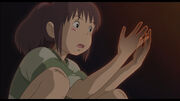
Chihiro starts to fade away as nightfall begins.
Chihiro's distress at losing her parents is compounded by the discoveries that the world around her has changed and that her body seems to be disappearing. A mysterious boy named Haku appears, comforts Chihiro, and gives her a red berry to eat, which makes her solid again. He smuggles her into a large bathhouse owned and operated by the evil witch Yubaba , where thousands of spirits come to refresh themselves. Haku tells Chihiro that the only way she can remain in the spirit-world long enough to rescue her parents is by gaining employment in Yubaba's bathhouse. When Chihiro asks Haku how he seems to know her so well, Haku replies that he has known Chihiro since she was very small.
The Contract [ ]
"Why on earth should I hire you? Anyone can see you're a lazy, spoiled, stupid crybaby. What job would I possibly have for someone like you? You're wasting your time. I've got all the bums I need. Or maybe I'll give you the nastiest job I've got... and work you night and day... until you breathe your very last breath!" —Yubaba considers hiring Chihiro

Haku helps Chihiro survive the night at the bathhouse.
At first, she tries to get work with Kamajī , who works at the boiler room , but is rejected. Kamajī instead hands Chihiro off to the worker, Lin , to take her to Yubaba. In Yubaba's penthouse suite , Chihiro repeatedly asks for a job, overriding the monstrous witch's refusals. Yubaba ultimately consents, on condition that Chihiro give up her name. Yubaba literally takes possession of Chihiro's real name (荻野 千尋 , Ogino Chihiro) by grasping the kanji characters from Chihiro's signed contract, leaving Chihiro with one part of one character of her original two-character name, in isolation pronounced "Sen" (千). Taking a person's name gives Yubaba power to keep its owner in her service permanently; it is revealed that Haku is also in Yubaba's service, and remains so because she has taken part of his full name.
Life at the Bathhouse [ ]
"It's a Stink Spirit - Yes, and a large one, too." "It's headed straight for the bridge! Please turn back. Please go!" "The baths are closed for the night. Please withdraw, please!" "Stinky!" "That's odd. Stink Spirits feel different." "Well, now that it's here, better go greet it! All we can do is get rid of it fast." —The Bathhouse staff encounter the Stink Spirit

Chihiro helps free a river spirit from his sludgy form.
While at work, Sen gives admittance to a wraithlike spirit called No-Face , who returns the favor by helping her obtain water needed to bathe a "stink sigil " whom no one else will help. After bathing, the stink spirit is revealed to be a powerful River Spirit who rewards Sen with a strong emetic dumpling.
Subsequently, Sen sees Haku in the form of a white dragon, and later on helps save him from attacking Shikigami . Searching for the injured Haku, Sen encounters Yubaba's big infant son, Boh at her apartment . Sen finds Haku, who was attacked by Zeniba , Yubaba's twin sister, because Haku had stolen her sigil. When Boh distracts Zeniba, she transforms Boh into a mouse, and Yu-Bird into a hummingbird. Zeniba tells Sen that Haku has stolen a magic gold seal from her, and warns Sen that it carries a deadly curse. Haku then rips up the remaining Shikigami, causing Zeniba to disappear. After Haku dives to the boiler room with Sen and Boh on his back, she feeds him part of the dumpling. Doing this, Sen causes Haku to spit out the stolen sigil, which he had swallowed. He also chokes up a black slug which Sen squishes, yet Haku remains unconscious. Hoping to lift Zeniba's curse and save Haku from a coma, Sen decides to set out to return the sigil to Zeniba.

No-Face develops an obsession for Chihiro, even propositioning her with gold.
Meanwhile, No-Face has become intoxicated with the greedy atmosphere of the bathhouse and swells into a huge monster, giving illusory gold to the bathhouse workers in exchange for food. When the workers do not comply with his demands, he eats several of them; this causes a panic and the entire bathhouse is thrown into pandemonium. Sen manages to solve the problem by feeding No-Face the remaining emetic, making him regurgitate several million tons of black poison and the bathhouse workers, then leads him out of the bathhouse. No-Face reverts to his former size and demure personality, and along with Sen and Boh, takes the sea railway and travel by train to Zeniba's faraway cottage at Swamp Bottom . At Zeniba's home, Sen gives the sigil back to Zeniba, apologizing for having squished the black slug. An amused Zeniba reveals that the slug had been one of Yubaba's means of controlling Haku, and that the curse put on the seal has already been broken by Sen's friendship.
Sen's Courage [ ]
"Who are you?" "Yubaba's older twin sister. Now hand over the dragon." "What are you going to do? He needs help." "That dragon's a thief. He works for my sister. He stole a valuable seal from my house." "Haku would never do that. He's too kind. All dragons are kind." "Kind and stupid... and eager to learn my sister's magical ways. This boy will do anything that greedy woman wants. Now step aside." —Chihiro meets Zeniba

Chihiro learning Haku's "real" name.
In the bathhouse, Yubaba discovers Boh's absence and is enraged. Haku, now revived and restored to his human form, offers Boh's safe return in exchange for Sen and her parents to be freed and restored to normal. Yubaba accepts, but promises to set Sen one final task. Along with Boh and Yu-Bird, Haku and Sen fly back to the bathhouse, leaving No-Face to live with Zeniba as her assistant. En route to the bathhouse, Chihiro remembers a previously suggested meeting with Haku: some time ago, she had fallen into a river and was rescued by the river's spirit. She then realizes that the spirit of this river, called Kohaku River, and her friend Haku are one and the same, and thus revealing Haku's real name, Nigihayami Kohakunushi , which literally translates to "God of the Swift Amber River." At this realization, Haku's dragon form is molted away, and he is completely freed from Yubaba's control.
The Return [ ]
"Go back the way you came. But don't look back until you're out of the tunnel." "But what about you?" "I'll tell Yubaba I'm quitting my apprenticeship. I'm fine now. I have my name back. Now I can go home too." "Will we meet again somewhere?" "I'm sure of it." "Promise?" "Promise." "Now go, and don't look back." —Haku says farewell to Chihiro

The bathhouse staff cheers as Chihiro breaks her contract from Yubaba .
Yubaba and a large crowd have gathered to witness Chihiro's final task: to pick out her cursed parents from a group of pigs. Chihiro correctly states that none of the pigs displayed by Yubaba are her parents, and thus wins back both her parents' humanity and her own freedom from the bathhouse. Afterward, Haku takes Chihiro to rejoin her restored parents. He bids her farewell and promises that he will come see her again. As Chihiro and her parents return to their world, her parents lose all memory of their visit to the spirit world. The family then gets back in their car and resume their journey to their new home. Miyazaki himself has stated that Chihiro also forgets her adventure in the spirit world, but it is hard to tell in the dub version whether or not she did because of extra lines of dialogue added at the end. These extra lines are from Chihiro's dad and herself; her dad worries about her having to live somewhere else and go to a different school, but Chihiro replies that she thinks she can handle it. In the sub version, she just silently thinks about her adventure.
Characters [ ]
Director's message [ ].
"This film is akin to an adventure story, but without the agitation of weapons or superpowers. And even if I speak of adventures, the subject is not the confrontation between good and evil, but rather the story of a little girl who, thrown into a world where brave people and characters mingle dishonest, will discipline themselves, learn friendship and dedication, and will use all resources to survive. She gets out of the situation, she dodges, and returns for a time to her daily life. At the same time, the world is not destroyed, and this is not due to the extermination of evil, but to the fact that Chihiro possesses this life force. Today the world has become ambiguous. The main subject of this film is to portray in a clear way this world which seems to be consumed, and this borrowing, despite this ambiguity, the form of a fantasy. In a world where they are guarded, protected, kept at a distance, children allow their frail arms and legs to hypertrophy. Chihiro's slender arms and legs, the angry expression on her face, typical of someone who doesn't easily have fun, reflects that. But in truth, when she finds herself confronted with a situation of crisis, where relations are blocked, one realizes that her strength of adaptation and her perseverance rebound, and that she commits her life to deploying a faculty of judgment. and a capacity to act decisively. Under the circumstances faced by Chihiro, most men would panic or refuse to believe it, but these men would end up being devoured. We can say that in fact, Chihiro's talent is to find the strength not to be devoured. In no way did she become the heroine because she would be a pretty little girl with an exceptional heart. On this point, it is one of the merits of this film, and it is also why I intended it for the little girls of ten years. Speech is a force. In the world where Chihiro got lost, the act of uttering a word constitutes an act of decisive weight. At the baths run by Yubâba, if Chihiro pronounces the words: "I don't want," "I want to go home," the witch immediately throws her outside; all that remains is to wander with nowhere to go and disappear, or be turned into a hen and lay eggs until eaten. Conversely, when Chihiro says: "I will work here," witch she is, Yubâba cannot ignore it. Today, the word has an unlimited lightness, you can say anything, it is received like a bubble and only restores a reflection of reality. Yet the fact that speaking is a force is still true today. A word is only vain, without force, because it is emptied of its meaning. The act of stealing the name is not that of transforming it into a nickname, it is an approach which aims to totally dominate his opponent. Sen is scared to find that she has forgotten her own name, Chihiro. In addition, every time she goes to visit her parents at the pigsty, she gradually becomes indifferent to the fate of these changed into pigs. In the world of Yubâba, one must continually live in fear of being devoured. In this difficult environment, Chihiro comes alive. Usually frowning, his face will radiate a charming expression for the finale of the film. However, the nature of the world is in no way modified. This film possesses or appeals to a persuasive force according to which the word represents an own will, an energy. There, the fact of having realized a fantasy taking place in Japan has a meaning. Even though this is a fairy tale, I didn't want to do a western fairy tale, with many loopholes. This film may seem to be in imitation of a different world, but rather I wanted to think about a direct line with the tales of the past like Suzume no Oyado (The house of the hawk) or Nezumi no Goten (The Palace of Mice). The fact of giving the world where Yubâba lives a Western side suggests something that we have already seen somewhere without being able to distinguish between the dream and the real, and at the same time, it is a melting pot. many images from traditional Japanese ideas. The whole range of folklore - stories, traditions, events, ideas, from religious rites to magic - as abundant and unique as it is, is simply ignored. Kachi-kachi Yama (The mountain that cracks) or Momotarô have certainly lost their persuasive force. However, I also have to say that just to load a cute world, like there is in folklore, with traditional elements, would really be limited imagination. Children, surrounded by high-tech, superficial products, are increasingly losing their roots. We have a very abundant tradition, a tradition that we have the duty to pass on to them. I think you have to introduce traditional ideas into a modern narrative, like you embed a piece in a vivid mosaic. The world of cinema will thus have a new persuasive force. At the same time, I realize once again that we Japanese are islanders. In an age without borders, men who do not own places will be looked down upon. A place is a past, it's a story. I think that the men who have no history and the people who have forgotten their past will disappear like mayflies, or will be turned into hens to lay eggs while waiting to be eaten. I think I made this film with the real wish that it would reach an audience of ten-year-old girls." —Hayao Miyazaki on the film's official website
Work Motif [ ]

While the film featured a climactic flying scene with Haku and Chihiro , Miyazaki was more enamored by the train scenes, but feared adding too many would recall Kenji Miyazawa's Night on the Galactic Railroad .
Upon completion of the film, Hayao Miyazaki held a press conference at the Imperial Hotel in Tokyo. He was asked that towards the end of the film, audiences finally saw a flying scene, with Chihiro and Haku flying again. Miyazaki responded, "I never thought about whether we should include scenes of Haku or Chihiro flying or not. But on my own, I did think about having Chihiro ride on a train. And since I spent so much time telling people we should do this, I was really happy when she finally did get on board. We were collecting sounds of train audible through the shadows of trees, or shots of the trains running, but from my experience that usually just results in train scenes and nothing more. So in that sense I thought it really was wonderful to have Chihiro actually ride the train, even better than flying through the air."
"I actually wanted to include a few more train scenes, but we were ultimately unable to do because of the structure of the film. Since I had spent a lot of time talking about the train idea, it got to the point where those around me were asking if there wasn't some way we could include the other scenes. I planned to tell them that, if we could include them, this could wind up being like Kenji Miyazawa's Night on the Galactic Railroad. Unfortunately we couldn't include the scenes. It's the sort of things that happens in making films, and it can't be helped.
Child Labor [ ]

Miyazaki recalled seeing an NHK documentary of child labor in Peru, and said that it is still ever present in other parts of the world, and was also part of Japanese history.
When asked why the film centered around Chihiro having to work, Miyazaki explained, "I got the idea from a documentary I saw on the NHK TV channel, about child labor in Peru. I thought that, if I were to make a film for the sake of all the children on earth, it would have to be something that any child could understand, no matter what sort of life they were living. I really didn't want to make a film that only Japanese kids would understand. And besides, the idea that children don't have to work is really very new. My grandfather, for example, went off to work as an apprentice at the age of eight, and as a result he never learned how to read. That's the way things were in Japan until recently. The only reason kids don't have to work today is because Japan experienced a period of high economic growth after the war. In reality, most children in the world still have to work. I'm not saying that's good or bad, just that we need to remember it. In truth, people are social animals, so it's not good for us to live without some sort of connection to society. We have to work.
A World of No-Faces [ ]
For Miyazaki, No-Face represented people's unknowable intent.
When asked what is No-Face's purpose, Miyazaki responded, "There are No-Faces all around us. Because there's only a paper-thin difference between evil spirits and gods. And on top of that, this film is set in Aburaya, a bathhouse. So once you open the doors, all sorts of things come in." When asked to explain if Miyazaki were referring to the youth of today, he explained, "I didn't make the film with that in mind. No-Face is just a name and a mask, and other than that we don't really know what he's thinking or what he wants to do. We just named him No-Face because his expression almost never changes; that's all. But I do think there are people like him everywhere, people who want to glom on to someone but have no sense of self.
Haku the Pretty Boy [ ]
When describing why he made Haku a bishōnen or 'pretty boy character', Miyazaki responded that he originally had no intention to, "But if you've got a girl, you've got a boy; if there's a boy, there's a girl. That's what makes our world. And since our heroine's a tad ugly, I thought without a fair and handsome boy, it would be too boring." When asked to elaborate on whether it was intentional in depicting Chihiro as ugly, "No, but I really don't think she's your typical beautiful girl. I didn't draw her thinking that at all. I wanted to depict a girl who would make viewers worry about what she would become in the future. And while I was drawing her, I thought that she would probably become cool. Because they can change so suddenly. Take people's faces; I think that people create the faces they wear. So I didn't want to draw Chihiro with your stand cute-girl face. And I was right in making that decision."
Yubaba and Zeniba [ ]
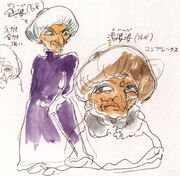
Character designer Masashi Ando initially wanted Yubaba's twin to be an older, taller sister.
Miyazaki described Yubaba as the "everyman" type, and were "symbols of modern working people". As for his decision in creating the twin sister Zeniba , "Ultimately , when we were getting down to the wire in the latter half of the production, Masashi Ando , the animation director, begged me not to add new characters. So I created a twin for Yubaba. Of course, in retrospect, it could have been taller, older sister and not just a twin. But either way, it's still really like two faces of the same person. When we're at work like Yubaba, yelling and making a mess and getting people to work, but when we go home we try to be good citizens. This schism is the painful part of being human." Some people who live a calm life like Zeniba at home may treat their subordinates as strict bosses like Zeniba while facing stress at work.
"Taking Yubaba as a single character, we spent ten times more time connected to her, observing her, and thinking about how to depict her, than we did actually drawing storyboards for her-so much so that I don't even remember how far we developed her in the storyboards." [3]
Miyazaki further elaborated on Zeniba's true nature, "We skipped all explanations (on the fact) that Yubaba and Zeniba are really the same person. I'm that way too. I'm completely a different person when I'm at Ghibli, when I'm at home, and when I'm out and about in the community. In fact, I live in amost schizoid fashion. I was worried about how children would accept this aspect of the movie, but they seem to have accepted it with no problem at all, so I've been greatly relieved." [4]
Power of Words [ ]
Some suggest that the film is an allegory on the progression from childhood to maturity, and the risk of losing one's nature in the process. The theme of a character being lost inside a (fictional/different) world if they forget their real name is a common folk theme. True names having magic power are a staple of folks tales such as Rumplestilskin or Earthsea . Similarly, Chihiro and Haku stay under Yubaba's control forever if they forget their real names and consequently their real identities.

The contract between Yubaba and Chihiro represented an old tradition in Japan where you had no right to refuse someone who really wanted to work.
When Miyazaki was interviewed by journalist Tetsuya Chikushi on January 11, 2002, Chikushi noted shocking it was when Chihiro was told "if you say 'No!', you'll be turned into a chicken and have to go on laying eggs until you're eaten,", stating how that was cosmic retribution.
Miyazaki explained, "Recently my friends and I use the word asamashii [despicable or disgraceful] a lot. It's a word that's fallen out of favor these days, but it seems perfectly suited to describe the current Japan. It originally refereed to things that should have been more embarrassing and shameful of all."
Chikishi responded, "There's a problem with language in Spirited Away, isn't there? Some of the key words for the young heroine are simple, such as when she declares repeatedly, "I'll keep working here". I watching this, thinking that you were trying to tell us how much power words have."
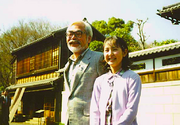
Hayao Miyazaki and Rumi Hiiragi , the actress who played Chihiro Ogino , photographed at the Edo Tokyo Open Air Park on March 26, 2001.
Miyazaki then said, "Actually, we thought about having Yubaba use an actual labor contract of some sort there, but since no one would get it even if we included an explanation, we just left it with her saying, "we're using a boring old oath." But there is a labor agreement in effect in her world because she has to give work to those who want it. Because that's the kind of society Japan originally was; people had to give work to those who wanted it. To want to work is to want to live. To live in a specific place. We skipped all the explanations. The same with the fact that Yubaba and Zeniba are really the same person. I'm that way too. I'm completely a different person when I'm at Ghibli, when I'm at home, and when I'm out and about in the community. In fact, I live in most schizoid fashion. I was worried children would accept this aspect of the movie, but they seem to have accepted it with no problem at all, so I've been greatly relieved." [5]
Other Motifs [ ]
The main character is a very modern Japanese ten-year-old who's being forced to grow up and adapt when faced with more traditional Japanese culture and manners. Miyazaki himself has said that there is an element of nostalgia for an older Japan in this film and several of his others.
Miyazaki also included a theme advocating the prevention of greed: those swallowed by No-Face were attempting to receive the gold he made. Similarly, in a monomyth format, Yubaba's rich accommodations and interest in gold dominate the "road of trials" portions of the film, while Zeniba's rustic home and grandmotherly demeanor arguably mark Chihiro's gain of the "boon" in her quest. Also, Chihiro's parents' grotesque transformation after consuming too much food not meant for them is another representation of human greed, and may also be a reference to The Odyssey .
Environmental awareness is a theme explored by Roger Ebert. The most obvious examples of this are the river spirit's dramatic and beautiful transformation once he has been freed from the material dumped in him by humans, and Haku's discovery that the reason he cannot go home is that the River Kohaku, whose spirit he was, had been filled in by apartment buildings. This environmental awareness is present in several of Miyazaki's works, such as Nausicaä of the Valley of the Wind and Princess Mononoke .
Behind the Scenes [ ]
Development [ ].
"I think certain motifs appear over and over in our deep psyches. Even Krabat isn't something that the author suddenly thought up, because it's based on folktale that's been handed down from the Middle Ages. So when making Spirited Away, there were many things I wanted to include but couldn't. When working on it, I frankly felt like I was lifting the lid on areas of my brain that I wasn't supposed to expose. But creating fantasy is all about lifting the lid of your brain, flaunting things that you don't normally expose. IT's about treating the world we discover there as though it's a reality, to the point where the real world itself sometimes seems to lack reality. AT some point, this other world takes on a greater reality than that of our own ordinary lives. In just talking about this subject now, we lose a type of reality, because all the focus is on the other world" —Hayao Miyazaki [6]

Seiji Okuda (center) and his then 10-year-old daughter helped give Miyazaki a starting point to work on the film.
Following the grueling production of Princess Mononoke Miyazaki considered retiring once again to focus on his personal projects, such as opening the Ghibli Museum . He did not think he would be able to embark once again on such a long and tiring experience. However, the vacuum left by the death in 1998 of his designated successor Yoshifumi Kondō pushes him to roll up his sleeves once again. His stance changed upon meeting the daughter of his friend Seiji Okuda , on whom the main protagonist of Spirited Away is based. Chihiro's father, Akio Ogino , was based on the real-life father of the girl Chihiro is based on. Miyazaki said Okuda is similar to Akio in that he had a habit of getting lost while driving and ate too quickly. Chihiro's mother, Yuko Ogino , is based on a friend of Miyazaki's; an idiosyncratic hand-gesture of Miyazaki's friend is copied when Yūko is eating in Spirited Away . Chihiro's best friend's name is Rumi (the one who gave her the flowers in the opening), which is the name of Chihiro's voice actor.
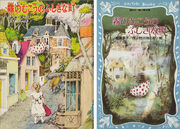
Marvelous Village Veiled in Mist by Sachiko Kashiwaba proved to be a major inspiration for Miyazaki.
As with his other film projects, the initial idea germinated several years before becoming the film we know. Prior to the production of Princess Mononoke , Miyazaki had considered adapting the children's book, Kiri no Mukô no Fushigi na Machi (霧のむこうのふしぎな町), also known as Rin and the Chimney Painter or Marvelous Village Veiled in Mist , a 1975 novel by Sachiko Kashiwaba about a young student forced to repaint the chimney of a bathhouse left behind. A member of the Studio Ghibli team loved this book when he was about ten, and read it many times.
Like Japan's most famous children's writer, Kenji Miyazawa (another source of inspiration for Miyazaki), Kashiwaba is from Iwate. The story goes that during the summer holidays six year old Rina is sent on her own to stay in the village in the countryside where her father had stayed as a child. Where Rina gets off the train, the village people are only half convinced that her destination, the valley of mist, exists, but following their uncertain directions, she sets off, and helped by her umbrella, which gets blown away so that she has to chase after it, she finds herself in a strange one street village.
The house where she will be staying belongs to a tiny old lady, who seems perpetually angry and delights in putting people on the wrong foot.
"What are you dawdling for? If there's one thing I hate, it's dawdlers," the voice she had heard earlier sounded angry. Rina inched fearfully into the room. By the window there was a big flowery sofa, and on that sofa, like a black fleck, a little old woman was sitting. The old woman did not look at Rina. As if she knew who it was without looking, she went on eating her biscuit and drinking tea. Rina, not knowing what to do, stared at the old woman who was ignoring her. Finally, the old woman broke the silence, "Six years old and you still don't know how to greet a person." "Uesugi Rina," Rina said, bowing, "Thank you for your kindness in having me." "Who said anything about kindness? Anyone who stays in her house must work while they're there," she tells Rina. [7]
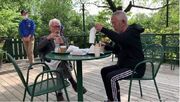
Miyazaki likened the bathhouse to how Studio Ghibli is run, and made comparisons to its producer Toshio Suzuki .
So Rina helps in the house or is sent to the different shops that make up the village. But this is no punishment, as they are all fascinating places run by different magicians. As she works Rina becomes more self confident and finds her true character. Miyazaki didn't understand why he found this story so interesting and, intrigued, he wrote a project proposal around it, but it was also rejected.
Another source of inspiration for Spirited Away was, by its director's own admission, Studio Ghibli itself. Thus the intense activity that reigns in the bathhouses evokes that of the studio. The character of Yubaba , who governs the establishment, would correspond to the producer Toshio Suzuki , while the very overwhelmed Kamajī with multiple arms would be like Miyazaki. Chihiro , she has to work hard if she does not want to disappear, which is equivalent to being sent back to the studio.
Inspired by Japan [ ]
"As we say in Japan, 'The customer is always god.' That's just a bit of a pun, but I think it's true." —Hayao Miyazaki
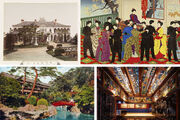
Yubaba's opulent apartment floor was inspired by places like Romkumeikan (Top) and Meguro Gajoen (Bottom).
In an interview on the film's Roman Album dated September 10, 2001, Miyazaki refers to the strange world Chihiro wanders into as Japan itself. "Until recently, the dormitories for female workers of textile companies or wards in long-term care facilities all looked like the employee rooms in the bathhouse where Chihiro lives. That's what Japan was like until just a while ago. I felt a real sense of nostalgia when depicting them. We've forgotten what the buildings, streets, and lifestyles were just like a little while back." Meanwhile, regarding Yubaba's Western-style home, "That's supposed to be something like Romkumeikan or Meguro Gajoen . I think that for us Japanese, what seems really deluxe is to have something that is a mishmash of a traditional-style palace, a grand Western-style (or quasi-Western style) mansion, and something like the Palace of the Dragon King, and then to live in it, Western style. The Aburaya bathhouse, I should say, is really like one of today's leisure land theme parks, but it's something that could have also existed in the Muromachi and Edo periods. So we're ultimately depicting is the real Japan."
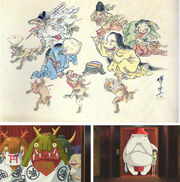
Unlike the designs of gods seen in ancient scroll paintings like Hyakki yagyozu , Spirited Away's gods are more modest in design.
As for the depiction of the spirits, Miyazaki mentions how Japanese gods are quite modest in design. "Tenjin has been turned into a god for those who pray for success in their school exams, and I'm sure it's tough for him because he doesn't even understand English. [laughs]" Other traditional Japanese gods have been lumped in with Buddhism and made into wooden idols of worship, but that wasn't what they originally were. What Miyazaki is trying to say is that Japanese spirits "originally never had a form. And if people give them form without being careful, they start looking like yokai . But even that's vague since all the yokai in the famous scroll painting Hyakki yagyozu were all given forms after the fact. So in principle, I didn't want to depict my Japanese spirits to be based on any existing images. But one exception is the masks at Kasuga Taisha shrine. When I saw photos of them, they were too fascinating not to use as reference. When I gave form to the spirits, I didn't want them to look like deities. So if you ask my why I depicted the spirits the way I did in the film, it's because I think Japanese gods are probably quite exhausted. So it made sense to me that they would want to come to a bathhouse and stay two nights and three days. Sort of like the Shimotsuki festival.
Hostess Bars [ ]
Finally, another starting point for Spirited Away is an anecdote told by Suzuki to Miyazaki. The latter spoke of hostess bars, where the latter are often shy, forced to learn to communicate with men. They pay to be able to express themselves as well. This image has remained etched in Miyazaki's mind and exploited it in his film: Chihiro is forced to learn to express himself when she is serving in the baths, while No-Face fails to express himself. and uses violence and money to be able to do so. All these elements combined led to the creation of the final proposal of the film.
Production [ ]
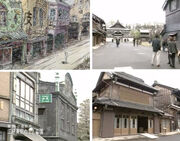
Many of the film's locations were inspired by the Edo-Tokyo Open Air Architectural Museum.
Production of the film began at the end of 1999 and ended in June 2001. As usual, Hayao Miyazaki realized that the film would last more than three hours, if he had made it according to his original proposal. Much of the original script was cut to expedite the film's length. Due to relatively tight production deadlines (one and a half years instead of three for Princess Mononoke ), Spirited Away is the studio's first film not to have been entirely made in Japan. The development of part of the scenes was therefore entrusted to the Korean studio DR Digital, which had already worked on animated films as prestigious as Metropolis or Jin-Roh .
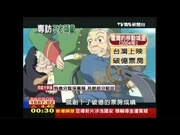
【FOCUS新聞】TVBS專訪宮崎駿 72歲不老頑童
A 2013 interview with Hayao Miyazaki and TVBS, a Taiwanese news agency. Here he denies that the backgrounds in Spirited Away were inspired by the shops at Jiufen in Taiwan.
Hayao Miyazaki sought authenticity in the representation of the bathhouse, admitting to having been inspired by the buildings at the Edo-Tokyo Open Air Architectural Museum , which was near the studio where he liked to walk. Its park indeed offers a reconstruction of the Japanese capital, between the 17th and the beginning of the 20th century. For Miyazaki, to represent this place is to plunge the Japanese viewer into a certain nostalgia. Ghibli staff conducted location scouting at this park on March 17, 2000. The public bathhouse Kodakara-yu was Miyazaki's favorite exhibit, and many of its details were used as reference when designing the bathhouse in the film. The main building at Dōgo Onsen in Matsuyama was also referenced, following a past Ghibli company trip. The interiors of Meguro Gajoen and the ceilings of Nijō Castle was used as reference. Kamajī's workplace was based on the Takei Sansho-do (stationery store) at the Edo-Tokyo Museum. Meanwhile, the film's bathhouse's girl's dormitories was based on the Japanese garment factories from the 1950s. The National Sanatorium Tama Zenshōen's multi-tenant room also served as inspiration.
It has been claimed that Miyazaki was inspired by the shopkeepers at Jiufen, a town near Taipei in Taiwan. However, when Miyazaki was asked about this by Taiwanese media, he denied it.
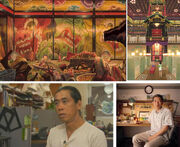
Art director Yôji Takeshige (left), Noboru Yoshida and Kazuo Oga took inspiration from several real-life locations. Yoshida painted the fusuma painting of a giant demon seen here.
Art director Yoji Takeshige and assistant art director is Noboru Yoshida helped to refine Miyazaki's original e-konte and image boards. Takeshige ran the drawing department, and helped guide many of the new hires at the studio as production began to ramp up. Normally, background art production is done in three stages. A rough drawing of the background is laid out, and an art board is drawn over it to serve as a guideline before actual background painting begins. The head of this process specifies the color and texture in detail. For Spirited Away , Takeshige did not create the art setting as Miyazaki already created the background via his e-konte (storyboard). Art director and background artist Kazuo Oga , who previously worked on My Neighbor Totoro , worked on the opening backgrounds before Chihiro's family enters the theme park, and the natural landscapes towards the end of the film. Noboru Yoshida was in charge of the fusuma painting of a giant demon in the bathhouse.
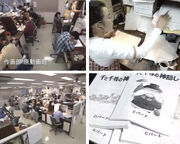
The grueling work at Studio Ghibli, and the storyboards for the film. Many employees reported working to exhaustion.
Likewise, for the character design of the characters, the director was inspired by those close to him. Chihiro is the faithful representation of the little girl who motivated him in making the film. Chihiro's father is the faithful portrait of the little girl's father, particularly in his voracious attitude. The mother of the heroine is the carbon copy of a regular Miyazaki collaborator within the studio. This was clearly his attempt at anchoring this fantastical work to contemporary Japan.
With regards to the animation of certain scenes, Miyazaki showed great concern for realism. He explained in detail the movement of Haku, in the form of a dragon, falling to the ground, akin to a lizard or a green snake wriggling on a wall and suddenly collapsing. He encouraged the animators to go to an eel restaurant to observe their movement. Likewise, when Miyazaki directs a scene where Chihiro gives Haku a dumpling to eat, he explains to the young designers that he wants a mouth similar to that of a dog. In order to respect the director's instructions, the animators went to a veterinarian to observe the behavior of a dog, its teeth, the way in which it is necessary to maintain its mouth. These few examples perfectly evoke Miyazaki's desire to achieve a certain realism of the staging, in a however fantastic setting.
For the first time, Miyazaki wouldn't be able to check and correct the work of the other animators himself because of a major problem with his eyesight. To help him, he therefore called on Masashi Ando , who has been working in the studio since its inception. He assisted the director, sometimes to the point of exhaustion, to maintain his exacting standards.
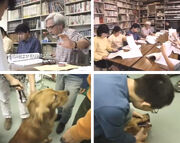
Miyazaki demonstrating to his staff how to depict scenes. One involved feeding Haku like a dog, so the staff visited a veterinarian.
100 shots out of the 1,400 that make up the film were produced by the 3D-CG section, directed by Mitsunori Kataama . These are scenes that proved far too complex to animate by hand, often including rapid movements of the 3D camera (such as the stone statue seen in the woods or the Chihiro race between the hedges of flowers) and the animation of the 'complex elements like water.
Several techniques were used. According to Kataama, “We added depth to the original 2D images by projecting the hand-drawn backgrounds onto 3D models. Then, we used Softimage 3D to calculate the light reflections and the lighting components that we then added to the sets. We have also implemented an original 2D texture shading process, making it possible to obtain the appropriate projection of the image of the scenery from different angles. Finally, we have developed a plug-in that makes it easier to change the field of view on a given plane."
Another significant challenge taken up by the 3D team at Studio Ghibli is the creation for the sea of a realistic and ever-changing surface. This required internal development of another 2D texture shading process, and the use of several shading and lighting tools to simulate reflections and refractions on the water surface.
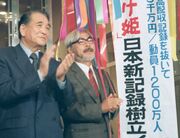
Yasuyoshi Tokuma was an eccentric figure, who was close with Toshio Suzuki and owned Studio Ghibli until they became independent a few years after his passing.
On September 20, 2000, chairman of Tokuma Shoten and Studio Ghibli president Yasuyoshi Tokuma passed away. [8] A farewell ceremony was held at Grand Prince Hotel Takanawa on October 16th of that year.. Miyazaki presided over the association. According to Seiji Kano, in Miyazaki's speech, he mentioned that all the attendees in mourning looked like frogs, implying a relationship with the frog men in Spirited Away . [9] Tokuma died without having seen the final cut of the film, but he was posthumously credited as "Executive Producer".
At the same time, Spirited Away's production was facing serious delays. Several new animation directors were hired, although Toshio Suzuki was worried the film would not meet its deadline. New animators were given at least "one cut per person in a week" to complete. Only half of the animation cuts were made in-house at Ghibli, while the rest was outsourced. Veteran animator Kenichi Konishi was asked to find any available animator he could hire for support the production.
It soon became clear that outsourcing video and coloring to other domestic studios and talent would not be enough. Therefore, for the first time since the founding of Studio Ghibli, Suzuki decided to outsource to an overseas studios. Four people were sent from Ghibli to South Korea to oversee the operation. [10] Korea's DR DIGITAL was placed in charge of video and coloring, while JM Animation Co. was in charge of coloring. Their work was produced at a high standard, which satisfied the Suzuki et al.
Announcement [ ]

Due to Miyazaki's deteriorating eyesight, Masashi Ando stepped in to help check all the key drawings.
The announcement in December 1999 of Miyazaki's new film created a stir. The emotional charge of waiting for the new baby is further reinforced by the little information that the production deigns to let filter out, if we except the title, Sen to Chihiro no Kamikakushi (literally The strange disappearance of Sen and Chihiro), and a 40-minute documentary broadcast on May 4, 2000, on the NHK channel.
But things became clearer at the beginning of 2001. At the beginning of January, the magazine Animage presented the images of the teaser (short trailer), then screened in Japanese theaters. On January 26, the NTV channel broadcasts it exclusively on television. Soon follow a new trailer, the trailer and finally a clip illustrating the magnificent song of the end credits. But there is more to promoting the film than advertisements on television. Tôhô , the film's distributor in Japan, is carrying out a Disney-worthy marketing campaign and, with such media hype, observers expect a tidal wave.
Dubbing [ ]

Spirited Away Sound & Music 1of3.mov
Scenes from the NHK documentary of the cast dubbing at Studio 2 of Studio Ghibli.
For the dubbing, Hayao Miyazaki chose confirmed actors to embody the voice of his characters. The young actress Rumi Hiiragi , aged 13, known in Japan for a morning drama on the NHK channel, was hired while Miyu Irino was given the role of Haku . Their interpretation is marked by accuracy and moderation. Bunta Sugawara , with a 45-year acting career, lends his voice to Kamajī and Mari Natsuki , truly transcends her slim figure and her soft voice to embody an earthy and directive Yubaba . The most surprising thing is to discover that the enormous baby Boh is played by Ryûnosuke Kamiki , a little boy of 4 or 5 years old, considered a little genius in Japan.
Regarding the recording of these voices, Miyazaki has chosen this time, and for the first time, not to separate the recording room from the one where the sound engineer and the director are usually located. Miyazaki, but also Toshio Suzuki, are therefore in the same room as the actors. The goal of this novelty is to be able above all to be able to better direct the voice actors and to be able to better explain the intonations that Miyazaki are looking for a particular character. Miyazaki will even go so far as to mimic the dance and sing the ritornello of the manager of the baths to the actor Takehiko Ono.
Sound Mixing [ ]
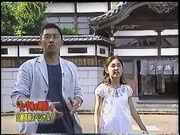
「千と千尋の神隠し」公開直前スペシャル!
TV special of Spirited Away that aired before the film's release, featuring Rumi Hiiragi , the voice actress for Chihiro and Takashi Naitô, voice actor of Chihiro's father exploring the Edo-Tokyo Museum.
This is a first for studio Ghibli, Spirited Away benefits from the digital DLP format. Like Star Wars: Episode 1 - The Phantom Menace , the film is directly recorded on hard disk, without going through the reel stage. It also benefits from the EX 6.1 sound system, using six channels to give it its full sonic breadth.
The soundtrack is once again extremely polished and contributes beautifully to the viewer's immersion in the strange world of Aburaya. Sound engineer Shûji Inoue travels to Kusatsu to record the noise produced by the water from its famous hot springs. He will thus store up a multitude of sounds: brooms rubbing the floors of public baths, crockery colliding in a kitchen or in a reception room, the engine of Chihiro's father's car. Tôru Noguchi, who has been dealing with cartoon sound effects for 20 years, recreates other sounds in the studio, like those of the multitude of footsteps of the characters in the film. All of these sounds make Spirited Away very realistic, and once again,despite the fantastic context of the story.
Release [ ]
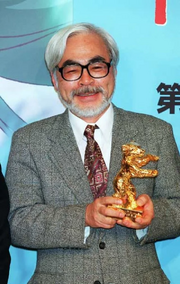
On February 17, 2002, Hayao Miyazaki's Spirited Away won the Golden Bear Award, the highest award at the 52nd Berlin International Film Festival. This is the first time in the world that an animated cartoon has won the award. Miyazaki flew to Germany for the ceremony, accompanied by Toshio Suzuki and Steve Alpert .
Spirited Away was released in Japan in July 2001, drawing an audience of around 23 million and revenues of ¥30 billion (approx. US$250 million), to become the highest-grossing film in Japanese history (surpassing the film Princess Mononoke for highest-grossing animated motion pictures). It was the first movie to have earned $200 million at the worldwide box office before opening in the United States. By 2002, a sixth of the Japanese population had seen it.
The film was dubbed into English by Walt Disney Pictures, under the supervision of Pixar's John Lasseter. It was subsequently released in the United States on September 20, 2002, and had made slightly over $10 million by September 2003.
Home Media [ ]
The film was released in North America by Disney's Buena Vista Distribution arm on DVD format on April 15, 2003, where the attention brought by the Oscar win made the title a strong seller. Spirited Away is often marketed, sold and associated with other Miyazaki movies such as Castle in the Sky , Kiki's Delivery Service , and Nausicaä of the Valley of the Wind .
The North American English-dubbed version was released on DVD in the UK on March 29, 2004. In 2005 it was re released by Optimum Releasing with a more accurate subtitle track and additional bonus features.
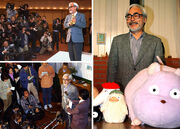
After Miyazaki returned to Japan, he was greeted by the press. A conference was held where he said a few words regarding his experience.
The back of the Region 1 DVD from Disney and the Region 4 DVD from Madman states that the aspect ratio is the original ratio of 2.00:1. This is incorrect; the ratio is actually 1.85:1 but has been windowboxed to 2.00:1 to compensate for the overscan on most television sets. There is much dispute over the validity of this practice, as many displays are capable of showing the entire picture, and as a result the DVD picture has a noticeable border around it.
All Asian releases of the DVD (including Japan and Hong Kong) have a noticeably accentuated amount of red in their picture transfer. This is another case of compensating for home theatre displays, this time supposedly for LCD television which, it was claimed, had a diminished red color in its display. Releases in other DVD regions such as the US, Europe and Australia use a picture transfer where this "red tint" has been significantly reduced.
Television [ ]

Spirited Away received a stage adaptation, Spirited Away: Live on Stage , which premiered at the Tokyo’s Imperial Theater in February 28, 2022. Subsequent performances were held in Osaka, Fukuoka, Sapporo and Nagoya. The stage adaptation starred Kanna Hashimoto and Mone Kamishiraishi. It was written and directed by John Caird, an honorary associate director of the Royal Shakespeare Company and a big fan of Miyazaki’s work.
The U.S. television premiere of this film was on Turner Classic Movies in early 2006, closely followed by its premiere on Cartoon Network's "Fridays" on February 3, 2006. On March 18, Cartoon Network's Toonami began a "Month of Miyazaki" that featured four movies directed by Hayao Miyazaki, with Spirited Away being the first of four. Cartoon Network showed the movie three times more: once on Christmas 2006, for Toonami's "New Year's Eve Eve" on December 30, and on March 31, 2007. It was also shown again on Turner Classic Movies on June 3, 2007.
The first European television showing of the film (both the subtitled Japanese and dubbed English versions) was in the UK on December 29, 2004, on Sky Cinema 1, and it has since been repeated several times. The first UK terrestrial showing of this film (dubbed into English) was on BBC2 on December 30, 2006. The Japanese subtitled version was first shown on BBC4 on the 26th January 2008.
The Canadian television premiere of the film was on CBC Television on September 30, 2007. In order to fit the film into a two-hour time slot with commercials, extensive time cuts were made during this airing.
Australian television audiences premiered Spirited Away on March 24, on its SBS channel. The movie had been heavily marketed previously, and was featured in the Australian TV Guide; no edits were made during viewing.
Version Differences [ ]
Some changes were made to the film by John Lasseter and the other writers of the English dub.
Changes include:
- The insertion of a significant portion of background chatter.
- Adjusting the translated dialogue to match the visible mouth movements of the characters.
- The addition of dialogue explaining or emphasizing certain on-screen elements: for example, when Chihiro reaches a massive, red, steaming building, she comments, "It's a bathhouse." These insertions are mostly used to explain certain aspects of Japanese culture that are foreign in America and many other English-speaking countries.
- In the English dub, in order to escape from Boh, Chihiro convinces him that the bloodstain on her hands is, in fact, germs. In the original script, she simply tells the truth and refers to it as blood.
- One example: In the English dub, upon hearing Haku's request to return 'Sen' and her parents to the human world in exchange for Boh, Yubaba says that she will still give 'Sen' one final test. In the original film, she threatens to tear Haku to pieces unless Boh is returned, with the possibility that an extensive argument occurred offscreen before reaching the agreement.
- Another example: In the English dub, after Zeniba asks Chihiro what the gold seal is upon returning it to her, Chihiro answers "yes, it's the gold seal you were looking for". In the original film, Chihiro doesn't know, but she acknowledges that it is very valuable to Zeniba.
- New lyrics were improvised by John Ratzenberger for the English version of a song sung by Aogaeru, as well as his exclamation, "Now that's an esophagus!"
- During the cleansing of the Stink Spirit in the Japanese Version, Lin arrives on the scene and simply states that Kamajī is sending his best herbal water to the bath. In the English dub, Lin asks if Chihiro is all right and promises to not let her get hurt.
Miyazaki himself has stated that Chihiro, at the end of the film, does not remember what happened to her in the spirit world, but that her adventures were also not a dream. To show the audience that something did happen, he gave several hints, such as dust and leaves on the car. Chihiro's hairband, given to her by Zeniba, glittering by the sunlight was also one of the hints. The English dub adds a line "I think I can handle it," indicating that Chihiro has come away from her adventure as a better person.
Reception [ ]
Based on 146 reviews at Rotten Tomatoes, it ranks as the fifth-best animation film, having a 97% rating on the site. Source Reviewer Grade / Score Notes AnimeOnDVD Chris Beveridge Content: C Audio: A- Video: A+ Packaging: N/A Menus: B Extras: A+ DVD/Anime Movie Review THEM Anime Reviews Carlos Ross and Jacob Churosh 5 out of 5 Anime Review
Awards and Achievements [ ]
- Best Animated Feature Film; 75th Annual Academy Awards [11]
- Winner of Best Film; 2002 Japanese Academy Awards [12]
- Golden Bear (tied); 2002 Berlin International Film Festival [13]
- Best Animated Feature; 2002 New York Film Critics Circle Awards
- Special Commendation for Achievement in Animation; 2002 Boston Society of Film Critics Awards
- Best Animated Feature; 2002 Los Angeles Film Critics Awards
- Outstanding Achievement in an Animated Feature Production; 2002 Annie Awards
- Best Directing in an Animated Feature Production; 2002 Annie Awards
- Best Writing in an Animated Feature Production; 2002 Annie Awards
- Best Music in an Animated Feature Production; 2002 Annie Awards
- Best Animated Feature; 2002 Critics' Choice Awards
- Best Animated Feature; 2002 New York Film Critics Online Award
- Best Animated Feature; 2002 Florida Film Critics Circle
- Best Animated Feature; 2002 National Board of Review
- Best Original Score in the Category of Comedy or Musical; 78th Annual Glaubber Awards
- Motion Picture, Animated or Mixed Media; 7th Annual Golden Satellite Awards
- Audience Award for Best Narrative Feature; 45th San Francisco International Film Festival
- Special Mention from the Jury; 2002 Sitges Film Festival
- Best Asian Film; 2002 Hong Kong Film Awards
- Best Animated Film; 29th Annual Saturn Awards
- Best Film (tied); Cinekid 2002 International Children's Film Festival
- Best Animated Feature; Online Film Critic Society
- Best Animated Feature; Dallas-Fort Worth Critics
- Best Animated Film; Phoenix Film Critics Society
- Silver Scream Award; 19th Amsterdam Fantastic Film Festival
- Best Family/Animation Trailer; Fourth Annual Golden Trailer Awards
- Brilliant Dreams Award 2003; Bulgari
- Award Winner, Film; 2003 Christopher Awards
- Award Winner, Most Spiritually Literate Films of 2002 (You); Spirituality & Health Awards
- Best Movie for Grownups who Refuse to Grow Up, Best Movies for Grownups Awards; AARP The Magazine
Soundtracks [ ]
The closing song, Always with Me (いつも何度でも , Itsumo Nandodemo , literally, Always, No Matter How Many Times) was written and performed by Yumi Kimura , a composer and lyre-player from Osaka. The lyrics were written by Kimura's friend Wakako Kaku. The song was intended to be used for a different Miyazaki film which was never released, Rin the Chimney Painter (煙突描きのリン , Entotsu-kaki no Rin ).
The other 20 tracks on the original soundtrack were composed by Joe Hisaishi . His The River of That Day (あの日の川 , Ano hi no Kawa ) received the 56th Mainichi Film Competition Award for Best Music, the Tokyo International Anime Fair 2001 Best Music Award in the Theater Movie category, and the 16th Japan Gold Disk Award for Animation Album of the Year. Later, Hisaishi added lyrics to "Ano hi no Kawa" and named the new version The Name of Life (いのちの名前 , Inochi no Namae ) which was performed by Hirahara Ayaka.
Beside the original soundtrack, there is also an Image Album, which contains 10 tracks.
Additional Voices [ ]
- Original: Shigeru Wakita, Shirô Saitô , Michiko Yamamoto, Keiko Tsukamoto , Shinji Tokumaru , Kaori Yamagata , Yayoi Kazuki , Masahiro Asano , Kazutaka Hayashida, Ikuko Yamamoto, Mina Meguro, Tetsurô Ishibashi, Katsutomo Shîbara, Shinobu Katabuchi , Noriko Kitou , Naoto Kaji , Yoshitaka Sukegawa, Aki Tachikawa , Noriko Yamada , Katsuhisa Matsuo, Masayuki Kizu, Yôko Ôno , Sachie Azuma, Shigeyuki Satô, Mayumi Sako , Sonoko Soeda, Akiko Tomihira , Minako Masuda, Orika Ono, Rina Yamada, Miwa Takachi , Hiromi Takeuchi, Makiko Oku
- English: Mickie McGowan (Bath House Woman), Sherry Lynn , Mona Marshall , Candi Milo , Colleen O'Shaughnessey , Jennifer Darling , Phil Proctor (Frog-like Chef)
Credits [ ]
Related products [ ], home video [ ].
- Spirited Away VHS - Buena Vista Home Entertainment (July 19, 2002)
- Spirited Away DVD Buena Vista Home Entertainment (July 19, 2002)
- DVD (Director Hayao Miyazaki's Works) -Walt Disney Studios Japan Released on July 2, 2014
- Spirited Away Blu-ray Disc --Walt Disney Studios Home Entertainment (July 16, 2014)
- Blu-ray Disc (Director Hayao Miyazaki) --Walt Disney Studios Japan Released on July 2, 2014
Publishing [ ]
- Chihiro and the Mysterious Town Chihiro and Chihiro's God Hidden <Thorough Strategy Guide> (July 20, 2001) ISBN 4-04-853383-5
- 40 eyes to read "Spirited Away" by Kine Shun Mook (August 15, 2001) ISBN 4-87-376574-9
- Eureka Poetry and Criticism August 2001 Special Issue General Feature Hayao Miyazaki The World of "Spirited Away" Fantasy Power (August 25, 2001) ISBN 4-79-170078-3
- Spirited Away (Tokuma Anime Picture Book) (August 31, 2001)
- Spirited Away-Film Comic (1) (September 1, 2001) ISBN 4-19-770082-2
- Spirited Away-Film Comic (2) (September 10, 2001) ISBN 4-19-770083-0
- Spirited Away-Film Comic (3) (September 30, 2001) ISBN 4-19-770084-9
- Spirited Away-Film Comic (4) (September 30, 2001) ISBN 4-19-770085-7
- Spirited Away-Film Comic (5) (September 30, 2001) ISBN 4-19-770086-5
- THE ART OF Spirited Away-Spirited Away (September 10, 2001) ISBN 4-19-810006-3
- Spirited Away (Roman Album) (September 10, 2001)
- Spirited Away (This Is Animation) (September 20, 2001) ISBN 4-09-101558-1
- Spirited Away (Studio Ghibli Storyboard Complete Works 13) (October 31, 2001) ISBN 4-19-861439-3
- The Mystery of "Spirited Away" (January 20, 2002) ISBN 4-8379-6122-3
- Exhibiting Animation-Ghibli Museum, Ghibli Museum "Spirited Away" (Ghibli THE ART Series) (September 1, 2002) ISBN 4-19-810007-1
- Words and Mysteries of "Spirited Away" (March 3, 2003) ISBN 4-336-04519-4
- Thousand and Chihiro Mythology (June 23, 2009) ISBN 4-7879-6138-1
- "Spirited Away " (July 27, 2009) ISBN 4-393-20320-8
- Read "Spirited Away", 'a psychology learned from anime' (October 2015) ISBN 978-4-86565-035-8
- Spirited Away Ghibli Textbook <12> Bungeishunju <Bungei Ghibli Bunko>, Studio Ghibli Edition (March 2016) ISBN 4-16-812011-2
- Spirited Away Cinema Comic <12> Bungeishunju <Bungei Ghibli Bunko>, Studio Ghibli Edition (February 2019) ISBN 4-16-812110-0
- Spirited Away Image Album Tokuma Japan Communications (April 4, 2001) TKCA-72100
- Spirited Away Sound Track Tokuma Japan Communications (July 18, 2001) TKCA-72165
- Studio Ghibli Hayao Miyazaki & Joe Hisaishi Soundtrack BOX [Box set, Limited Edition] (CD) Tokuma Japan Communications (July 16, 2014)
References [ ]
- ↑ "Demon Slayer Overtakes 'Spirited Away' to Become Japan's Biggest Box Office Hit Ever", The Hollywood Reporter
- ↑ "Studio Ghibli’s ‘Spirited Away’ is being turned into a stage play", NME
- ↑ "The World of Spirited Away, and the Power of Fantasy", Seidosha, (Interview at Imperial Hotel, Tokyo, dated July 10, 2001)
- ↑ Interview on Shukan Kinyobi, January 11, 2002
- ↑ "A Conversation with Tetsuya Chikushi", Shukan Kinyobi / Weekly Friday (January 11, 2002)
- ↑ "Turning Point [1997-2008]", p. 226
- ↑ "The Mysterious Town Beyond the Mist", My Japanese Bookshelf
- ↑ "Anime giant Yasuyoshi Tokuma died Wednesday", AintItCool
- ↑ ["Hayao Miyazaki Zensho" Film Art Co., Ltd., Seiji Kano (2006)]
- ↑ "Spirited Away of Ghibli Textbooks", Studio Ghibli, Bungei Shunju (2016)
- ↑ 75th Academy Awards
- ↑ IMDB Event
- ↑ Berlin International Film Festival ]
External Links [ ]
Official Sites
Information
- Spirited Away on Wikipedia
Navigation [ ]
- 1 Chihiro Ogino
Spirited Away - Hero's Journey
Jacob Patroni
Created on October 25, 2023
More creations to inspire you
Personalized
LET’S GO TO LONDON!
Energy key achievements, human and social development key, cultural heritage and art key achievements, downfalll of arab rule in al-andalus, about the eea grants and norway.
Discover more incredible creations here
The Hero's Journey
Symbols or signs can be used to as short cuts to represent ideas or concepts. Symbolic aspects can include choice of casting, design of hair and make-up, choices of costume, props, and objects. It also includes icons. For example, the Eiffel Tower is a symbol often used to represent the city of Paris, heart symbols are used to represent love, and the colour red to symbolise danger, or perhaps romance, depending on the context. Symbols can also be used to present concepts, and information in diagrams, graphs, timelines, and other forms of visual information texts.
- Colour Symbolism
- Black: evil, menacing, rebellion, strength, mystery, secrets, depression, grief, night. Black is the colour of death and mourning in almost all western countries. Black is also used to denote sophistication, power, formality, authority, and style.
- White: light, purity, innocence, cleanliness, cold, ice, snow, sterility, new. Western brides wear white to symbolise chastity.
- Blue: peace, tranquillity, truth, dignity, power, melancholy, cold, sadness, honour, calmness, faithfulness, holiness, loyalty, wisdom, seclusion, loneliness, thinking, distance.
- Red: love, rage, fire, anger, heat, passion, warmth, urgency, blood, excitement, power, danger, warfare, hostility, appetite, health, courage, majesty, aggression. Red is often used as an accent colour to make things stand out.
- Yellow: happiness, sunshine, joy, cheerfulness, energy, warmth, hope, intelligence, logical thinking, innovation, spirituality, life. Dull yellow can signify cowardice, ruin, shame, illness, decadence (Zammitto, 2005).
- Green: nature, growth, fertility, durability, environment, freshness, relaxation, health, energy, new life, tranquillity, vegetation, money, and jealousy
- Purple: wealth, royalty, religion, holiness, power, grandeur, sophistication, intelligence.
- Brown: stability, natural, nature, wood, earth, soil, ground, earthy, reliable.
- Orange: warmth, strength, autumn, cheerful, stimulating, change, vitality, creativity.
- Grey: dull, plain, unassuming, neutrality, coolness.
Interaction
Students learn that authors of images make visual design choices to build relationships and interactions between the participants in the text. These text participants are: the author, the audience, and the subject/s (characters in a literary text, or the main things/objects in a factual text). The author also makes visual design choices to express knowledge, skills, trustworthiness, power and status, attitudes, feelings, and opinions. For example, the author makes visual design choices which can establish a particular attitude or point of view about the topic or subject and tries to align the audience with this position. For each question, ask students to expand on their responses by explaining reasons why, and encourage them to use evidence from the image to justify their responses. Teach/revise and continue to scaffold student use of visual design metalanguage as appropriate.
- Direct as viewer/reader [yourself];
- Indirectly, mediated through a character – either as character [first-person], or along with character, for example looking over a character's shoulder (Painter, Martin, Unsworth, 2013).
Subjects (people)
Social distance is the distance between the viewer/focaliser and subject. How close or far away is the subject shown? Social distance is measured on a continuum from extremely close, to extremely remote. This is based on how comfortable we generally feel with people being close to us, in real life situations. The following general discussion prompts are intended to develop student knowledge of these options for choice of social distance in an image or visual text, and the possible impact this might have the viewer, and the type of interaction created between the viewer and the subject. Students are encouraged to examine the choice of social distance between the viewer and the subject in each image, and to consider how each design choice affects viewer connection to, and alignment with characters.
Body Language/Facial Expression
Body language can provide insight into a characters thoughts, feelings, and actions Facial expressions tell us how the characters are feeling without them having to say it. Their expression is symbolic of their emotions.
Where is the subject looking and what significance does this have? Often a subject will look in the direction of something/someone that is important/significant to them.
Composition
- How is the image flow of information in the image organised?
- What do you notice first? How has the author drawn your attention to this part of the image? (Salience)
- How is your eye drawn from one point to another across the image? (Reading path)
- How is colour used to organise information, and to influence the layout of this image? (see colour in Expressing and developing ideas in images above)
- If you imagine the image to be divided equally into four quadrants, where is the main subject/s and the action placed in the text? For example, is this in the top or bottom of the image? On the left or right side? Or in the middle?
- Is there a frame around the image? How thick is the frame border? Is there a lot of white space on the page around the edges? Or is the image spread across two pages?
- How do these elements draw the image together as a cohesive whole?
- If you changed any of these aspects, how would that affect the meaning of this image?
Salience is how the viewer's eye is drawn to what is important in the image. An aspect of an image can be highlighted by placement in the foreground, size of the object, and contrast in tone or colour. (Also see colour above.) For example, what do you notice first in the image below from Into The Forest, by Anthony Browne? Here, the red hooded cloak draws our eye. The line of the trees leading towards the cottage with its open door then leads the eye along a reading path.
A vector shows action and direction in an image through lines. A vector can be a visible line, for example use of lines in the three examples of lines above to indicate direction. A vector can indicate movement in a still image, for example using arrows in a diagram (Example 1). Lines can also can indicate direction and movement in a still image. In Example 2, sets of lines indicate a dog is jumping and wagging its tail. Vectors can also be created using the line of a shadow or an object, subject gaze or eye line, or a pointing arm or finger.
Camera Angle
Different camera angles are used to emphasise/symbolise different things: Low Angle: The camera looks up at a subject. Used to make someone or something look powerful, intimidating or taller. High Angle: The camera looks down at a subject. Used to make the subject look small, vulnerable or powerless. Eye-Level: The camera meets the eye level of the subject. Used to make the subject appear as equal to the viewer. Bird's Eye View: The camera is positioned very high above, looking down on the scene. Can be used to show setting or positioning of characters.
The clothing (or costumes) worn can be symbolic of the character’s profession, state of mind, or personality.
Lighting can be symbolic of the events happening, and can be used to create mood. Brighter lighting can mean everything is well, and dark lighting can mean things are about to get worse. It can also draw our attention to someone/something specific.
Written Codes
Foreground, background
Visual Conventions List
In which the last test is met. Here is the true climax of the story. Everything that happened prior to this stage culminates in a crowning test for the Hero, as the Dark Side gets one last chance to triumph over the Hero. Vogler refers to this as a “final exam” for the Hero — they must be “tested once more to see if they have really learned the lessons of the Ordeal.” It’s in this Final Battle that the protagonist goes through one more “resurrection.” As a result, this is where you’ll get most of your miraculous near-death escapes, à la James Bond's dashing deliverances. If the Hero survives, they can start looking forward to a sweet ending.
- Theseus upon arriving in Athens.
- Odysseus setting off on his ship in The Odyssey.
- Dorothy when she’s swept up in a tornado in The Wizard of Oz.
- Elliot in E.T. upon discovering a lost alien in the tool shed.
A mentor figure gives the hero the tools and inspiration they need to accept the call to adventure.
Now the Hero is ready — and committed — to the journey. This marks the end of the Departure stage and is when the adventure really kicks into the next gear. As Vogler writes: “This is the moment that the balloon goes up, the ship sails, the romance begins, the wagon gets rolling.” From this point on, there’s no turning back.
In which the Hero faces new challenges and gets a squad. When we step into the Special World, we notice a definite shift. The Hero might be discombobulated by this unfamiliar reality and its new rules. This is generally one of the longest stages in the story, as our protagonist gets to grips with this new world This stage often expands the cast of characters. Once the protagonist is in the Special World, he will meet allies and enemies — or foes that turn out to be friends and vice versa. He will learn a new set of rules from them. Saloons and seedy bars are popular places for these transactions, as Vogler points out (so long as the Hero survives them).
In which the Hero gets closer to his goal. This isn’t a physical cave. Instead, the “inmost cave” refers to the most dangerous spot in the other realm — whether that’s the villain’s chambers, the lair of the fearsome dragon, or the Death Star. Almost always, it is where the ultimate goal of the quest is located. Note that the protagonist hasn’t entered the Inmost Cave just yet. This stage is all about the approach to it. It covers all the prepwork that's needed in order to defeat the villain.
In which the Hero faces his biggest test of all thus far. Of all the tests the Hero has faced, none have made them hit rock bottom — until now. Vogler describes this phase as a “black moment.” Campbell refers to it as the “belly of the whale.” Both indicate some grim news for the Hero. The protagonist must now confront their greatest fear. If they survive it, they will emerge transformed. This is a critical moment in the story, as Vogler explains that it will “inform every decision that the Hero makes from this point forward.” The Ordeal is sometimes not the climax of the story. There’s more to come. But you can think of it as the main event of the second act — the one in which the Hero actually earns the title of “Hero.”
In which the Hero sees light at the end of the tunnel. Our Hero’s been through a lot. However, the fruits of their labor are now at hand — if they can just reach out and grab them! The “reward” is the object or knowledge the Hero has fought throughout the entire journey to hold. Once the protagonist has it in their possession, it generally has greater ramifications for the story
In which the light at the end of the tunnel might be a little further than the Hero thought. The story's not over just yet, as this phase marks the beginning of Act Three. Now that he's seized the reward, the Hero tries to return to the Ordinary World, but more dangers (inconveniently) arise on the road back from the Inmost Cave. More precisely, the Hero must deal with the consequences and aftermath of the previous act: the dragon, enraged by the Hero who’s just stolen a treasure from under his nose, starts the hunt. Or perhaps the opposing army gathers to pursue the Hero across a crowded battlefield. All further obstacles for the Hero, who must face them down before they can return home.
In which our Hero has a triumphant homecoming. Finally, the Hero gets to return home. However, they go back a different person than when they started out: they’ve grown and matured as a result of the journey they’ve taken. But we’ve got to see them bring home the bacon, right? That’s why the protagonist must return with the “Elixir,” or the prize won during the journey, whether that’s an object or knowledge and insight gained. Of course, it’s possible for a story to end on an Elixir-less note — but then the Hero would be doomed to repeat the entire adventure. Example: An unexpected rewardRocky doesn’t win the fight — but he doesn’t care. He’s won back his confidence and beaten his mental demons. And he’s got Adrian, who tells him that she loves him.
The journey has yet to start. Before our Hero discovers a strange new world, we must first understand the status quo: their ordinary, mundane reality. It’s up to this opening leg to set the stage, introducing the Hero to readers. Importantly, it lets readers identify with the Hero as a “normal” person in a “normal” setting, before the journey begins.
Unwilling to step out of their comfort zone or face their fear, the hero initially hesitates to embark on this journey.
Spirited Away ideas
Greed turns people into monsters
- Banks were irresponsible with loans and most Japanese citizens were eager to receive them – so many people, who shouldn’t have been afforded loans, were given them.
- A ‘buying frenzy’ occurred where Japanese people bought land with loans, which could secure more loans to buy stocks and more land
- Exploitation of environment to mine natural resources (coal) and build infrastructure
- When people become fixated on wealth and profit, they become slaves to insatiable
We must protect and remain respectful of the environment
Chihiro first enters this magical world by crossing a dried-up river that divides the human realm from the fantastic. She crosses a literal threshold of natural destruction to embark on her journey. Two of Chihiro’s encounters in the film specifically speak to environmental concerns. The first appears when an enormous “stink spirit,” as it is thought to be, arrives at the bathhouse. The staff attempts to drive the huge beast away, but it forces itself into the building and is directed to the largest tub. As the stink spirit is bathing, Chihiro discovers something sticking out of its side and decides to pull, with the assistance of various bathhouse staff members and its ambiguously-natured proprietor, Yubaba (Mari Natsuki). What they discover is the being isn’t a stink monster at all, but a river spirit who was corrupted by the endless pollution of his river. As they tug on the protrusion sticking from his side, an endless stream of trash and filth pours from his murky core, containing everything from general garbage to car tires, and even a bicycle. After all the human trash was removed from his body, he was freed as a majestic dragon-like being and able to fly away. The stink spirit is an obvious allusion to man’s pollution of the environment. Miyazaki said the stink/river spirit was based on his own experiences cleaning a river, where he was part of a team that pulled tons of trash (including a bicycle) from a filthy riverbed. Since then, the river has remained clear and fish have returned. The character in the film not only displays the harmful consequences of human pollution, but also our capability to repair the damage we’ve done if we try. The second character in Chihiro’s story with environmental subtext is Haku (Miyu Irino). Part of Spirited Away’s mystique is related to nomenclature—employment at the bathhouse means you must give up your name and adopt a new one. Forgetting your old name means the loss of your past, and permanent residency in the mystic world of the spirit realm. Throughout the story, Haku has forgotten his original name and notes he’s spent ages trying to discover his origins. By the end, Chihiro figures it out—Haku is actually the spirit of the Kohaku River, a body of water destroyed in the name of human settlement. It is remarked that the river is “all apartments now,” identifying that Haku lost his home and identity due to human destruction of nature. He had nowhere to go, ended up at the bathhouse, and lost sight of his origins.
The path to maturation is forged through accepting responsibility
- Adaptability
- Bravery/Courage
- Persistence/Resilience
- Independence
- Compassion/Kindness to others
We must remember our past in order to navigate through the present
A major conflict of the film revolves around Chihiro and her endeavor to navigate the spirit world while remembering her past. Context In 2001, when Spirited Away was released, Japan was experiencing an identity crisis. Once a deeply spiritual and communal nation, Japan quickly industrialised and became a world economic leader. When the economy crashed in 1990, Miyazaki believed that the country underwent a cultural dilemma - where the traditional Shinto values had been neglected, yet the capitalist values of profit/greed had led to despair. In Spirited Away, Miyazaki suggests that in order to navigate through this period, Japanese society should revive the unique values and beliefs they once held. Heavily based on Shintoism, this meant placing more value on spirituality and community, which manifested in compassion to others and a respect for nature.
ORDINARY WORLD
This is the original world of the hero, which "suffers from a symbolic deficiency." The hero is lacking something, or something is taken from them. The journey has yet to start. Before our Hero discovers a strange new world, we must first understand the status quo: their ordinary, mundane reality.
1. What is happening in this scene? How does it resemble the 'Ordinary World'?
What is Chihiro lacking in the opening scene? How would you describe her relationship to the world around her?
2. What visual techniques do you see in the image and what is their effect?
Consider how visual conventions, such as symbols (objects - flowers/jewellery), gaze, facial expression/body language provide deeper insight into Chihiro and her parents
This bouquet was a gift from Chihiro's best friend in her old school. How is Chihiro's relationship with them reflective of her character?
CALL TO ADVENTRUE
1. What is happening in this scene. How does it reflect the 'Call to Adventure'?
Does Chihiro actively accept the call to adventure? What does this suggest about her character?
Think about things like proximity (how close the characters are to one another), extreme long-shot, objects (statue) and colour. How would you describe Chihiro's disposition in this scene? Is she eager to experience an adventure, or is she more tentative? EXTENDED What is the significance of the distancing between Chihiro and her parents? Who do these characters represent in Japanese society?
This is a Dosojin statue (from Shinto religion) They are often seen on entrance ways and borders to protect travelers and the local residents. The Jizō Statue is a special Dōsojin to protect children.
REFUSAL OF THE CALL
2. What visual techniques are usedin the image? What effect do they have?
Consider the gaze (where character's are looking), objects, facial expressions/body language, lighting, and focalisation (who's perspective are we adopting as viewers)
3. What larger connection can be made to issues here?
Consider who these characters may represent in a Japanese context.Remember, Miyazaki was critical of the modern Japanese values of profit, materialism and industrialisation.
1. What is happening in this scene?
Why is Chihiro not eating the food?
"Don't worry, your daddy's here. He has credit cards and cash."
MEETING THE MENTOR
The hero encounters a wise figure who prepares him for the journey. This figure (or item) gives advice, guidance, or an item, but cannot go with the hero.
1.What is happening in this scene? How does this scence reflect the 'Meeting the mentor?"
Describe Haku in this initial meeting. What qualities does he show? Why do you think Haku goes out of his way to help Chihiro?
2. What visual techniques do you see in the image? What effect do they have?
Consider the proximity, dialogue, colour, body language/facial expression of the image.
"Unless you eat some food from this world, you will vanish"
CROSSING THE THRESHOLD
1. What is happening in this scene? How does it reflect 'Crossing the Threshold'?
Consider the symbols (spirits, clothing, architecture), and how they combine to create a new setting. Also, think about the interaction of characters and what this suggests about Chihiro and Haku.
3. What larger connection can be made to theme here?
Crossing a bridge is symbolic of transition - is Chihiro beginning a journey of some kind? The setting is full of mystical spirits and foreign architecture - what similarities can be drawn to children entering the adult world?
The Onama-Sama are spirits that look similar to the Namahage. They are said to scare children into good behaviour.
Ancient Japanese architecture - reminiscent in colour and material to Torii gates, which symbolically mark the transition from the mundane to the sacred.
TESTS, ALLIES, ENEMIES
1. What happens in this scene? How does this reflect the 'Test, Allies, Enemies' of the Hero's Journey?
2. What visual techniques do you see in the image
Consider the objects, gaze, facial expression/body language, camera angle/shots of the image.
What qualities does Chihiro have to adopt in order to prove herself to Kamaji? Why would Miyazaki champion this quality? Do you think this is a heroic quality? How is Kamaji being portrayed in this image? Do you think this is a positive representation of work?
1. What happens in this scene? How does it reflect passing a test and gaining new allies?
2. What visual techniques do you see in the image and what effect do they have?
There are a lot of visual techniques here. Explain how these visual techniques portray Chihiro's character development.
How does Chihiro overcome this test? What qualities is Miyazaki championing in a hero? EXTENSION Why is the river spirit taking a grotesque form?What idea is being promoted in this scene? Is Miyazaki criticising something about modern Japanese culture?
1. What is happening in this scene?How does this scence reflect the 'Test, Allies, Enemies?'
Consider how other characters react to gold, food and materials in general. What does Chihiro do differently and why?
Who's point-of-view do we adopt and why?
What heroic quality does Chihiro display in her rejection of the gold? Why would Miyazaki champion this quality amidst 2000s Japan?
APPROACH THE INNERMOST CAVE
Innermost Cave In which the Hero gets closer to his goal. This isn’t a physical cave. Instead, the “inmost cave” refers to the most dangerous spot in the other realm — whether that’s the villain’s chambers, the lair of the fearsome dragon, or the Death Star. Almost always, it is where the ultimate goal of the quest is located. Note that the protagonist hasn’t entered the Inmost Cave just yet. This stage is all about the approach to it. It covers all the prepwork that's needed in order to defeat the villain.
1. What is happening in this scene? How does this scene reflect the "Innermost Cave"?
How is Chihiro entering the 'Innermost Cave'?
2. What visual techniques do you see in the image?
Explore the interaction between characters - how has their relationship changed? What symbolic importance do you think the shadowy figures have?
Consider the Japanese concept of 'Ma' - which is the idea of 'intentional emptiness.' Miyazaki justifies his use of Ma in the following statement: "f you just have non-stop action with no breathing space at all, it's just busyness, But if you take a moment, then the tension building in the film can grow into a wider dimension."
1. What happens in this scene? Why does itresemble 'the Ordeal'?
Why do you think it is difficult for Chihiro to remember elements of her identity?
Consider the interaction between characters and what this suggests.
Who does Chihiro represent in contextual sense? Why would this group of people have trouble understanding/remembering their identity? What is Miyazaki trying to say about the importance of identity?
"Now, try to remember as much as you can about your old life."
THE ROAD BACK
1. What happens in this scene? How does this scene reflect the "The Road Back"?
2. What visual techniques do you see in the image? What is their effect?
Consider the perspective we adopt, symbolic significance of pigs, facial expression/body language, camera shot/angle.
RESURRECTION
1. What happens in this scene? How does it resemble 'the Resurrection'?
What qualities does Chihiro exhibit in order to overcome her quest? Why would Miyazaki champion these qualities? What does he want his audience to take away from Chihiro's character development?
RETURN WITH THE ELIXIR
RETURN WITH THE ELIXIR The triumphant hero returns to the ordinary world bearing the elixir. Common elixirs are treasure, love, freedom, wisdom, or knowledge. A defeated hero is doomed to repeat the lesson.
1. What happens in this scene? How does it reflect the, 'Return with the Elixir'?
What new knowledge has Chihiro acquired over the course of her adventure?
Look at the facial expression and body language of Chihiro - does this suggest something sinister?
How does Chihiro develop over the course of the film?What does it mean to be a hero?
Father: "You know, it isn't easy moving to a new home, a new school. It is a bit scary."Chihiro: "I think I can handle it."
On Hayao Miyazaki's 'Spirited Away' and the Anxieties of Growing Up
'Spirited Away' is a manifestation of fears and anxieties as seen through the lens of its young lead female character, Chihiro.
The Big Picture
- Spirited Away is a coming-of-age film that explores the fears and anxieties of its young protagonist, Chihiro.
- The movie focuses on Chihiro's journey to save her parents and how it represents her transition into adulthood.
- Through symbolism and fantasy elements, the film tackles themes of identity, selflessness, and the fear of the unknown.
Hayao Miyazaki 's mystifying animated film Spirited Away made its debut over 20 years ago. Written by Miyazaki and inspired by the 10-year-old daughter of a close friend , Spirited Away follows Chihiro, voiced in the original Japanese by Rumi Hiiragi ( Netto Koshien ) and in English by Daveigh Chase ( Lilo & Stitch ), down the Japanese Shinto folklore spirit realm known as Kami. To save her parents from the powerful witch Yubaba, voiced by Mari Natsuki ( Nobuta o Produce ) and Suzanne Pleshette ( The Birds ), Chihiro will face more than any story's typical trials along the way: She will face herself.
Spirited Away (2001)
During her family's move to the suburbs, a sullen 10-year-old girl wanders into a world ruled by gods, witches and spirits, a world where humans are changed into beasts.
What Does the Symbolism in 'Spirited Away' Mean?
Spirited Away is a manifestation of fears and anxieties as seen through the lens of its young lead female characte r, Chihiro. How Chihiro chooses to react to the ever-changing circumstances around her, even the most horrifying ones, defines this film's central moral . It’s the terrifying fear any child could have, perhaps their biggest fear of all: being separated from her parents. However, it’s conquering that fear and finding her parents that spur Chihiro's journey into adulthood.
Disregarding Chihiro's warnings of eating food not meant for them, the powerful witch Yubaba punishes her parents by turning them into pigs . Chihiro must venture into the bathhouse and overcome the reality of this new child/adult role reversal to save them . She is not so much tested as she is provided the space to resolve her anxieties about moving to a strange new town. Mostly, it’s concerns of the unknown that prompt Chihiro’s journey and metamorphosis — personified by the aberration of finding herself trapped in a spiritual realm that could eventually keep her there forever.
'Spirited Away' Artfully Tackles a Child's Transition to Adulthood.
When Chihiro first works within the bathhouse under Yubaba to free her parents, she is overwhelmed with doubt . In some of the first few scenes, we see Chihiro trail after her parents, clutching her mother's arm with a firm grip in terror. In the end, it’s Chihiro who leads her parents out of the bathhouse, across the bridge, and back to the human world. The in-between, the journey there, makes Chihiro brave enough to cross that metaphorical bridge from childhood to adulthood .
With the help of Haku, voiced by Miyu Irino and Jason Marsden , Chihiro realizes that growing up is not about your age but about how you love, understand, and show compassion to others . Chihiro’s love for Haku is what saves them. She defies Yubaba, risking her own life, by returning the magical seal she stole from Yubaba's twin sister Zeniba, voiced by the same actress who voices Yubaba. Spirited Away anchors adulthood in Chihiro’s acts of selflessness. In doing so, she overpowers those same anxieties that once rendered her powerless to Yubaba.
Despite being an animated film centered around the practical issues of a young girl’s moral ethics and fears, Spirited Away isn’t afraid to use horror and fantasy elements to expand these issues. Likely, the most terrifying manifestation of these anxieties is the spirit of No-Face , voiced in Japanese by Akio Nakamura and English by Bob Bergen . No-Face is a multifaceted entity representing so much of Chihiro’s fears of abandonment, loneliness, and identity. It is, in its vacant form, and need of friendship, that No-Face mirrors Chihiro’s crisis. No-Face begins a rampage that consumes both food and people with the promise of unlimited gold as a symbolic parallel to Chihiro’s own need to feed her loneliness .
'Spirited Away's Audience Embraces Chihiro
While Chihiro rejects the boundless gold No-Face offers her, she expels the fear of being alone on a deeper level, of being unknown to herself and others. By the time the film ends, Chihiro not only saves her parents but gains a sense of selfhood and belief that wasn't there otherwise . Yubaba, herself a double as a twin, uses the threat of identity to control Chihiro and everyone who works at the bathhouse. As her last act of resistance and love, Chihiro gives Haku back his identity. Recapturing her and Haku’s identity from Yubaba becomes a symbol of autonomy and maturity that crystallizes Chihiro’s turn into adulthood, a release from both Yubaba and Chihiro’s fears.
What drives Spirited Away is not just the fantastical nature of the narrative but also wanting Chihiro to triumph despite her circumstances. Her resilience is the true driving force behind the film that has withstood the test of time. People go back to this film because it takes them back to their childhoods, where the anxieties of being unloved, abandoned, judged, and criticized were always present. Chihiro is not that different from the child everyone once was. As the weight of Chihiro’s ever-changing world festers her anxieties, audiences are invited to that feeling through the nature of their own world . They feel comforted in Chihiro’s triumphant final moments, as she crosses the bridge and never looks back.
Spirited Away is currently streaming on Max in the U.S.
Watch on Max

Capitalism in Miyazaki’s “Spirited Away”
©Copyright 2022 Fatima Hammoud, Ryerson University
Introduction
The Japanese animated film “Spirited Away” by Miyazaki portrays the characteristics of a social capitalist system. The film’s representation of a capitalist system is demonstrated through the different elements of the film the narratives of the film, the characters and the setting that the film takes place in; the bathhouse. Through the antagonist Yubaba, a Witch who runs a bathhouse in the spirit land for mythical creatures to come and rest, after spending their days roaming the earth’s planes, profits from that investment in making gold from the guests that come to her bathhouse. The protagonist, a young-oblivious teen named Chihiro, is caught up in the spirit world and is soon forced to work for Yubaba because of her parents’ greed which leads them to turn into pigs. Animation films are able to portray more expression and metaphor than that of real-life since with animation the character’s facial expressions and actions can be expressed more intensely since they’re not physically human. It can be argued that the film demonstrates the themes of social capitalism through animated characteristics and archetypal narrative. This essay will focus on answering the following question; how the film uses a visual representation to formulate its theme of capitalism by critiquing and analyzing how Miyazaki uses different literary elements to portray the characteristics of capitalism in his film “Spirited Away.”
Archetypal Narrative: Capitalist setting
Miyazaki’s film is set through an archetypal narrative that is used to create the sense of a capitalist society seen within the foundation of the Bathhouse, that in itself symbolizes the whole theme of a capitalist structure. Yubaba’s bathhouse symbolizes the construct of capitalism through its purpose, workers, and owner. The purpose of the bathhouse is for spirits to come to rest after roaming the earth’s planes. The valued customers pay in golden coins and money that Yubaba profits from. The bathhouse representative form illustrates the modes of profitability and consumer ship. Yubaba exploits her workers by taking away their identities and name, giving them a new names that she creates. This gives her ownership and control over them, as the workers soon forget their old selves and what they had been prior to entering the bathhouse. This is seen with Chihiro when she receives a job from Yubaba, and Yubaba takes her name changing it to ‘Sen’. The power dynamic that Yubaba holds with her workers is not a business relation but ownership, as she now owns Chihiro until she works off her duties, unless she forgets her name and purpose of working. To the audience it’s viewed as a new character as throughout the film she is referred to as Sen, taking away from her original name Chihiro. A name is an individual’s identity, taking that away leaves them with no sense of who they are and what their purpose is. The trait that an archetypal story has, is it broadens the audience’s perspective of the narrative and story. In Cheng-Ing Wu’s article about the film “Spirited Away” analyzes how Miyazaki’s film emphasizes the characteristics of an archetypal story, stating how “an animated archetypal story nourishes the spectating process by inviting ontological practices, and readers’ responses might be rich in psychological manifestations” (Wu, 192). Miyazaki’s film centers around the theme of capitalism; he incorporated archetypal characters in the film to help illustrate the commonly known individuals that are familiar with the characteristics of capitalism. Yubaba is the owner, and Chihiro is the undervalued worker, who was exploited and taken advantage of by a greedy owner.
Archetypal Narrative: Characters
An archetypal narrative has characters that make up its story by following a certain motif in Spirited Away; each character plays a role in bringing out the film’s motif of social capitalism. The main two are the protagonist Chihiro and antagonist Yubaba. Chihiro’s role within the film is to be the hero that brings kindness and change into the new land she embarked on, this is symbolized at the beginning of the film with the soot spirits when they take Chihiro’s help as a sign of good fortune entering the bathhouse. (Cooper 2010) As it’s been stated that Miyazaki’s film is centred and foreshadowed through different metaphors and symbolism within the narrative it is no surprise to see symbolism at the beginning of the film and foreshadowing the story unfolding. Yubaba’s character is the evil antagonist who plays the role of being the character that is the cause of all bad within the film. In this matter, Yubaba is the greedy, capitalist profiteer who stumbles on Chihiro to her advantage by attempting to keep her within the bathhouse forever. Yubaba’s character demonstrates the profiter within a capitalist system, the owner of a property building a business within it to profit from this case a bathhouse for spirits. A realistic part of Yubaba is her motherly side which emphasizes the motif by presenting her as a hard-working mother who, fitting the narrative of everything she does is for the sake of her child. This can be argued that being the reason she is cruel and mean to maintain the professional and respected figure that is seen within many businesses. However, Yubaba demonstrated her true motives when near the end of the film Chihrio points out that she had not noticed her son turned into a mouse. This scene shows the audience the true side of Yubaba’s character that all she cares for is herself and riches, further painting her character as the antagonist full of selfishness and greed.
Greed: Parents turning into pigs
The concept of greed is demonstrated by Chihiro’s parents turning into pigs after eating foods that were not theirs. The visual transition of the parents to pigs demonstrates a compelling contrast between the metaphor of animals representing improper manners when it comes to human mannerisms Singing explains, how authors in the film make complex “story world” metaphors understandable is by basing them on conventional metaphors, however unconventional the spatialization maybe” (Prokhorov 230). To the audience, it was an unexpected transition but is understood in the context of the connection between pig and eating food that is not your own. The message portrayed by that scene is how the consequences of greed take place. First, looking at the imagery and illustration in the film, the transition of the human to pigs emphasizes the message of punishment towards taking something and not paying for it. She warns her parents to not eat the food however they simply reply with “Chihiro we are guests the food is for us” (Miyazaki 2001). The constant look of worry across Chihiro’s face indicated how she feels; that her parents should not be eating the food. Moments pass as the transition of the parents begins turning into pigs. The illustration of the parents turning into pigs portrayed a phenomenal transition between human to pig, further emphasizing its context. Wu explains “mythic narratives are metaphorical texts distanced from the reader/ audience’s present reality. Although distant, these stories reflect universal human actions, compelling characters and an imaginatively habitable world” (Wu 190). The social customs that are built into our society have been created to function in a manner of respect and understanding for others and the world around us in which we live. The consequences of turning into a pig were to demonstrate the parents’ faults of not following social customs or mannerisms; not taking or eating something without the permission of the owner.
Japenese Animation
The animated world that the story is set in creates both realistic and unrealistic ideas of the norms and culture the audience is familiar with. The fantasy theme that Miyazaki uses is to emphasize the film’s story and to take the audience on a journey away from reality. The characters’ physical features and reactions demonstrate more emotion and expression than that in real life. Faces can express emotions about how an individual is feeling. Simply the way a person moves their eye or raises their brow can indicate fear or anxiety about a situation. Our eyes perceive objects and faces through the perspective that is looked at Elkin discusses how the closer inspection of a person’s face can bring about more detail about who they are (Elkin 146). Japanese animation known commonly as “Anime” is popular within the filming industry as this type of cinematic filming prevails much more emotions and realistic characteristics than normal animations. Japanese animations portray realistic features with characteristics, facial expressions and actions. Miyazaki is famously known for his work with Japanese animation “Miyazaki Hayao, considered one of Japan’s greatest animation directors, in many ways exemplifies contemporary Japan’s complex cultural identities (Napier 287). The film’s animation is both famously used in Japanese culture and popular all across American culture because of its realistic and phenomenal animation glance. The physical features and expressions of the character illustrate phenomenal expressions that help elaborate the story of the film and follow along the character’s journey.
Chihiro’s Growth Journey
This is seen with Chihiro throughout the movie her fear of this strange new world. The world that Chihiro enters is an unfamiliar place and the emotions she expresses emphasize her anxiousness about the spirit land. This is Miyazaki’s goal stating “His primary agenda in Spirited Away was to show the maturation of a contemporary young girl in the face of an array of frightening and fantastic encounters” (Napier 288). The setting of the film creates a familiar scene for the audience to follow along the journey of the characters. Chihiro’s journey through the film represented growth, another example of the characteristics of capitalism from a social viewpoint. The motif of her parents turning into pigs was mentioned throughout the film as the purpose of her journey to turn her parents back into humans, giving her a reason to get a job and work unconditionally that is not suitable for a young teen. The audience is able to sympathize with her as many are teens themselves, or individuals who’ve experienced working conditions unethical for young adults. At the beginning of the film, she is introduced as an impatient pre-teen who was not ready to change her home and life. The progress and encounters she undergoes throughout the film demonstrate her character growth that the audience can relate to, as we all live in a capitalist society where upon entering the real world, growth is necessary to survive the lifestyle. Chihiro’s first moment of growth is seen when she must ask Yubaba for a job. The journey to Yubaba’s tower was a mission in itself which was implied by Kumanji when he told Lin to bring her to Yubaba “Would you take her to Yubaba? She’s a tough little girl” (Miyazaki 2001. ) His implicit comment made the impression to the viewer that Yubaba is someone to fear, instigating that he saw potential in Chihiro. The potential he saw in her allowed him to lie to Len about Chihiro being his granddaughter as she was human, adding to her mission of avoiding being noticed as a human. Her experience throughout the film portrayed a character that many people can relate to in the sense of entering the capitalist society of working and labour. The bathhouse represented Chihrios’s workplace, where she had to work to break the contract to free herself and her parents, turning them back into humans. In society, people work to make a livable wage to reach their goals and live a content life. Young adolescents begin experiencing that when they enter the workplace for the first time, entering the world of profit and labouring, understanding the value and hardship that comes with working. Chihiro had to convince others she was something she was not in order to convince her way to get a job, something that shockingly isn’t uncommon within the working industry.
Miyazaki’s film demonstrates the motif of capitalism throughout the narrative of the story through the characters and setting using the characteristic of an archetypal narrative. The bathhouse represented the consumers and labour factors of capitalism. Through its purpose and owner Yubaba portrays the stereotypical greedy profiter who only cares for themselves and their profits. Chihiro being the representation of a young adolescent experiencing the capitalist system and exploring the ways that it creates a journey to achieve a goal; Chihiro’s goal being her and her parent’s freedom and turning them back into humans. The setting and landscape that the film is presented in demonstrating the realism within real-life experiences of entering the working industry. Miyazaki’s film accomplished the goal of representing the characteristics of capitalism and greed by incorporating realistic values and customs seen within society. By centring the film’s motif around the parents transitioning into pigs it gives the audience a grasp of the film’s narrative and the purpose of the character’s journey. The transition from human to pig symbolized the theme of greed and self-indulgence that centred the film’s narrative overall. Furthermore, Miyazaki’s film Spirited Away accomplished the portrayal of capitalism through both the different elements of the film’s narrative and characteristics.
Works Cited
Cooper, Damon. “Finding the spirit within: a critical analysis of film techniques in Spirited Away” The Free Library, 2010. https://www.thefreelibrary.com/Finding+the+spirit+within%3A+a+critical+analysis+of+film+techniques+in…-a0243357392
Elkin, James. “How To Use Your Eyes.” New York, 2000. Pdf
Napier Susan. J. “Matter Out of Place; Carnival, Containment, and Cultural Recovery in Miyazaki’s “Spirited Away.” The Journal of Japanese Studies , vol. 32. no.2, Summer 2006, pp. 287-310. https://www.jstor.org/stable/25064646?seq=1&cid=pdf
Prokhorov, Artem. “The Hero’s Journey and Three Types of Metaphors in Pixar Animation” Taylor and Francis Online, vol. 36. no. 4, 2021, pp. 229-240, https://doi-org.ezproxy.lib.ryerson.ca/10.1080/10926488.2021.1919490
Spirited Away . Directed by: Miyazaki, Hayao. Music by: Joe Hisashi, Distributed by: Toho Co., Ltd., Walt Disney Pictures , Universal Pictures , StudioCanal UK , July 20, 2001.
Wu, Cheng-Ing. “Hayao Miyazaki’s Mythic Poetics: Experiencing the Narrative Persuasions in Spirited Away, Howl’s Moving Castle and Ponyo.” Animation an interdisciplinary j ournal, vol. 11, no. 2, July 2016, https://journals-sagepub-com.ezproxy.lib.ryerson.ca/doi/pdf/10.1177/1746847716 643777
Image sources:
Miyazaki Hayao, Spirited Away, (2001) IMDb.com. https://www.imdb.com/title/tt0245429/?ref_=fn_al_tt_1. Accessed April 20, 2022. Photos.
Community Member. “Studio Ghibli Finally Explained Why Chihiro’s Parents Turned Into Pigs.” 2017, bored panda, https://www.boredpanda.com/spirited-away-chihiro-parents-become-pigs-meaning-studio-ghibli-hayao-miyazaki/ utm_source=google&utm_medium=organic&utm_campaign=organic
Image Copyright Right Statement
Images in this online exhibit are either in the public domain or being used under fair dealing for the purpose of research and are provided solely for the purposes of research, private study, or education
© 2024 Studies in Visual Cultures - ENG 705
Powered by Pinboard Theme and WordPress
- International edition
- Australia edition
- Europe edition

From Wonder Woman to Spirited Away: what really makes a superhero?
Hollywood firmly believes in superheroes who fulfil male adolescent fantasies of aggression and violence, but there are other ways to be a hero JM Green is an Australian crime writer
T here’s an instructive scene in Cat on a Hot Tin Roof when Big Daddy, a harsh Mississippi plantation owner, calls his son Brick a 30-year-old kid and says he’ll soon be a 50-year-old kid. The reproach implies a definition of hero that isn’t winning at football. Big Daddy says: “Heroes in the real world live 24 hours a day, not just two hours in a game.”
Heroic is a word synonymous with valour and honour, with courage and decency. A hero sacrifices themselves for others. Hollywood comic-book superheroes fly about attacking evildoers, guided by a simplistic moral code. Superman has his never-ending battle for truth and justice, and appears unarguably respectable until people start asking questions about whether he is a fascist . There he is, without authority, wielding superpowers, passing judgment and dispensing justice.
Meanwhile, some superheroes have stopped bothering to be honourable at all. Ironman, for example, is a louche playboy, exploiter of women and flaunter of wealth.
It’s complicated, being a superhero. And Hollywood’s solution appears to be: keep the violence and aggression of adolescent fantasy and don’t worry about the rest. Killing the bad guy is fun, right? Never mind the damage to infrastructure and the innocent bystander body count; things are exploding! Who cares about the protecting and defending part?
One real life exemplar of this was when Bush-era US attorney general Alberto Gonzales called the rules of the Geneva convention “quaint” . A taste of the toxic US administration to come. Australia’s attitude to refugees has likewise devolved from reluctant civil obligation to the shameless nightmare of offshore detention. And as for quietly working towards a moral good, well, that’s positively anachronistic.
Where is the fantasy-fulfilment in a hero who simply does their job well, who fronts up and shoulders responsibility regardless of all the mess that might be happening in their own lives? Who does, in other words, the kind of work that women do every day? That would hardly appeal to the imagination of an adolescent boy, surely. Show of courage, yes: clean up afterwards? Er, no.

Hollywood firmly believes this. Studio executives were hesitant to make a Wonder Woman movie. They feared a lack of audience appetite for a female hero with a complex back-story in Greek mythology. Superman’s story is simple; Wonder Woman’s entry our world in the middle of the first world war to fight against fascism is not. In the comic and the Lynda Carter TV series, in sharp contrast to many of her contemporaries, Wonder Woman was reluctant to use violence.
There’s an assumption, too, that women will read and watch stories with male heroes, and men will not do likewise with female heroes. Successful movie-making formulae apparently require the satisfaction of male fantasies of power and supremacy. As Steve Rose suggested in the Guardian , the action genre has “evolved to cater to fantasies of macho manliness” and that’s why female action heroes aren’t in demand. Meanwhile, the 2017 movie starring Gal Gadot surpassed box office expectations . (There was a fairly predictable and silly backlash, mainly over a women-only screening of the movie .)
When a woman is cast in a previously male role – take the remake of Ghostbusters or when Jodie Whittaker was announced as Dr Who – the emotional reaction is ferocious. Beware the dethroned man-toddler in the dark throes of infantile rage over a fantasy need unmet.

Recent threats of nuclear war with North Korea demonstrate how dangerous unchecked hyper-masculine posturing can be. The catastrophic consequences the two nuclear bombs dropped on Japan in 1945 led to a change in Japanese mindset, and a deep aversion to war. “Godfather of anime” Osamu Tezuka and Studio Ghibli founder Hayao Miyazaki, who were alive at the time and witnessed the aftermath first-hand, went on to create animation heroes with strange powers, who ponder the correct use of those powers. The characters are thoughtful, almost sad. Tezuka’s Astro Boy favours peace over aggression and worries about the future of human race. Miyazaki’s films explore themes of lost innocence, and feature courageous female characters.
Who would watch a movie in which the hero must labour at menial tasks? A hero who bravely faces a tyrant, maintains her civility and, with hard work, patience and her wits, wins out in the end? As it happens, a lot of people.
Chihiro Ogino is a 10-year-old girl and the hero of Spirited Away , Miyazaki’s 2001 masterpiece that remains one of Japan’s most successful films.
Chihiro’s parents decide to move house and she’s not happy. On their way to the new place, they stop at a mysterious abandoned theme park. When Chihiro’s parents are turned into pigs, it’s up to her to break the spell.
Haku, a helpful river spirit, tells Chihiro that the park hosts a bathhouse for spirits, and she must take a job with the boilerman or else a terrifying witch will turn her into an animal. Plucky but ever-respectful, Chihiro confronts the witch. She toils in the bathhouse, approaching each new chore with alacrity and care. She returns Haku’s friendship and loyalty, imploring the witch to spare his life.
Ultimately, Chihiro triumphs. We can’t say she is an adult now; she’s still only 10, but we do know that she has grown and accepted the burden of responsibility with good grace.
Chihiro’s quiet moral fortitude and patient hard work allow her to prevail over a hostile power. Her heroism is the best response to childish, hyper-masculine fantasies of violence. Big Daddy would be proud.
- Superhero movies
- Australian books
- Spirited Away
- Wonder Woman
- Studio Ghibli
Most viewed
Holiday Savings

cui:common.components.upgradeModal.offerHeader_undefined
The hero's journey: a story structure as old as time, the hero's journey offers a powerful framework for creating quest-based stories emphasizing self-transformation..


Table of Contents
Holding out for a hero to take your story to the next level?
The Hero’s Journey might be just what you’ve been looking for. Created by Joseph Campbell, this narrative framework packs mythic storytelling into a series of steps across three acts, each representing a crucial phase in a character's transformative journey.
Challenge . Growth . Triumph .
Whether you're penning a novel, screenplay, or video game, The Hero’s Journey is a tried-and-tested blueprint for crafting epic stories that transcend time and culture. Let’s explore the steps together and kickstart your next masterpiece.
What is the Hero’s Journey?
The Hero’s Journey is a famous template for storytelling, mapping a hero's adventurous quest through trials and tribulations to ultimate transformation.

What are the Origins of the Hero’s Journey?
The Hero’s Journey was invented by Campbell in his seminal 1949 work, The Hero with a Thousand Faces , where he introduces the concept of the "monomyth."
A comparative mythologist by trade, Campbell studied myths from cultures around the world and identified a common pattern in their narratives. He proposed that all mythic narratives are variations of a single, universal story, structured around a hero's adventure, trials, and eventual triumph.
His work unveiled the archetypal hero’s path as a mirror to humanity’s commonly shared experiences and aspirations. It was subsequently named one of the All-Time 100 Nonfiction Books by TIME in 2011.
How are the Hero’s and Heroine’s Journeys Different?
While both the Hero's and Heroine's Journeys share the theme of transformation, they diverge in their focus and execution.
The Hero’s Journey, as outlined by Campbell, emphasizes external challenges and a quest for physical or metaphorical treasures. In contrast, Murdock's Heroine’s Journey, explores internal landscapes, focusing on personal reconciliation, emotional growth, and the path to self-actualization.
In short, heroes seek to conquer the world, while heroines seek to transform their own lives; but…
Twelve Steps of the Hero’s Journey
So influential was Campbell’s monomyth theory that it's been used as the basis for some of the largest franchises of our generation: The Lord of the Rings , Harry Potter ...and George Lucas even cited it as a direct influence on Star Wars .
There are, in fact, several variations of the Hero's Journey, which we discuss further below. But for this breakdown, we'll use the twelve-step version outlined by Christopher Vogler in his book, The Writer's Journey (seemingly now out of print, unfortunately).

You probably already know the above stories pretty well so we’ll unpack the twelve steps of the Hero's Journey using Ben Gates’ journey in National Treasure as a case study—because what is more heroic than saving the Declaration of Independence from a bunch of goons?
Ye be warned: Spoilers ahead!
Act One: Departure
Step 1. the ordinary world.
The journey begins with the status quo—business as usual. We meet the hero and are introduced to the Known World they live in. In other words, this is your exposition, the starting stuff that establishes the story to come.

National Treasure begins in media res (preceded only by a short prologue), where we are given key information that introduces us to Ben Gates' world, who he is (a historian from a notorious family), what he does (treasure hunts), and why he's doing it (restoring his family's name).
With the help of his main ally, Riley, and a crew of other treasure hunters backed by a wealthy patron, he finds an 18th-century American ship in the Canadian Arctic, the Charlotte . Here, they find a ship-shaped pipe that presents a new riddle and later doubles as a key—for now, it's just another clue in the search for the lost treasure of the Templars, one that leads them to the Declaration of Independence.
Step 2. The Call to Adventure
The inciting incident takes place and the hero is called to act upon it. While they're still firmly in the Known World, the story kicks off and leaves the hero feeling out of balance. In other words, they are placed at a crossroads.
Ian (the wealthy patron of the Charlotte operation) steals the pipe from Ben and Riley and leaves them stranded. This is a key moment: Ian becomes the villain, Ben has now sufficiently lost his funding for this expedition, and if he decides to pursue the chase, he'll be up against extreme odds.
Step 3. Refusal of the Call
The hero hesitates and instead refuses their call to action. Following the call would mean making a conscious decision to break away from the status quo. Ahead lies danger, risk, and the unknown; but here and now, the hero is still in the safety and comfort of what they know.
Ben debates continuing the hunt for the Templar treasure. Before taking any action, he decides to try and warn the authorities: the FBI, Homeland Security, and the staff of the National Archives, where the Declaration of Independence is housed and monitored. Nobody will listen to him, and his family's notoriety doesn't help matters.
Step 4. Meeting the Mentor
The protagonist receives knowledge or motivation from a powerful or influential figure. This is a tactical move on the hero's part—remember that it was only the previous step in which they debated whether or not to jump headfirst into the unknown. By Meeting the Mentor, they can gain new information or insight, and better equip themselves for the journey they might to embark on.

Abigail, an archivist at the National Archives, brushes Ben and Riley off as being crazy, but Ben uses the interaction to his advantage in other ways—to seek out information about how the Declaration of Independence is stored and cared for, as well as what (and more importantly, who) else he might be up against in his own attempt to steal it.
In a key scene, we see him contemplate the entire operation while standing over the glass-encased Declaration of Independence. Finally, he firmly decides to pursue the treasure and stop Ian, uttering the famous line, "I'm gonna steal the Declaration of Independence."
Act Two: Initiation
Step 5. crossing the threshold.
The hero leaves the Known World to face the Unknown World. They are fully committed to the journey, with no way to turn back now. There may be a confrontation of some sort, and the stakes will be raised.

Ben and Riley infiltrate the National Archives during a gala and successfully steal the Declaration of Independence. But wait—it's not so easy. While stealing the Declaration of Independence, Abigail suspects something is up and Ben faces off against Ian.
Then, when trying to escape the building, Ben exits through the gift shop, where an attendant spots the document peeking out of his jacket. He is forced to pay for it, feigning that it's a replica—and because he doesn't have enough cash, he has to use his credit card, so there goes keeping his identity anonymous.
The game is afoot.
Step 6. Tests, Allies, Enemies
The hero explores the Unknown World. Now that they have firmly crossed the threshold from the Known World, the hero will face new challenges and possibly meet new enemies. They'll have to call upon their allies, new and old, in order to keep moving forward.
Abigail reluctantly joins the team under the agreement that she'll help handle the Declaration of Independence, given her background in document archiving and restoration. Ben and co. seek the aid of Ben's father, Patrick Gates, whom Ben has a strained relationship with thanks to years of failed treasure hunting that has created a rift between grandfather, father, and son. Finally, they travel around Philadelphia deciphering clues while avoiding both Ian and the FBI.
Step 7. Approach the Innermost Cave
The hero nears the goal of their quest, the reason they crossed the threshold in the first place. Here, they could be making plans, having new revelations, or gaining new skills. To put it in other familiar terms, this step would mark the moment just before the story's climax.
Ben uncovers a pivotal clue—or rather, he finds an essential item—a pair of bifocals with interchangeable lenses made by Benjamin Franklin. It is revealed that by switching through the various lenses, different messages will be revealed on the back of the Declaration of Independence. He's forced to split from Abigail and Riley, but Ben has never been closer to the treasure.
Step 8. The Ordeal
The hero faces a dire situation that changes how they view the world. All threads of the story come together at this pinnacle, the central crisis from which the hero will emerge unscathed or otherwise. The stakes will be at their absolute highest here.
Vogler details that in this stage, the hero will experience a "death," though it need not be literal. In your story, this could signify the end of something and the beginning of another, which could itself be figurative or literal. For example, a certain relationship could come to an end, or it could mean someone "stuck in their ways" opens up to a new perspective.
In National Treasure , The FBI captures Ben and Ian makes off with the Declaration of Independence—all hope feels lost. To add to it, Ian reveals that he's kidnapped Ben's father and threatens to take further action if Ben doesn't help solve the final clues and lead Ian to the treasure.
Ben escapes the FBI with Ian's help, reunites with Abigail and Riley, and leads everyone to an underground structure built below Trinity Church in New York City. Here, they manage to split from Ian once more, sending him on a goose chase to Boston with a false clue, and proceed further into the underground structure.
Though they haven't found the treasure just yet, being this far into the hunt proves to Ben's father, Patrick, that it's real enough. The two men share an emotional moment that validates what their family has been trying to do for generations.
Step 9. Reward
This is it, the moment the hero has been waiting for. They've survived "death," weathered the crisis of The Ordeal, and earned the Reward for which they went on this journey.

Now, free of Ian's clutches and with some light clue-solving, Ben, Abigail, Riley, and Patrick keep progressing through the underground structure and eventually find the Templar's treasure—it's real and more massive than they could have imagined. Everyone revels in their discovery while simultaneously looking for a way back out.
Act Three: Return
Step 10. the road back.
It's time for the journey to head towards its conclusion. The hero begins their return to the Known World and may face unexpected challenges. Whatever happens, the "why" remains paramount here (i.e. why the hero ultimately chose to embark on their journey).
This step marks a final turning point where they'll have to take action or make a decision to keep moving forward and be "reborn" back into the Known World.
Act Three of National Treasure is admittedly quite short. After finding the treasure, Ben and co. emerge from underground to face the FBI once more. Not much of a road to travel back here so much as a tunnel to scale in a crypt.
Step 11. Resurrection
The hero faces their ultimate challenge and emerges victorious, but forever changed. This step often requires a sacrifice of some sort, and having stepped into the role of The Hero™, they must answer to this.

Ben is given an ultimatum— somebody has to go to jail (on account of the whole stealing-the-Declaration-of-Independence thing). But, Ben also found a treasure worth millions of dollars and that has great value to several nations around the world, so that counts for something.
Ultimately, Ben sells Ian out, makes a deal to exonerate his friends and family, and willingly hands the treasure over to the authorities. Remember: he wanted to find the treasure, but his "why" was to restore the Gates family name, so he won regardless.
Step 12. Return With the Elixir
Finally, the hero returns home as a new version of themself, the elixir is shared amongst the people, and the journey is completed full circle.
The elixir, like many other elements of the hero's journey, can be literal or figurative. It can be a tangible thing, such as an actual elixir meant for some specific purpose, or it could be represented by an abstract concept such as hope, wisdom, or love.
Vogler notes that if the Hero's Journey results in a tragedy, the elixir can instead have an effect external to the story—meaning that it could be something meant to affect the audience and/or increase their awareness of the world.
In the final scene of National Treasure , we see Ben and Abigail walking the grounds of a massive estate. Riley pulls up in a fancy sports car and comments on how they could have gotten more money. They all chat about attending a museum exhibit in Cairo (Egypt).
In one scene, we're given a lot of closure: Ben and co. received a hefty payout for finding the treasure, Ben and Abigail are a couple now, and the treasure was rightfully spread to those it benefitted most—in this case, countries who were able to reunite with significant pieces of their history. Everyone's happy, none of them went to jail despite the serious crimes committed, and they're all a whole lot wealthier. Oh, Hollywood.
Variations of the Hero's Journey
Plot structure is important, but you don't need to follow it exactly; and, in fact, your story probably won't. Your version of the Hero's Journey might require more or fewer steps, or you might simply go off the beaten path for a few steps—and that's okay!

What follows are three additional versions of the Hero's Journey, which you may be more familiar with than Vogler's version presented above.
Dan Harmon's Story Circle (or, The Eight-Step Hero's Journey)
Screenwriter Dan Harmon has riffed on the Hero's Journey by creating a more compact version, the Story Circle —and it works especially well for shorter-format stories such as television episodes, which happens to be what Harmon writes.
The Story Circle comprises eight simple steps with a heavy emphasis on the hero's character arc:
- The hero is in a zone of comfort...
- But they want something.
- They enter an unfamiliar situation...
- And adapt to it by facing trials.
- They get what they want...
- But they pay a heavy price for it.
- They return to their familiar situation...
- Having changed.
You may have noticed, but there is a sort of rhythm here. The eight steps work well in four pairs, simplifying the core of the Hero's Journey even further:
- The hero is in a zone of comfort, but they want something.
- They enter an unfamiliar situation and have to adapt via new trials.
- They get what they want, but they pay a price for it.
- They return to their zone of comfort, forever changed.
If you're writing shorter fiction, such as a short story or novella, definitely check out the Story Circle. It's the Hero's Journey minus all the extraneous bells & whistles.
Ten-Step Hero's Journey
The ten-step Hero's Journey is similar to the twelve-step version we presented above. It includes most of the same steps except for Refusal of the Call and Meeting the Mentor, arguing that these steps aren't as essential to include; and, it moves Crossing the Threshold to the end of Act One and Reward to the end of Act Two.
- The Ordinary World
- The Call to Adventure
- Crossing the Threshold
- Tests, Allies, Enemies
- Approach the Innermost Cave
- The Road Back
- Resurrection
- Return with Elixir
We've previously written about the ten-step hero's journey in a series of essays separated by act: Act One (with a prologue), Act Two , and Act Three .
Twelve-Step Hero's Journey: Version Two
Again, the second version of the twelve-step hero's journey is very similar to the one above, save for a few changes, including in which story act certain steps appear.
This version skips The Ordinary World exposition and starts right at The Call to Adventure; then, the story ends with two new steps in place of Return With Elixir: The Return and The Freedom to Live.
- The Refusal of the Call
- Meeting the Mentor
- Test, Allies, Enemies
- Approaching the Innermost Cave
- The Resurrection
- The Return*
- The Freedom to Live*
In the final act of this version, there is more of a focus on an internal transformation for the hero. They experience a metamorphosis on their journey back to the Known World, return home changed, and go on to live a new life, uninhibited.
Seventeen-Step Hero's Journey
Finally, the granddaddy of heroic journeys: the seventeen-step Hero's Journey. This version includes a slew of extra steps your hero might face out in the expanse.
- Refusal of the Call
- Supernatural Aid (aka Meeting the Mentor)
- Belly of the Whale*: This added stage marks the hero's immediate descent into danger once they've crossed the threshold.
- Road of Trials (...with Allies, Tests, and Enemies)
- Meeting with the Goddess/God*: In this stage, the hero meets with a new advisor or powerful figure, who equips them with the knowledge or insight needed to keep progressing forward.
- Woman as Temptress (or simply, Temptation)*: Here, the hero is tempted, against their better judgment, to question themselves and their reason for being on the journey. They may feel insecure about something specific or have an exposed weakness that momentarily holds them back.
- Atonement with the Father (or, Catharthis)*: The hero faces their Temptation and moves beyond it, shedding free from all that holds them back.
- Apotheosis (aka The Ordeal)
- The Ultimate Boon (aka the Reward)
- Refusal of the Return*: The hero wonders if they even want to go back to their old life now that they've been forever changed.
- The Magic Flight*: Having decided to return to the Known World, the hero needs to actually find a way back.
- Rescue From Without*: Allies may come to the hero's rescue, helping them escape this bold, new world and return home.
- Crossing of the Return Threshold (aka The Return)
- Master of Two Worlds*: Very closely resembling The Resurrection stage in other variations, this stage signifies that the hero is quite literally a master of two worlds—The Known World and the Unknown World—having conquered each.
- Freedom to Live
Again, we skip the Ordinary World opening here. Additionally, Acts Two and Three look pretty different from what we've seen so far, although, the bones of the Hero's Journey structure remain.
The Eight Hero’s Journey Archetypes
The Hero is, understandably, the cornerstone of the Hero’s Journey, but they’re just one of eight key archetypes that make up this narrative framework.

In The Writer's Journey , Vogler outlined seven of these archetypes, only excluding the Ally, which we've included below. Here’s a breakdown of all eight with examples:
1. The Hero
As outlined, the Hero is the protagonist who embarks on a transformative quest or journey. The challenges they overcome represent universal human struggles and triumphs.
Vogler assigned a "primary function" to each archetype—helpful for establishing their role in a story. The Hero's primary function is "to service and sacrifice."
Example: Neo from The Matrix , who evolves from a regular individual into the prophesied savior of humanity.
2. The Mentor
A wise guide offering knowledge, tools, and advice, Mentors help the Hero navigate the journey and discover their potential. Their primary function is "to guide."
Example: Mr. Miyagi from The Karate Kid imparts not only martial arts skills but invaluable life lessons to Daniel.
3. The Ally
Companions who support the Hero, Allies provide assistance, friendship, and moral support throughout the journey. They may also become a friends-to-lovers romantic partner.
Not included in Vogler's list is the Ally, though we'd argue they are essential nonetheless. Let's say their primary function is "to aid and support."
Example: Samwise Gamgee from Lord of the Rings , a loyal friend and steadfast supporter of Frodo.
4. The Herald
The Herald acts as a catalyst to initiate the Hero's Journey, often presenting a challenge or calling the hero to adventure. Their primary function is "to warn or challenge."
Example: Effie Trinket from The Hunger Games , whose selection at the Reaping sets Katniss’s journey into motion.
5. The Trickster
A character who brings humor and unpredictability, challenges conventions, and offers alternative perspectives or solutions. Their primary function is "to disrupt."
Example: Loki from Norse mythology exemplifies the trickster, with his cunning and chaotic influence.
6. The Shapeshifter
Ambiguous figures whose allegiance and intentions are uncertain. They may be a friend one moment and a foe the next. Their primary function is "to question and deceive."
Example: Catwoman from the Batman universe often blurs the line between ally and adversary, slinking between both roles with glee.
7. The Guardian
Protectors of important thresholds, Guardians challenge or test the Hero, serving as obstacles to overcome or lessons to be learned. Their primary function is "to test."
Example: The Black Knight in Monty Python and the Holy Grail literally bellows “None shall pass!”—a quintessential ( but not very effective ) Guardian.
8. The Shadow
Represents the Hero's inner conflict or an antagonist, often embodying the darker aspects of the hero or their opposition. Their primary function is "to destroy."
Example: Zuko from Avatar: The Last Airbender; initially an adversary, his journey parallels the Hero’s path of transformation.
While your story does not have to use all of the archetypes, they can help you develop your characters and visualize how they interact with one another—especially the Hero.
For example, take your hero and place them in the center of a blank worksheet, then write down your other major characters in a circle around them and determine who best fits into which archetype. Who challenges your hero? Who tricks them? Who guides them? And so on...
Stories that Use the Hero’s Journey
Not a fan of saving the Declaration of Independence? Check out these alternative examples of the Hero’s Journey to get inspired:
- Epic of Gilgamesh : An ancient Mesopotamian epic poem thought to be one of the earliest examples of the Hero’s Journey (and one of the oldest recorded stories).
- The Lion King (1994): Simba's exile and return depict a tale of growth, responsibility, and reclaiming his rightful place as king.
- The Alchemist by Paolo Coehlo: Santiago's quest for treasure transforms into a journey of self-discovery and personal enlightenment.
- Coraline by Neil Gaiman: A young girl's adventure in a parallel world teaches her about courage, family, and appreciating her own reality.
- Kung Fu Panda (2008): Po's transformation from a clumsy panda to a skilled warrior perfectly exemplifies the Hero's Journey. Skadoosh!
The Hero's Journey is so generalized that it's ubiquitous. You can plop the plot of just about any quest-style narrative into its framework and say that the story follows the Hero's Journey. Try it out for yourself as an exercise in getting familiar with the method.
Will the Hero's Journey Work For You?
As renowned as it is, the Hero's Journey works best for the kinds of tales that inspired it: mythic stories.
Writers of speculative fiction may gravitate towards this method over others, especially those writing epic fantasy and science fiction (big, bold fantasy quests and grand space operas come to mind).
The stories we tell today are vast and varied, and they stretch far beyond the dealings of deities, saving kingdoms, or acquiring some fabled "elixir." While that may have worked for Gilgamesh a few thousand years ago, it's not always representative of our lived experiences here and now.
If you decide to give the Hero's Journey a go, we encourage you to make it your own! The pieces of your plot don't have to neatly fit into the structure, but you can certainly make a strong start on mapping out your story.
Hero's Journey Campfire Template
The Timeline Module in Campfire offers a versatile canvas to plot out each basic component of your story while featuring nested "notebooks."

Simply double-click on each event card in your timeline to open up a canvas specific to that card. This allows you to look at your plot at the highest level, while also adding as much detail for each plot element as needed!
If you're just hearing about Campfire for the first time, it's free to sign up—forever! Let's plot the most epic of hero's journeys 👇
Lessons From the Hero’s Journey
The Hero's Journey offers a powerful framework for creating stories centered around growth, adventure, and transformation.
If you want to develop compelling characters, spin out engaging plots, and write books that express themes of valor and courage, consider The Hero’s Journey your blueprint. So stop holding out for a hero, and start writing!
Does your story mirror the Hero's Journey? Let us know in the comments below.

Hayao Miyazaki Encores
Spirited Away
Miyazaki’s Oscar-winning feature, and one of Japan’s highest-grossing films ever, Spirited Away invites audiences into a mind-bending supernatural realm. A wrong turn on a family road trip lands 10-year-old Chihiro in a mysterious dimension populated by all manner of creatures, most memorably the enigmatic No Face.
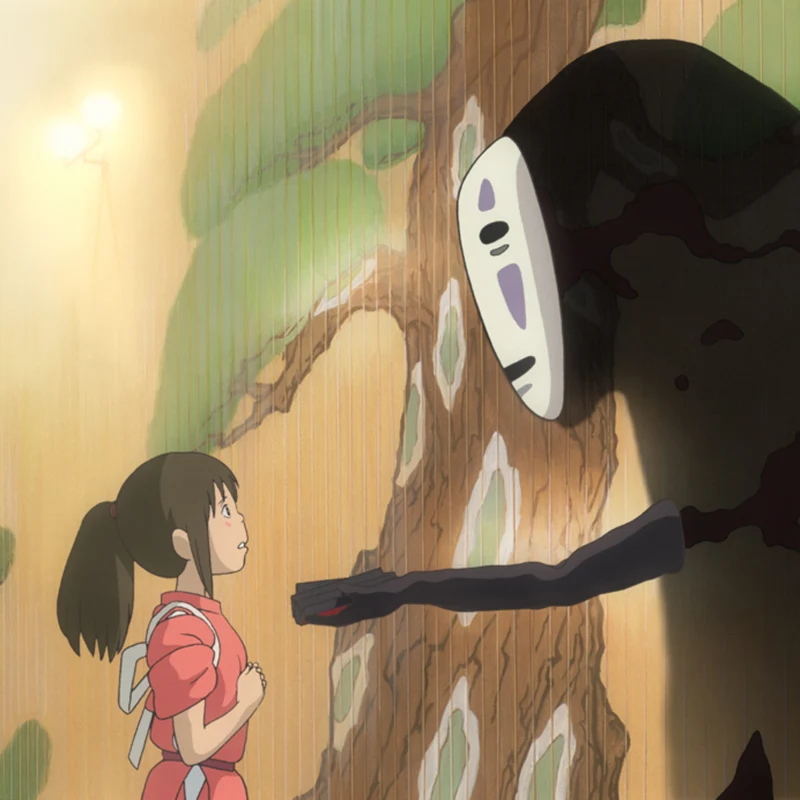
Miyazaki’s Oscar-winning feature, and one of Japan’s highest-grossing films ever, Spirited Away invites audiences into a mind-bending supernatural realm. A wrong turn on a family road trip lands 10-year-old Chihiro in a mysterious dimension populated by all manner of creatures, most memorably the enigmatic No Face. Yearning to find her parents and return to the real world, Chihiro must work at an enchanted bathhouse serving spirits of all shapes and sizes. A tour de force of surrealist invention, Spirited Away is a timeless wonder.
DIRECTOR: Hayao Miyazaki. WRITTEN BY: Hayao Miyazaki. CAST: Rumi Hiiragi, Miyu Irino, Mari Natsuki, Takashi Naito. 2001. 125 minutes. Japan. Color. Japanese (subtitled). 35mm. New subtitled print courtesy of the Academy Film Archive, with special thanks to Studio Ghibli.
All film screenings in the Hayao Miyazaki Encores series are available here .
Academy Museum film programming generously funded by the Richard Roth Foundation.
Back to Main Series
More in Series
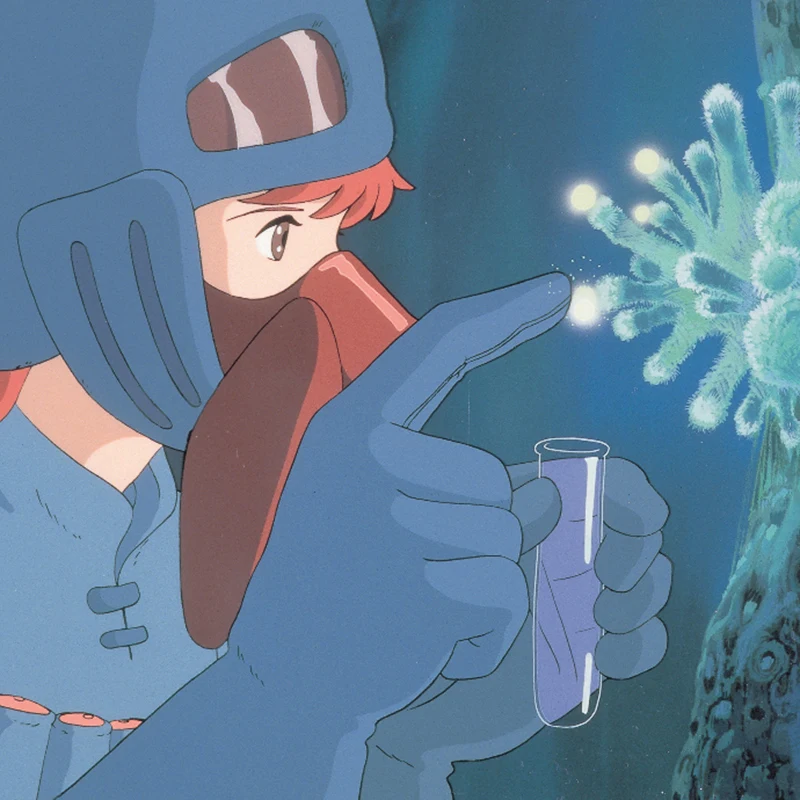
Film Program
Nausicaä of the Valley of the Wind
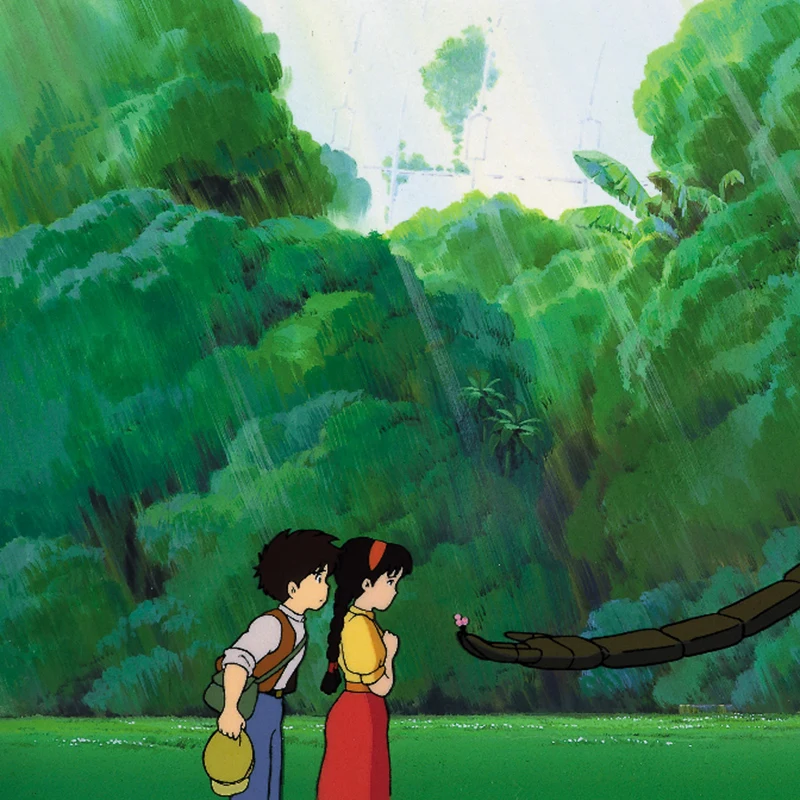
Castle in the Sky
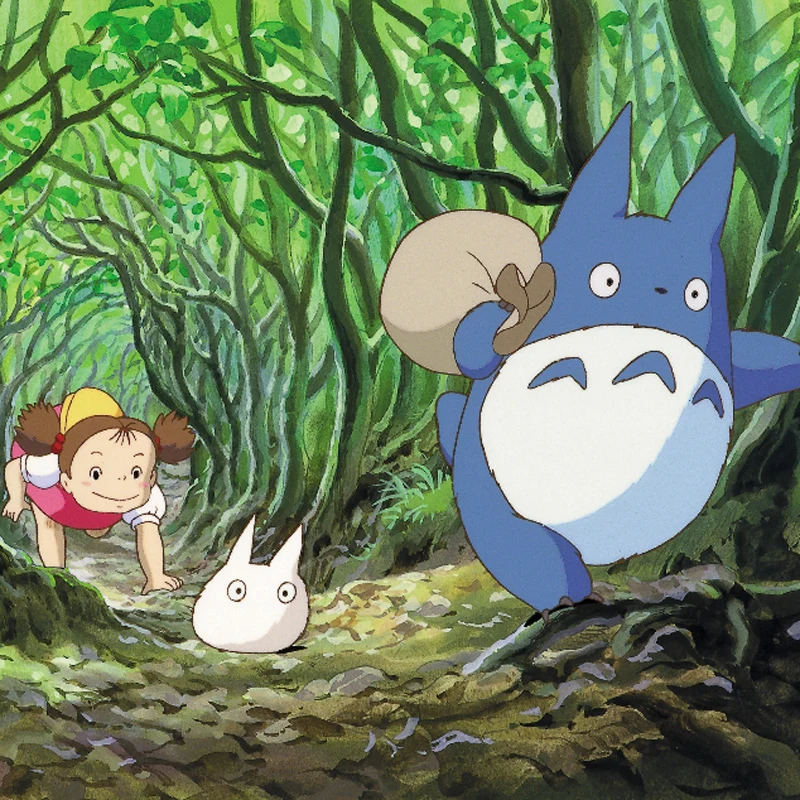
My Neighbor Totoro
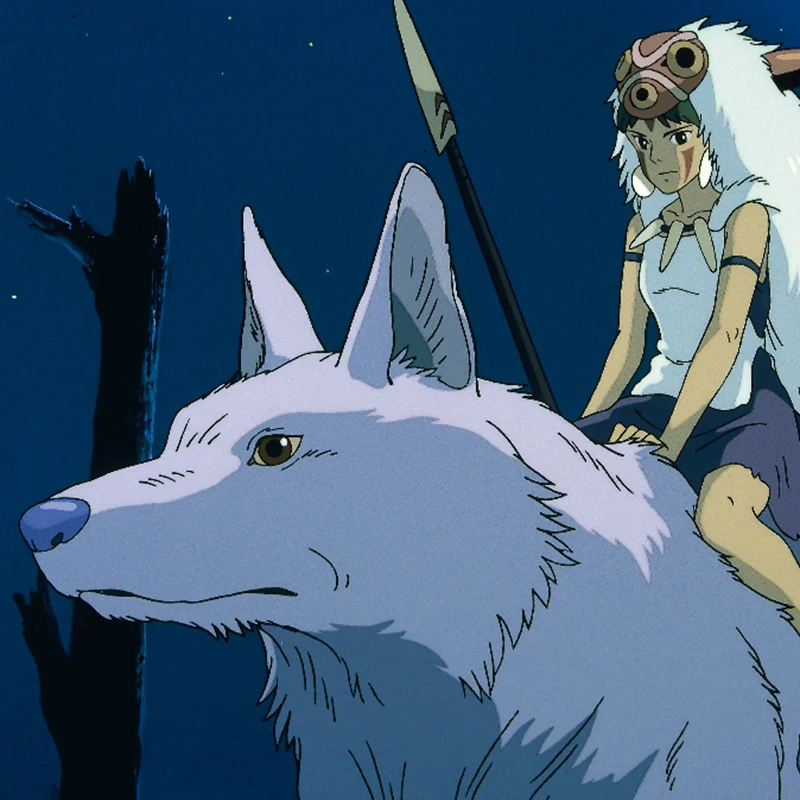
Princess Mononoke
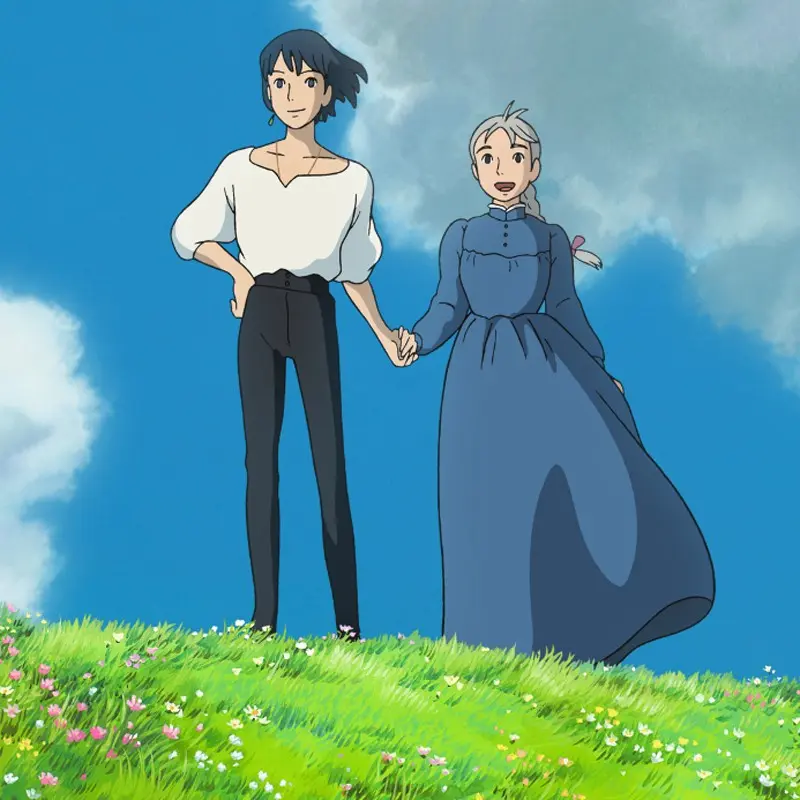
Howl's Moving Castle
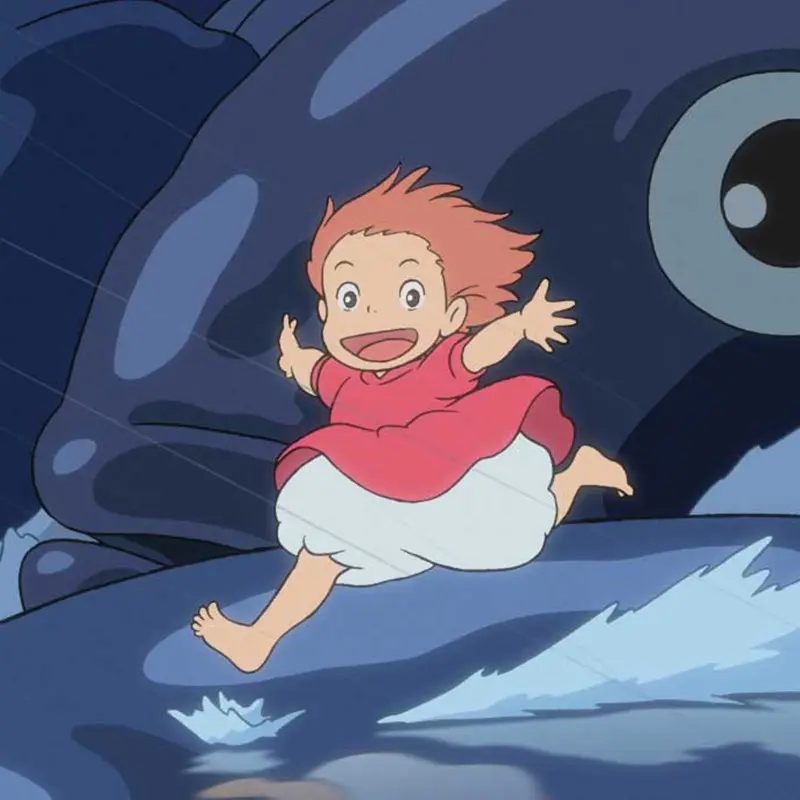
Ponyo Screening with Hayao Miyazaki Exhibition Discussion
Join Exhibitions Curator Jessica Niebel and Assistant Curator J. Raúl Guzmán before the screening of PONYO to learn about their curatorial process and the journey to build the long-awaited and unprecedented retrospective exhibition, HAYAO MIYAZAKI.
ThinkWritten
The Hero’s Journey: A 17 Step Story Structure Beat Sheet
The Hero’s Journey is a classic plot structure made up of 17 steps. Learn how to craft an epic story using the Hero’s Journey story beats.

We may receive a commission when you make a purchase from one of our links for products and services we recommend. As an Amazon Associate we earn from qualifying purchases. Thank you for support!
Sharing is caring!
The Hero’s Journey is a story structure that tells how a hero starts in one place, goes on an adventure into an unknown world, and then returns to what they started with.
This blog post will explain the 17 steps of the Hero’s Journey and share how you can use this common plot structure to write your own story or novel.
What is the Hero’s Journey?
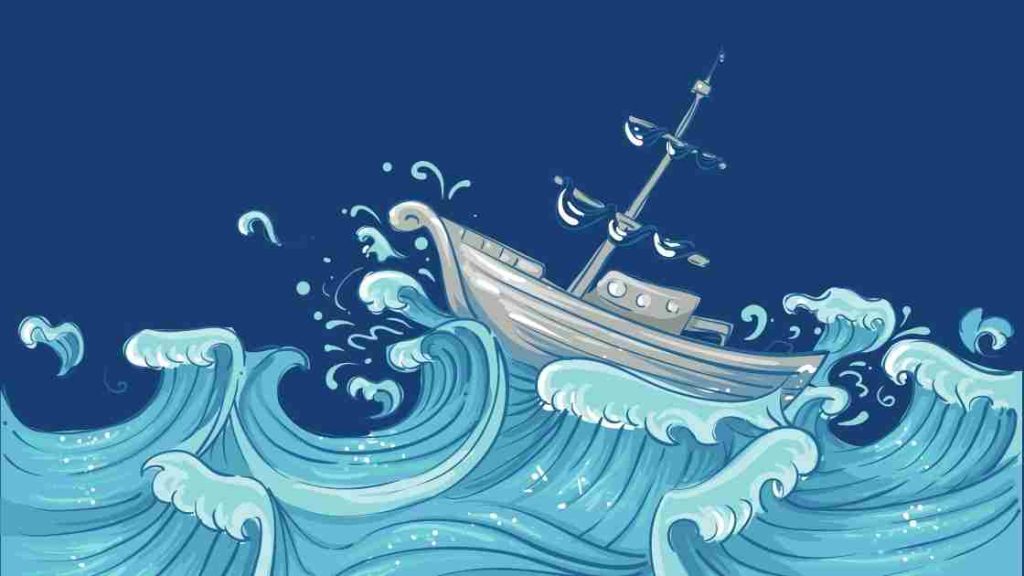
Joseph Campbell first introduced the Hero’s Journey in 1949. It is based on the idea that we can break down most stories into one basic story structure.
The plot structure of the Hero’s Journey is made up of 17 steps, all of which can be excellent guideposts for you when plotting your novel and planning your chapters.
To simplify the 17 steps of the Hero’s Journey, there are 3 main acts of the story: The Departure, The Initiation, and The Return.
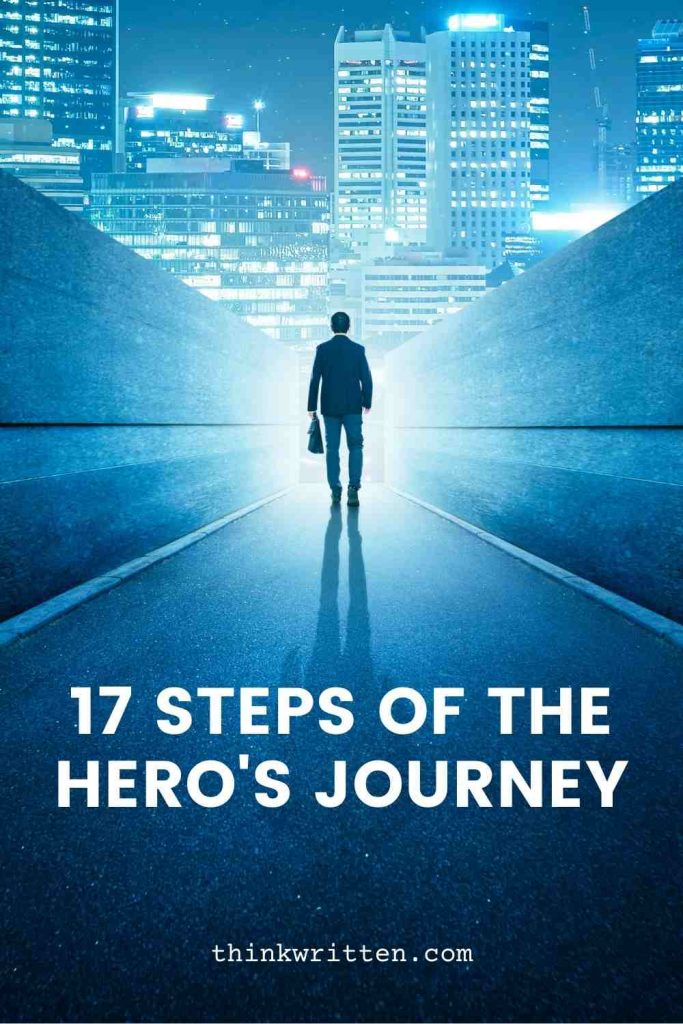
Here’s an overview of all of the 17 steps of Joseph Campbell’s Hero’s Journey:
Act One: The Departure
The Call to Adventure
Refusal of the call, supernatural aid.
- The Crossing of the First Threshold
Belly of the Whale
Act 2: The Initiation :
The Road of Trials
The meeting with the goddess, woman as the temptress, atonement with the father/abyss, the ultimate boon.
Act 3: The Return:
Refusal of the Return
The magic flight, rescue from without, the crossing of the return threshold, master of the two worlds, freedom to live.
In this post, we will cover each step of the Hero’s Journey and what it includes. If you are writing a novel , think of this as the ultimate beat sheet to help you plan and plot your novel !

To understand the 17 steps of the hero’s journey, we will share with you exactly what happens in each step and what it should include. We’ve divided the 17 steps into the three main acts: The Departure, The Initiation, and the Return.
Let’s dive on in, shall we?
The Departure

The Departure (Act 1) of the Hero’s Journey is all about your novel’s main characters and their ordinary lives. You want to show how they live before something happens that throws them into a world outside of what was normal for them.
In a nutshell, The Departure is when we see our heroes start in their current environment and set out on an adventure where they leave their comfort zone.
There are 5 steps of the Departure, each of which can help you base your chapters for your novel. Let’s look at these 5 steps in detail.
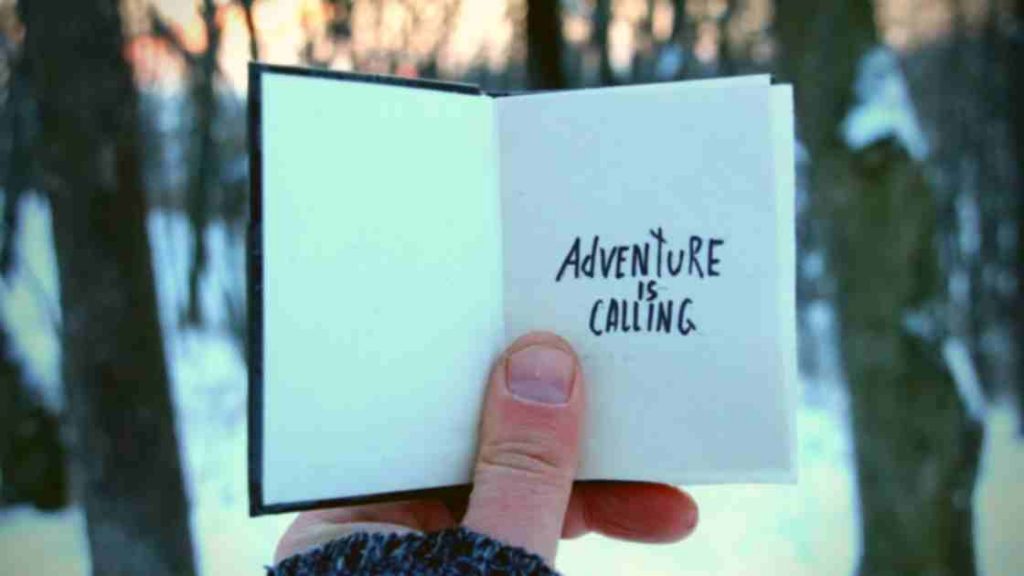
In the first 1 or 2 chapters of our book, our character is introduced and is given the call to adventure. Of course, the call to adventure is what sets our character on their journey. There is a moment when our hero realizes something isn’t right, and it’s time for them to become the hero of their own story.
The Call to Adventure should introduce your main characters and what part of life they are living before things start changing for them. You want this to be a scene that you can use to give your reader an idea of who they are and what their life is like.
The call to adventure is sometimes also called the inciting incident because it often comes from another character or situation in which our hero feels compelled to do something. This could come in the form of a problem or something that they’ve always wanted to accomplish.
Once we understand the character’s life and why they must go on their journey, we move onto the next crucial element: Refusal of the Call.

The Refusal of the Call sounds like it’s a bad thing, but in reality, it can help the hero grow and become more self-sufficient. In this step of the Departure, we see that our character isn’t sure if they are ready for such an adventure.
The refusal of the call is often used as a way for your reader to get more insight into some of your character’s weaknesses. It can also open up the character to seeing what they are missing in their life and get them a little more excited about going after it.
When writing your story, you will show your readers why your hero is reluctant to go on the journey. Why don’t they want to change? What are their fears? This step helps build your character arc, as well as builds some suspense in the story.
You also want to make sure in this step that the refusal of the call is resolved in some way. This can be through another character encouraging your hero or by realizing what they are missing out on if they don’t go on the journey.
Either way, you need to ensure this scene or chapter ends with the hero deciding to accept the challenge.
After your main character decides whether or not they want to go on this journey, we move onto Supernatural Aid.
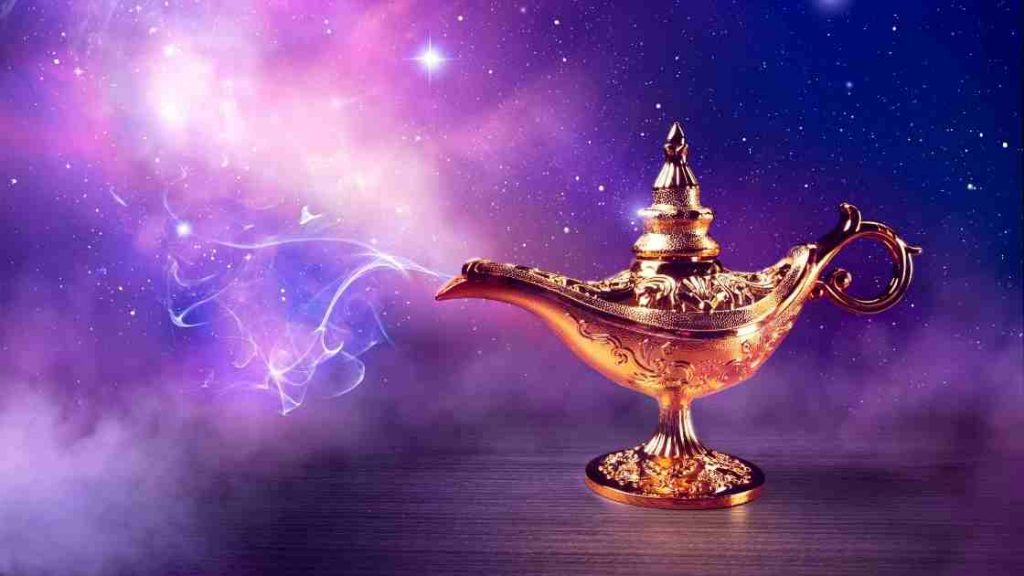
Supernatural aid is the hero’s first experience with a mentor or teacher. While we use the term supernatural here, it does not necessarily have to be some mystical being.
It could be a random stranger giving our hero advice or someone who has been to this magical place before and knows the path. The important thing is this character is someone who will help your protagonist in their journey.
Supernatural aid helps your audience understand there will be obstacles along the way. The hero will need help. You will need a strong supporting character willing to give our main character advice on how they should proceed through their journey.
In this scene, you want to show us why you chose these characters for mentors. What qualities do they possess? Do they have experience with adventures like this? Why can they help the hero, and more importantly, why do they want to help the hero?
Once this person is introduced, we are ready for the next stage of the Hero’s Journey: Crossing the First Threshold.
Crossing the First Threshold
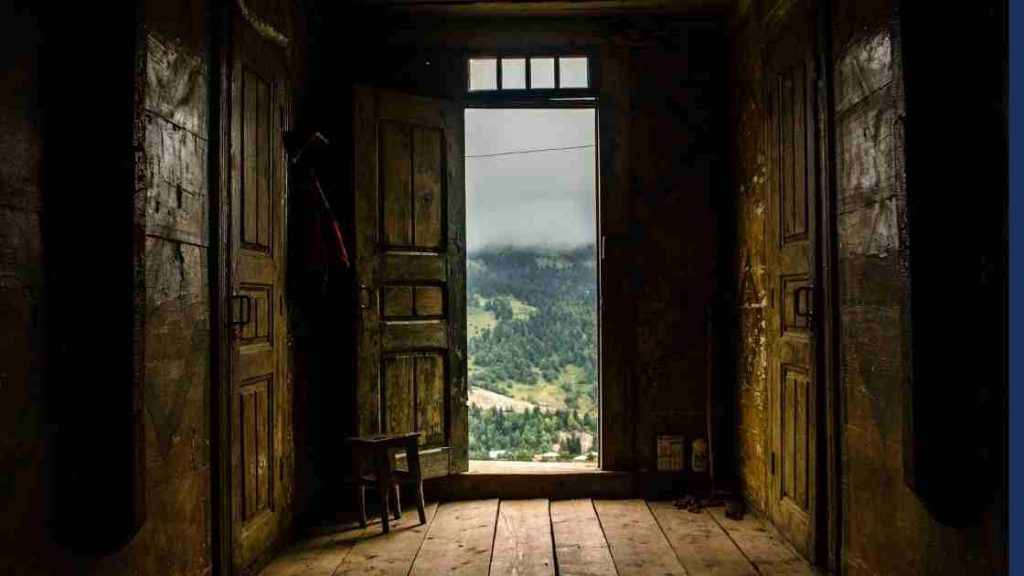
Crossing the first threshold is where your hero commits to going on the journey. They may have made some attempts at it before, but now they are fully committed and ready to go, even if that means leaving their comfort zone behind.
Your character will be doing something different than what they’ve done in the past, or perhaps this act will lead them into a dark and dangerous place.
For example, your hero may leave their home for the first time to go on this journey, or they are finally ready to go and confront someone who has been standing in their way of happiness.
In this 4th step of the Hero’s Journey, you want to show your reader why this is such a big change for the character.
You want to show your character scared and uncertain of what lies ahead for them while still being brave enough to continue on their journey! You don’t need to make this scene too long or spend time explaining every little detail; just put us in the headspace of your hero so we can understand what unknown dangers and fears are ahead.
Once our hero takes their first steps towards danger, we find ourselves in the Belly of the Whale.
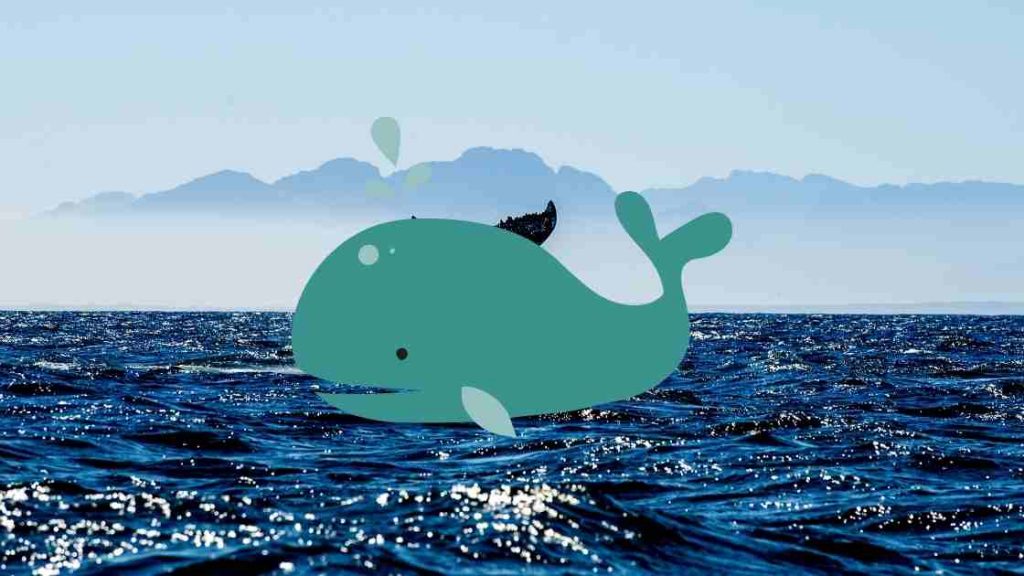
The Belly of the Whale is the last step before the hero breaks away from their normal existence and sense of self. When someone enters this stage, they are showing that they want to change.
A typical element of the Belly of the Whale Scene is displaying a small problem or threat. These problems aren’t the major conflict of the story, but it is enough of an obstacle that we see the hero absolutely cannot go back to where they used to be and must change.
In this scene, it’s common to show a “dark night of the soul.” This is where they feel like everything in their life has been turned upside down, and things seem hopeless. Yet, they must commit to making a change and continuing on their journey in this final step of the Departure stage.
Now that we’ve covered all the steps of the Departure state let’s move onto Act 2: The Initiation.
The Initiation
The second act of our story, the Initiation, is the part where things get interesting. The character is now deeper into their journey and facing new challenges that they must overcome.
Not only are we focusing on our hero’s personal development, but our protagonist’s character traits start to change. They will be showing how they’ve become different from who they were in Act One and developing the traits needed for a successful journey.

The first scene or chapter of the Initiation stage of the Hero’s Journey is The Road of Trials. The Road of Trials is where the protagonist faces a series of tests that your hero must pass to move onto the next stage.
These trials will continue until our hero has shown they are ready for whatever is waiting ahead on their journey and have discovered what lessons they needed to learn along the way.
Usually, there is a series of 3 tests, and your hero will not ace all of them immediately. Sometimes, we will revisit the person introduced as a mentor or guiding force from Act One in these scenes, as the hero will certainly need some support in going through these trials.
In this scene, you want to make sure your reader sees how the hero experiences growth and changes. You want your reader to appreciate how far our hero has come along their journey, but there are still more experiences ahead for them!
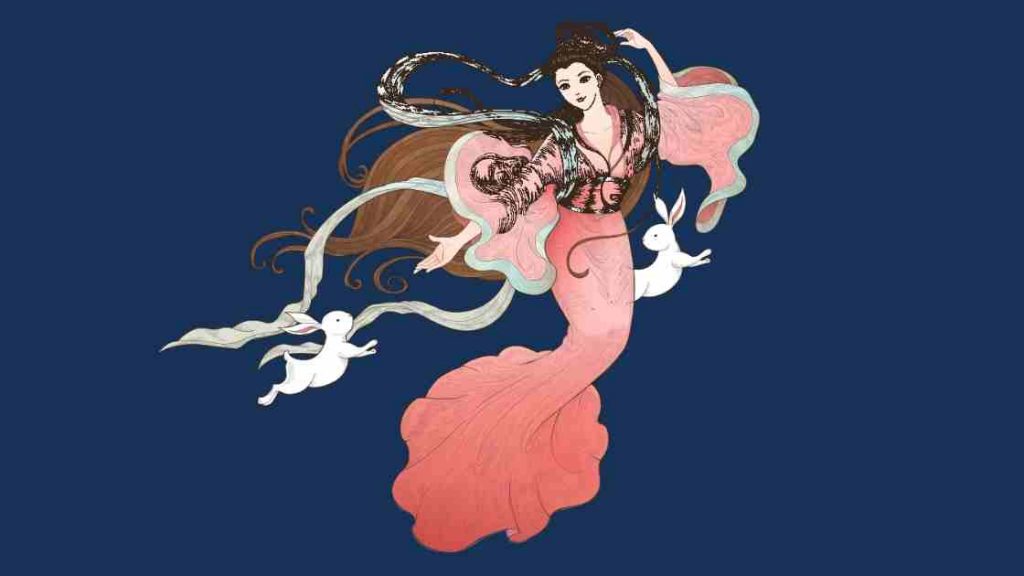
The next step of the Initiation stage is The Meeting with the Goddess/Saviour. This is where we are introduced to someone who will give our protagonist a sense of love, peace, safety, and unity.
This character is essential because they offer our protagonist something he didn’t have before and will be the support that helps them through whatever journey lies ahead. Sometimes they appear as a love interest, but not always.
The Goddess figure is often human but could also be an animal or nature spirit. They are someone who will help your hero become whole again. They are an equal opposite of your hero.
In this scene, we want our hero to feel everything is going to be okay now. They will learn that they don’t need to face their problems alone; someone here with them understands what they are going through.
Of course, this doesn’t last forever as we move into the next chapter: Woman as the Temptress.
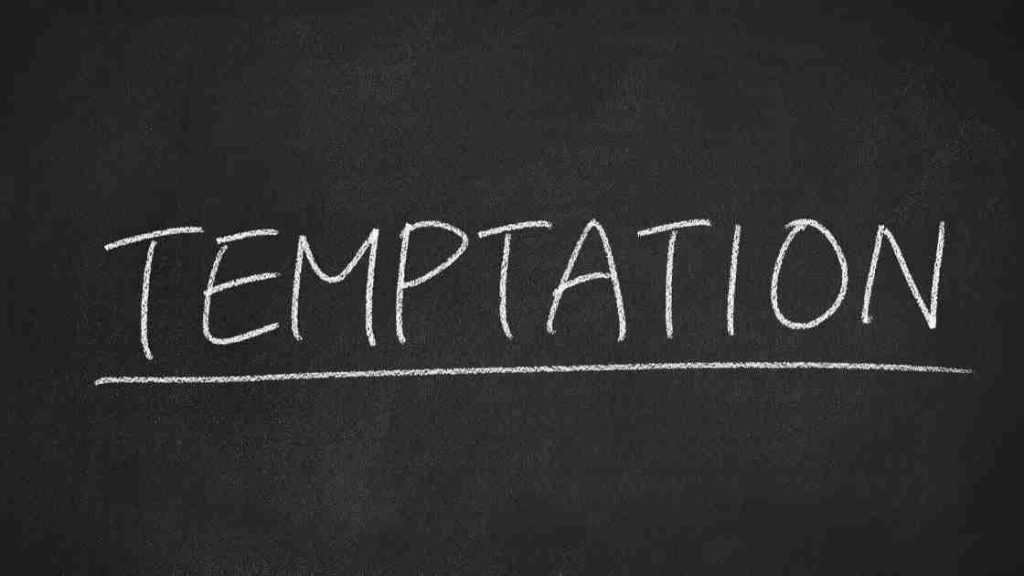
In this next step, the hero faces physical temptations that might cause them to be distracted from their quest. Again, it’s important to understand this does not mean you need to introduce a female character in this scene – the woman is only a metaphorical symbol.
Many things can tempt our heroes to stray from their path. It might be money, power, or fame. It could even be something as simple as food and drink. But, of course, these temptations are not meant actually to distract the protagonist from their path. Our hero must resist them to gain a greater reward at the end of this stage.
Throughout this scene, they may face several such temptations until our hero learns how to resist them and stay focused on what they really want.

The word Atonement means “reparations for a wrong or injury,” and the Father is a symbol for an authority figure in the hero’s life. Finally, the Abyss represents death or darkness.
In this scene, the hero must confront whatever it is that holds the most power over them. This could be another character or it could even be internal conflict where the hero must come face-to-face with the dark side of their personality and be willing to embrace it.
The goal of this step in the Hero’s Journey is to make your protagonist question their entire being. Only when they confront the most powerful obstacle in their path and reconcile with it can they move forward on their journey.
As with most characters, the father does not have to be an actual father or even a male figure. The important thing is this figure is a person of power and authority over the hero.
There are many ways the hero can reconcile with the father figure – they can defeat this person, win this person’s approval, or reconcile with a part of themselves that is related to the father.
This step is important because it forces your protagonist to face their biggest fears and insecurities. It gives them the opportunity and confidence boost to overcome these obstacles once and for all.

Apotheosis is another word for “the highest point of a person’s spiritual, moral or intellectual development.” It is when the protagonist transcends their humanity and becomes something more than they were before.
In this step of The Hero’s Journey, your protagonist will undergo an important change that brings them closer to being the ideal self they set out to be at the beginning.
In this stage of the Hero’s Journey, our hero learns something new about themselves that prepares them for the hardest part of their journey. This revelation gives them the necessary knowledge to complete their quest.
This step is often referred to as “the answer.” The protagonist will usually gain this new insight from a character who embodies wisdom or spiritual power, such as their mentor figure.
Now that our character has finally grown to where they need to be to accomplish their quest, they are ready for The Ultimate Boon’s next step.

The ultimate boon is the fulfillment of the purpose of the journey. This is when the hero finally achieves what they set out to accomplish.
All of the previous steps of the journey worked to this point to help the hero finally reach their goal.
In mythology, the “boon” is often something otherworldly. It could be the fountain of youth, an ancient scroll with sacred information, or a magical potion.
There are many ways to play out this step of The Hero’s Journey, so your character’s end goal will determine what the boon is.
This step of The Hero’s Journey often includes a battle with something that opposes your protagonist, such as an enemy or villain.
Our heroes might have to face their own dark side to achieve this final prize and complete their journey successfully. This could cause them to question whether or not they even want what the boon is.
When your protagonist achieves this final goal, it marks a major change in their life. Now we are ready to proceed to Act 3: The Return.
Act 3: The Return

Act Three of the Hero’s Journey often moves faster than the other acts of our story. In The Return, we see how the protagonist’s newfound knowledge and achievement of their goal affect their life and world.
This step of The Hero’s Journey is crucial because it gives us a glimpse as to what our character has learned from this journey, which is the ultimate test of whether they have truly successfully achieved their quest or not.
Let’s dive into the remaining scenes of our story.
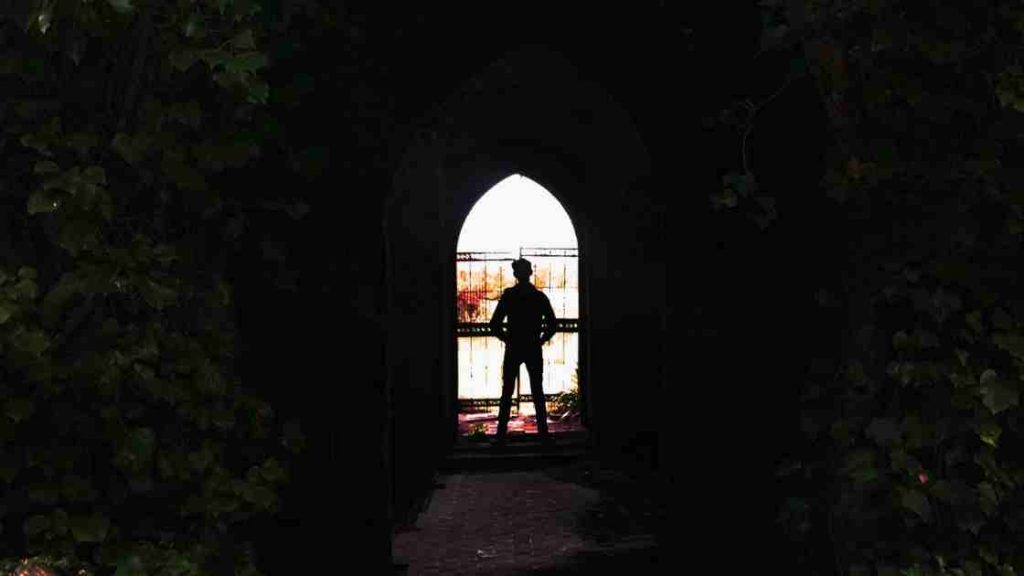
The Refusal of the Return is when our protagonist does not want to return home after achieving their goal. They may be too frightened of what awaits them, or they may not want to give up the new life and world they have found themselves in.
Just as they were hesitant to go on the adventure in the beginning, they are also hesitant to go back.
They may be concerned with how their “boon” might affect the world – such as a magic potion or secret power that could get into the wrong hands. They may worry about what consequences they may face when they go back, or they may be afraid nothing is left for them to return to.
In some cases, our hero doesn’t want to leave because they have become comfortable with their new world and who they have become.
However, to truly finish the quest, our hero must return home. This refusal of return helps build up the tension to the final resolution of the story. This is when the reader questions whether the hero will return home – and wonders with great anticipation of what might happen when it happens.

The Magic Flight is the final conflict to the story where our protagonist must escape danger, sometimes using their newfound knowledge or boon. This is a way of symbolically proving that they have truly learned from this journey and are ready to bring it back home with them.
This part of The Hero’s Journey often involves a chase scene or battle against an opposing force. However, this is the final push necessary push they need to realize they must make the journey home because it becomes apparent they cannot stay where they are.

The Rescue From Without step of the Hero’s Journey is when the protagonist is rescued from danger by an outside source.
This outside source may be an ordinary person, or it might resemble deus ex machina, or god-like intervention, where something rescues our hero from an impossible situation, such as lightning striking that saves the day for our hero.
When you are writing the rescue scene, the circumstances of the rescue must be believable. Most people do not like the deus ex machina in writing simply because it’s too easy.
Those of us who have lived life long enough all know that a magic fairy godmother isn’t going to swoop us in, wave her wand and make all our problems disappear.
After being rescued, the hero truly has no other choice except to return home.

The Crossing of the Return Threshold is when our protagonist finally returns home after completing their adventure and achieving their goal.
This is the part of The Hero’s Journey where we see what they have learned from this journey and how it affects them.
In this story scene, you will want to answer the following questions: How has the hero changed from their journey? How is their old world different from when they left? How do they acclimate to being back home? Finally, how do others react to their return?

This is the part of The Hero’s Journey where our protagonist has reached their full potential. They have overcome their fears and grown in ways they could never have imagined.
They are a new person and have been forever changed by what they’ve experienced. Yet, it allows them to go back into society with heightened wisdom, power, skills, or resources that will help others in need when called upon again.
In this scene, we see the hero apply their knowledge and share it with the world.

After our hero has conquered all of their fears and has put their wisdom to good use, the hero finally has the freedom to do anything they want.
This is the resolution of our story – we see our heroes accomplish their “happily ever after.” Their fears or concerns no longer control them, and nothing exists between them and what they want.
More often than not, this closing chapter of the story gives the reader some closure. We want some type of affirmation that the story is truly complete. We get a glimpse of what our protagonist will do with their life now that they are free to live it.
If you’re looking for a story structure that is proven and effective, the Hero’s Journey might be perfect for you. With 17 stages of development, it will help you create an engaging plot with your readers and develop strong characters .
And of course, while the Hero’s Journey is the classic beat sheet for writers, remember you don’t always have to dedicate one chapter to each step. Sometimes you can combine 2-3 steps in one scene, while other steps might take several chapters to cover.
The important thing is you now know the Hero’s Journey! We hope this is helpful for you – whether you are writing your own novel or studying the Hero’s Journey arc in literature. Most of all, we hope that by breaking down each step of the Hero’s Journey, you can better understand all of it.
Do you have any thoughts or questions on the Hero’s Journey? We’d love to hear from you in the comments section below!
Chelle Stein wrote her first embarrassingly bad novel at the age of 14 and hasn't stopped writing since. As the founder of ThinkWritten, she enjoys encouraging writers and creatives of all types.
Similar Posts

10 Tips for Writing a Novel
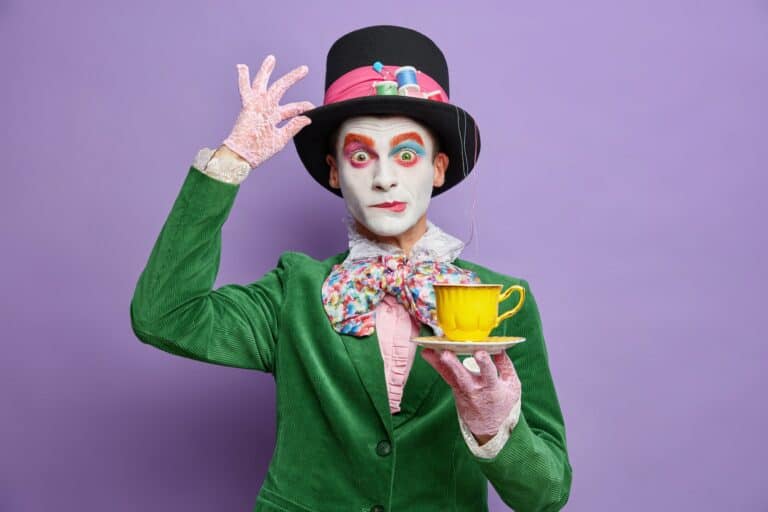
What is a Protagonist?
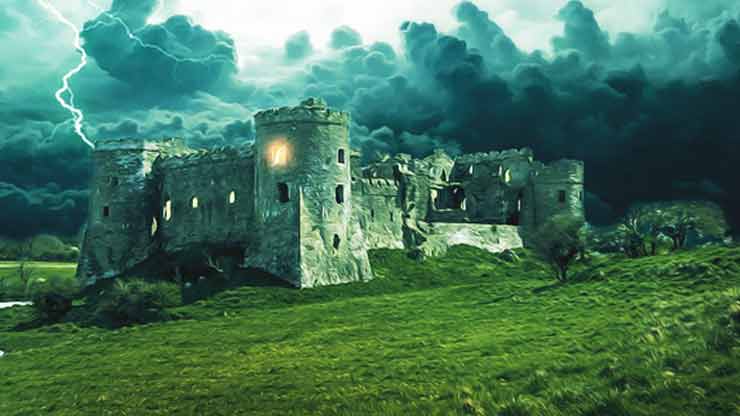
5 Signs of a Strong Novel Plot

How to Write a Short Story

How to Show – Not Tell – in Your Writing
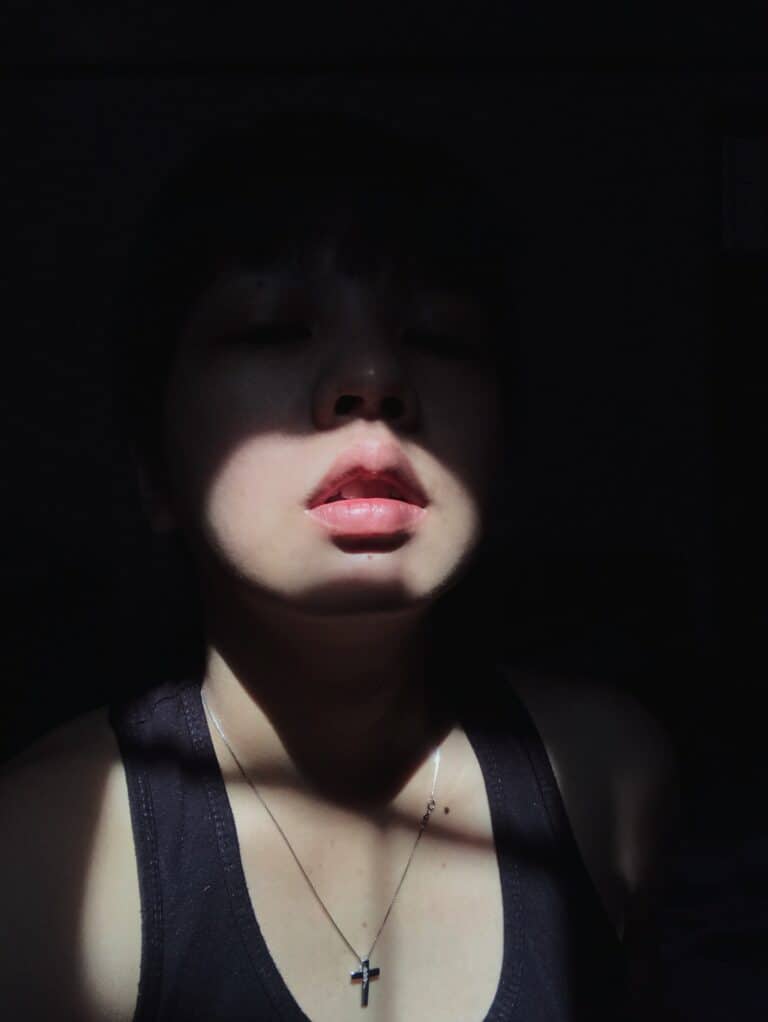
What is a Deuteragonist?
So if you’re writing an epic fantasy that will be a series, are these 17 steps strung out across the entire series, or redone in each book?
Thank you for such a helpful article. This has helped me fill in a glaring hole in my novel outline and shown me what was missing. I’m really grateful for this advice.
Glad it was helpful for you Laura!
Leave a Reply Cancel reply
Your email address will not be published. Required fields are marked *
Save my name, email, and website in this browser for the next time I comment.

Peter S. Beagle on his new novel, the hero's journey, and why villains talk so much
SCOTT SIMON, HOST:
Something big threatens the kingdom of Bellemontagne - many somethings, which prefer their humans roasted. The new novel "I'm Afraid You've Got Dragons" is about that threat and also about reluctant heroes and an evildoer who just can't keep his yap shut. It's by Peter S. Beagle, who celebrated for his 1968 novel "The Last Unicorn," which, of course, charmed generations of young and not-so-young readers. Peter S. Beagle joins us from Berkeley, Calif. Thanks so much for being with us.
PETER BEAGLE: It's a pleasure, truly, to be here.
SIMON: Tell us about the dragons in the kingdom and the surrounding kingdoms. Come in all shapes and sizes, don't they?
BEAGLE: Well, in the world of the heroes, dragons mostly have shrunk down. Only the forest folk vaguely remember the really big ones. Mostly, the hero himself is an eliminator of dragons. Dragons are like cockroaches, are like small animals you can't get rid of. And it's his job to clear them out. He hates doing it. He's always hated it.
SIMON: Yeah. We should explain your hero is - forgive me any mispronunciation - Gaius Aurelius Constantine Heliogabalus...
BEAGLE: Gabalus. Heliogabalus.
SIMON: ...Thrax. But we can call him Robert, right?
BEAGLE: He'd really prefer it.
SIMON: Does he feel a kinship with dragons?
BEAGLE: Yes, and he doesn't know why. Much of the time, he doesn't want to think about it. It's nothing that he wants to know. That's true for most of the characters in this book. The princess doesn't want to be a princess.
SIMON: Princess Cerise. Yeah.
BEAGLE: Prince Reginald doesn't particularly want to be a prince. What he mostly wants to do is go off somewhere where his father can't bother him and just lie in the grass and think about things and get drunk. That would be nice.
SIMON: (Laughter) What makes a hero? This is a subject you've returned to in your novels.
BEAGLE: Well, in my own experience, there are very few heroic deeds I've gotten through in my life. And each time, I didn't want to do it. I knew exactly what I had to do, and I did not want to do it. And so I understand Robert. I understand his position altogether too well.
SIMON: Let me ask you about the wizard in the book 'cause he can't keep his yap shut about what he's hellbent on doing. Why is that?
BEAGLE: Well, you can't possibly blame him. After all, he has been destroyed and come back. He has ridden with dragons. He knows so much about dragons, just not the important stuff. But because of his experience, he thinks he knows more than he does. And that's fatal. I know that myself.
SIMON: That's happened to you?
BEAGLE: It has. It has. Not with dragons, particularly.
SIMON: Yeah.
BEAGLE: But with everything from the English language to automobile engines. Yeah, it's happened.
SIMON: It's been 56 years since "The Last Unicorn."
BEAGLE: Boy, that was quick.
SIMON: How does that feel?
BEAGLE: Very strange some nights when I lie in bed and think about it. And at my age, I do think about those things. The main thing is, I don't know if I've done my best work yet. You always hope there's something beyond what you've done. What worries me about this book is that I like it. I never like books when I'm through with them. I always know what I've screwed up. And by the time I've figured that out, the book is already published. There's nothing to do, but go back and do the next one. With this one, "I'm Afraid You've Got Dragons," I actually like it. I've asked friends, will somebody please tell me how I've screwed this one up? So far, nobody has.
SIMON: I liked it. I don't think you screwed up anything.
BEAGLE: Maybe. Well, I'm old enough. Maybe I finally got away with it.
SIMON: (Laughter) Can fantasies help us get hold of the real world all around us?
BEAGLE: In a strange way, it's the only way I've ever gotten hold of the real world. In honesty, much of the time, I'm faking it. Maybe other people are. But mostly, that's what I do. I only know how to tell stories. Everything else I've just done the best I could. I raised children. I've held one or two jobs, but I've always known I'm supposed to tell stories. That's it. And the best I can do is tell them the best I can. Beyond that, at my age, I've gotten very good at pretending I know what I'm doing. Sometimes I even believe it myself.
SIMON: You're in your 80s, right?
BEAGLE: Eight-five as a week or so ago.
SIMON: Happy birthday.
BEAGLE: Thank you.
SIMON: You know, there are millions of readers all over the world who want to say thank you to you.
BEAGLE: I hope so. They write to me letters, and I'm very grateful. I always answer the letters.
SIMON: I must say this book has totally changed the way I think of dragons.
BEAGLE: Good, because it changed mine. Rather, I've always thought about dragons. Somebody did write to me wishing I had told more about dragons. Maybe I will another day. But right now, I'm glad I was able to say as much as I did.
SIMON: Peter S. Beagle, his new novel "I'm Afraid You've Got Dragons." Thank you so very much for being with us.
BEAGLE: It's been a great pleasure, more than I can tell you. Transcript provided by NPR, Copyright NPR.
NPR transcripts are created on a rush deadline by an NPR contractor. This text may not be in its final form and may be updated or revised in the future. Accuracy and availability may vary. The authoritative record of NPR’s programming is the audio record.
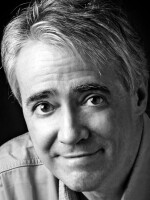
- Work & Careers
- Life & Arts
Become an FT subscriber
Try unlimited access Only $1 for 4 weeks
Then $75 per month. Complete digital access to quality FT journalism on any device. Cancel anytime during your trial.
- Global news & analysis
- Expert opinion
- Special features
- FirstFT newsletter
- Videos & Podcasts
- Android & iOS app
- FT Edit app
- 10 gift articles per month
Explore more offers.
Standard digital.
- FT Digital Edition
Premium Digital
Print + premium digital, ft professional, weekend print + standard digital, weekend print + premium digital.
Essential digital access to quality FT journalism on any device. Pay a year upfront and save 20%.
- Global news & analysis
- Exclusive FT analysis
- FT App on Android & iOS
- FirstFT: the day's biggest stories
- 20+ curated newsletters
- Follow topics & set alerts with myFT
- FT Videos & Podcasts
- 20 monthly gift articles to share
- Lex: FT's flagship investment column
- 15+ Premium newsletters by leading experts
- FT Digital Edition: our digitised print edition
- Weekday Print Edition
- Videos & Podcasts
- Premium newsletters
- 10 additional gift articles per month
- FT Weekend Print delivery
- Everything in Standard Digital
- Everything in Premium Digital
Complete digital access to quality FT journalism with expert analysis from industry leaders. Pay a year upfront and save 20%.
- 10 monthly gift articles to share
- Everything in Print
- Make and share highlights
- FT Workspace
- Markets data widget
- Subscription Manager
- Workflow integrations
- Occasional readers go free
- Volume discount
Terms & Conditions apply
Explore our full range of subscriptions.
Why the ft.
See why over a million readers pay to read the Financial Times.
International Edition
- Go to the main navigation
- Go to the content
- Go to search
- SÉLECTION OFFICIELLE
- CINÉMA DE DEMAIN
- MARCHÉ DU FILM
- Online ticket office
- Hide the search
- Show the main navigation
Jacques Rozier, the journey of a multi-faceted filmmaker
- Official Selection
- By Benoit Pavan, published on 19.05.2024
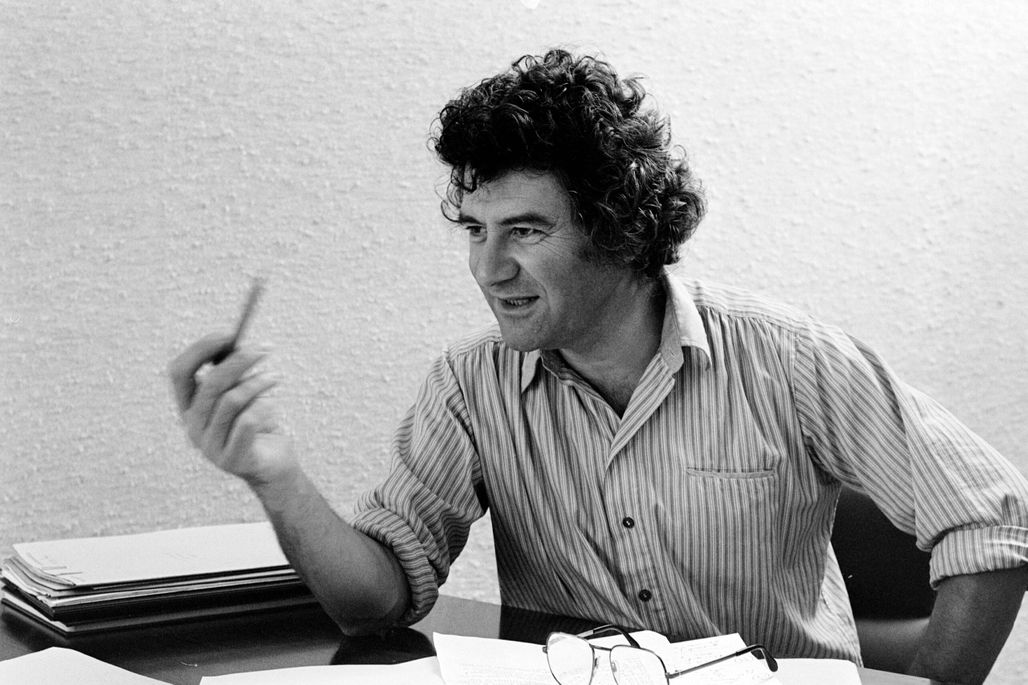
In Jacques Rozier, From One Wave to Another , ( D’une vague à l’autre ), his documentary presented at Cannes Classics, Emmanuel Barnault brings us a chronological portrait of this multifaceted and versatile filmmaker, who worked tirelessly throughout his career to maintain his artistic integrity, even if it meant becoming less prolific.
How did this documentary project come to you?
It all comes down to a love of film. I entered the free-spirited world of Jacques Rozier through my father, who was a film distributor. In the 1980s, he worked for the company that distributed Maine Océan, Rozier’s fourth feature film, which won the Jean Vigo Prize in 1986. This work was a revelation to me, because I felt like I was at the cinema and on holiday at the same time.
That’s often how people feel when watching Jacques Rozier’s films…
That’s true. Time seems to fly by, and he plays with space and time. That’s one of the joys of his cinematography. The project also came about through the anti-hero character portrayed by Bernard Menez in his films. His awkward, clumsy manner made me laugh. About ten years ago, I wanted to make a documentary about the relationship between Rozier and Menez, but the project didn’t come to fruition. A year ago, when Jacques Rozier passed away, I had the idea to create an archive film, with the use of audio and audiovisual excerpts.
Why did you choose to let Jacques Rozier tell his own story?
I don’t like narrators. I avoid voiceovers and commentary. I prefer to go against the grain and let the protagonist(s) tell their own story. I also had access to several outside contributors like Pascal Thomas, François Truffaut, Serge Toubiana, Serge Daney, and Bernard Menez who could do this very well!
How did you structure the documentary?
I built the film on a sort of thematic chronology, but it was clear that I needed to start with the milestone that is the Nouvelle Vague . Blue Jeans (1958), along with La Pointe Courte by Agnès Varda, are the two films that launched the movement. I also wanted to include a segment on his work as a television director at a time when TV was still very much in the experimental stage. The only regretful thing, when it comes to Jacques Rozier, is that his filmography is sparse: he only directed four feature films and three short films.
Why is that?
He had a conflicted relationship with money. As a filmmaker, he always sought to maintain his independence, so he struggled to adjust to production models. Some people enjoy a certain level of freedom because they have a lot of funding at their disposal, while others prefer to retain complete control of their projects to maintain that freedom. Rozier was in the latter camp, also because he found it hard to delegate. He was very demanding and wanted to do everything himself.
What role did his love of music play in his career?
Jacques Rozier was as much a music lover as he was a cinephile. He was particularly attentive to the musicality of voices. He often cited Marcel Pagnol as one of his favourite directors, especially for the musicality of the dialogues, as well as Vincente Minelli. He actually would have liked to make musicals. As a filmmaker, he knew how to take his time, but his films follow a deliberate tempo. Rozier was a rare specimen. His versatility was a result of his love for artistic expression. He was a filmmaker who lived in his own bubble, which is what made him so extraordinary.

JACQUES ROZIER : D’UNE VAGUE A L’AUTRE by Emmanuel BARNAULT – Trailer
A production by INA and mk2 Films with the participation Ciné+. Jacques Rozier, the independent and uncompromising journey of a director who refused to toe the line, admired by his peers and cherished by critics.
In the presence of Emmanuel Barnault and Laurent Vallet, president and CEO of the INA.

- Uncategorized
- 20.05.24 19:40

- 20.05.24 14:00
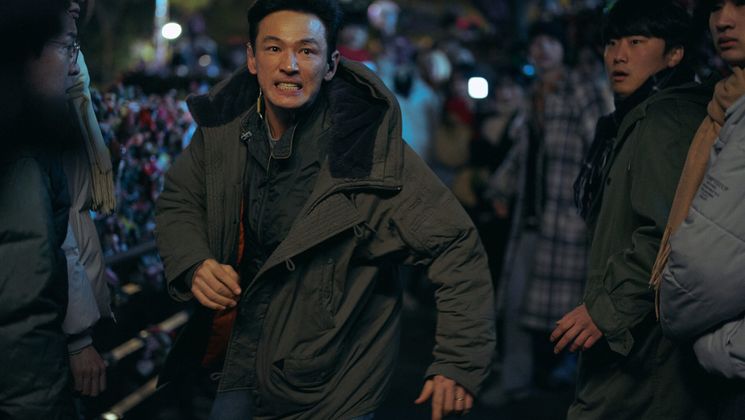
- 20.05.24 13:00
You may also like 76 years of cinema with the Festival
- Show the search
- Immersive competition
- Your Festival Experience
77 th EDITION
- The Festival
- 77 years of Festival
- A Festival with a conscience
- They support the Festival
Find all the news of the Festival de Cannes
- Festival de Cannes – facebook
- Festival de Cannes – Twitter
- Festival de Cannes – Instagram
- Festival de Cannes – linkedin
- Festival de Cannes – Youtube
- Festival de Cannes – Tiktok
May 14-25, 2024
- Official Shop
What to stream this week: 'Dune 2' adds spice, J.Lo heads to space, Lenny Kravitz rocks
This week’s new streaming entertainment releases include an album by Lenny Kravitz, “South Park” mocking weight loss drugs and Denis Villeneuve’s “Dune: Part Two” hitting the streaming service Max
“Dune: Part 2,” Jennifer Lopez in the sci-fi action pic “Atlas” and a “South Park” episode skewering weight loss drugs are some of the new television, movies, music and games headed to a device near you.
Also among the streaming offerings worth your time as selected by The Associated Press’ entertainment journalists : A spectacular documentary on the Blue Angels, Shay Mitchell explores drinks around the world and Lenny Kravitz is back with his first full-length album in six years, “Blue Electric Light.”
NEW MOVIES TO STREAM
— The spice will flow on Max starting Tuesday when Denis Villeneuve’s “Dune: Part Two” finally hits the streaming service. The film continues the saga of Paul Atreides (Timothée Chalamet) as he learns the ways of the desert-dwelling Fremen following the death of his father in “Part One.” It’s also a decidedly more action-packed spectacle than the first film, introducing a slew of new characters including the demonic Feyd Rautha played with scene-stealing menace by Austin Butler. In his review, AP Film Writer Jake Coyle wrote that “Like its predecessor, ‘Dune: Part Two’ thrums with an intoxicating big-screen expressionism of monoliths and mosquitos, fevered visions and messianic fervor — more dystopian dream, or nightmare, than a straightforward narrative.”
— A different kind of eye-popping spectacle will also be available on Prime Video on Thursday in the documentary “The Blue Angels” about the daring U.S. Navy pilots who have thrilled air show audiences since 1946. Produced by J.J. Abrams and “Top Gun: Maverick” star Glen Powell, filmmaker Paul Crowder got unprecedented access to the pilots both on the ground and in the air to give audiences a front row seat to the show. They filmed the stunts using a helicopter with a mounted IMAX-certified camera – it was the first ever civilian aircraft that was allowed to fly in their performance airspace – and, unlike in “Top Gun: Maverick,” there was no staging or second takes.
GET CAUGHT UP

Trump’s immigration plans could deal a major blow to the job market

Who is Mohammad Mokhber? Iran taps acting president after Raisi’s death.

Taiwan swears in new president, stands up to Chinese aggression

Two teen prodigies shocked America with a cynical murder 100 years ago

There’s more than one type of anxiety. Here are tips to cope.
— The ever-prolific Jennifer Lopez has another movie on the way already in the sci-fi action pic “Atlas,” debuting on Netflix on Friday, May 24. She plays the titular character, a data analyst who must learn to trust AI in order to save humanity, in a cast that includes Simu Liu, Sterling K. Brown and Mark Strong. Lopez has said that at its core, it’s a love story. “Atlas” was directed by “San Andreas” helmer Brad Peyton.
— AP Film Writer Lindsey Bahr
NEW MUSIC TO STREAM
— Lenny Kravitz is back with his first full-length album in six years: “Blue Electric Light.” (The album follows 2018’s “Raise Vibration.”) It is a testament to his status as one of the last remaining true rock stars, evident from the moment he released the album’s lead single, “TK421.” (The title may very well be a “Star Wars” reference, so it’s best not to harken on it too much — and instead watch the very “not safe for work” music video that partners the funky track’s release instead. Seriously, wait until you’re home.) Last year, Kravitz described the album as “the album I didn’t make in my teens” to the Associated Press .
— You’ve seen nearly all eight hours of Peter Jackson’s Beatles documentary “Get Back” on Disney+. Now, prepare yourself to watch a definitive documentary on America’s band, the Beach Boys, on the same platform starting Friday, May 24. (Let the spirited rivalry continue!) Appropriately titled “The Beach Boys,” this doc boasts of never-before-seen footage and all new interviews with members Brian Wilson , Mike Love, Al Jardine, David Marks and Bruce Johnston.
— At the epicenter of Memphis’ music scene in the ’50s and ‘60s was Stax Records, home to Otis Redding , Isaac Hayes, Booker T. & the M.G.’s, The Staple Singers, and many others; a funk, R&B and soul label that celebrated interracial creative endeavors at a point in American history when doing so was life-threatening. Now, there’s a documentary that works to chronicle the legacy of the institution: “Stax: Soulsville, U.S.A.” starting Monday on HBO Max.
— “The Tuba Thieves,” which will become available to stream on the PBS app on Monday, is not about stealing tubas. Well, at least, not completely: From 2011 through 2013, tubas started disappearing from high schools in Los Angeles. Filmmaker Alison O’Daniel, who identifies as deaf/hard of hearing, used these thefts as a jumping off point in her experimental work that attempts to understand the role of sound in our lives. That’s music to anyone’s ears.
— Argentine and Spanish singer Nathy Peluso will release her third album and first in four years, “Grasa,” following 2020’s Latin Grammy award winning “Calambre.” She co-wrote and co-produced most of the album with Manuel Lara (known for his work with Kali Uchis and Bad Bunny ), and it shows. The album is an eclectic exploration of a variety of genres: salsa, ballads, hip-hop, R&B and beyond. It’s also stacked with collaborations, including a delightfully surprising one from Dev Hynes’ Blood Orange on “El Dia Que Perdí Mi Juventud.”
— AP Music Writer Maria Sherman
NEW SHOWS TO STREAM
— A six-part series from Poland called “Murderesses” streams on Viaplay beginning Tuesday. It’s based on a true crime novel by Katarzyna Bonda, about a rookie cop investigating the disappearance of her father who has been missing for one year. Her digging uncovers family secrets.
— Has chef Gordon Ramsay met his match in season two of “Gordon Ramsay’s Food Stars?” He faces-off against fellow Brit, restaurateur and reality TV star Lisa Vanderpump to find fresh talent in the food and beverage industry. They each lead teams of contestants who compete in various challenges and the winner gets $250,000 toward their brand. It’s like “Shark Tank” meets “The Voice” meets “The Apprentice.” Season two debuts Wednesday on Fox. The series also streams on Hulu, Tubi and Fox.com.
— Shay Mitchell, best-known from the original “Pretty Little Liars” series is serious about her love of travel. Mitchell hosts her own travel show on Max but with a twist. “Thirst with Shay Mitchell” is all about seeking out beverages unique to each area, soaking up local culture. Mitchell is game to try it all one sip at a time.
— Season four of “The Ms. Pat Show” comes to BET+ on Thursday. It stars comedian Patricia “Pat” Williams, known in showbiz as Ms. Patt, who draws from her life experience as a suburban mom who grew up in a rough neighborhood and has a history of drug-dealing. Jordan E. Cooper created the series with Ms. Pat and is also its showrunner. He wrote and starred in the play “Ain’t No Mo,’” which made him the youngest Black American playwright in Broadway history.
— “South Park” has never shied away from poking fun of hot-button topics. In a new special, weight loss drugs are all the rage in South Park. The kids get involved when Cartman is denied access. “South Park: The End of Obesity″ streams on Paramount+ on Friday, May 24.
— For a more family friendly animated option, “My Adventures with Superman” is back for a season two on Saturday, May 25 on Adult Swim. Jack Quaid voices Clark Kent/Superman as a young man who is roommates with his best friend, Jimmy Olson, played by Ishmel Sahid. Alice Lee voices Lois Lane. The lighthearted take on the DC Comics hero also streams on Max.
— Alicia Rancilio
NEW VIDEO GAMES TO PLAY
— Hellblade: Senua’s Sacrifice rattled unsuspecting gamers in 2017 with a story in which the scariest monsters may or may not have sprung from the protagonist’s own psychosis. Things haven’t gotten much easier for her as Senua’s Saga: Hellblade II begins — it’s not like mental health care was a high priority among the Vikings in 10th century Iceland. Still, Senua is determined to rescue “those who have fallen victim to the horrors of tyranny,” though the question remains: Can she do it without losing her mind? British developer Ninja Theory is promising a “brutal” follow-up to one of the most haunting and nerve-racking games in history, so consider yourself warned. The trials resume Tuesday on Xbox X/S and PC.
— Paper Trail also follows a young woman trying to make her way in the world, but it’s a much less stressful journey. Paige lives in a comfy home with loving parents, but it’s time to go to college. The road isn’t always straightforward, but Paige has a special talent: She can treat her environment like paper, folding it in order to reconnect broken pathways. The result, from British studio Newfangled Games, is a series of colorful, 2D mazes with charming graphics that look like they were handcrafted. Turn the Paige on Tuesday on PlayStation 5/4, Xbox X/S/One, Nintendo Switch, iOS, Android and PC.
— Lou Kesten
Catch up on AP’s entertainment coverage here: https://apnews.com/entertainment.

- Election 2024
- Entertainment
- Newsletters
- Photography
- Personal Finance
- AP Investigations
- AP Buyline Personal Finance
- AP Buyline Shopping
- Press Releases
- Israel-Hamas War
- Russia-Ukraine War
- Global elections
- Asia Pacific
- Latin America
- Middle East
- Election Results
- Delegate Tracker
- AP & Elections
- Auto Racing
- 2024 Paris Olympic Games
- Movie reviews
- Book reviews
- Personal finance
- Financial Markets
- Business Highlights
- Financial wellness
- Artificial Intelligence
- Social Media
What to stream this week: ‘Dune 2' adds spice, J.Lo heads to space, Lenny Kravitz rocks
This image released by Warner Bros. Pictures shows Timothee Chalamet, left, and Zendaya in a scene from “Dune: Part Two.” (Niko Tavernise/Warner Bros. Pictures via AP)
This combination of images shows promotional art for the documentary “The Beach Boys,” left, the documentary “The Blue Angels,” and “Dune: Part Two.” (Disney+/Prime Video/Warner Bros. Pictures via AP)
This combination of cover images shows “Blue Electric Light” by Lenny Kravitz, left, and “Grasa” by Nathy Peluso. (Roxie Records via AP, left, and 5020 Records via AP)
This image released by Netflix shows Jennifer Lopez in a scene from “Atlas.” (Netflix via AP)
This cover image released by 5020 Records shows “Grasa” by Nathy Peluso. (5020 Records via AP)
This image released by Netflix shows Jennifer Lopez in a scene from “Atlas.” (Ana Carballosa/Netflix via AP)
This image released by Warner Bros. Pictures shows Austin Butler, as Feyd-Rautha Harkonnen, in a scene from “Dune: Part Two.” (Niko Tavernise/Warner Bros. Pictures via AP)
- Copy Link copied
“Dune: Part 2,” Jennifer Lopez in the sci-fi action pic “Atlas” and a “South Park” episode skewering weight loss drugs are some of the new television, movies, music and games headed to a device near you.
Also among the streaming offerings worth your time as selected by The Associated Press’ entertainment journalists : A spectacular documentary on the Blue Angels, Shay Mitchell explores drinks around the world and Lenny Kravitz is back with his first full-length album in six years, “Blue Electric Light.”
NEW MOVIES TO STREAM
— The spice will flow on Max starting Tuesday when Denis Villeneuve’s “Dune: Part Two” finally hits the streaming service. The film continues the saga of Paul Atreides (Timothée Chalamet) as he learns the ways of the desert-dwelling Fremen following the death of his father in “Part One.” It’s also a decidedly more action-packed spectacle than the first film, introducing a slew of new characters including the demonic Feyd Rautha played with scene-stealing menace by Austin Butler. In his review, AP Film Writer Jake Coyle wrote that “Like its predecessor, ‘Dune: Part Two’ thrums with an intoxicating big-screen expressionism of monoliths and mosquitos, fevered visions and messianic fervor — more dystopian dream, or nightmare, than a straightforward narrative.”
— A different kind of eye-popping spectacle will also be available on Prime Video on Thursday in the documentary “The Blue Angels” about the daring U.S. Navy pilots who have thrilled air show audiences since 1946. Produced by J.J. Abrams and “Top Gun: Maverick” star Glen Powell, filmmaker Paul Crowder got unprecedented access to the pilots both on the ground and in the air to give audiences a front row seat to the show. They filmed the stunts using a helicopter with a mounted IMAX-certified camera – it was the first ever civilian aircraft that was allowed to fly in their performance airspace – and, unlike in “Top Gun: Maverick,” there was no staging or second takes.
— The ever-prolific Jennifer Lopez has another movie on the way already in the sci-fi action pic “Atlas,” debuting on Netflix on Friday, May 24. She plays the titular character, a data analyst who must learn to trust AI in order to save humanity, in a cast that includes Simu Liu, Sterling K. Brown and Mark Strong. Lopez has said that at its core, it’s a love story. “Atlas” was directed by “San Andreas” helmer Brad Peyton.
— AP Film Writer Lindsey Bahr
NEW MUSIC TO STREAM
— Lenny Kravitz is back with his first full-length album in six years: “Blue Electric Light.” (The album follows 2018’s “Raise Vibration.”) It is a testament to his status as one of the last remaining true rock stars, evident from the moment he released the album’s lead single, “TK421.” (The title may very well be a “Star Wars” reference, so it’s best not to harken on it too much — and instead watch the very “not safe for work” music video that partners the funky track’s release instead. Seriously, wait until you’re home.) Last year, Kravitz described the album as “the album I didn’t make in my teens” to the Associated Press .
— You’ve seen nearly all eight hours of Peter Jackson’s Beatles documentary “Get Back” on Disney+. Now, prepare yourself to watch a definitive documentary on America’s band, the Beach Boys, on the same platform starting Friday, May 24. (Let the spirited rivalry continue!) Appropriately titled “The Beach Boys,” this doc boasts of never-before-seen footage and all new interviews with members Brian Wilson , Mike Love, Al Jardine, David Marks and Bruce Johnston.
— At the epicenter of Memphis’ music scene in the ’50s and ‘60s was Stax Records, home to Otis Redding , Isaac Hayes, Booker T. & the M.G.’s, The Staple Singers, and many others; a funk, R&B and soul label that celebrated interracial creative endeavors at a point in American history when doing so was life-threatening. Now, there’s a documentary that works to chronicle the legacy of the institution: “Stax: Soulsville, U.S.A.” starting Monday on HBO Max.
— “The Tuba Thieves,” which will become available to stream on the PBS app on Monday, is not about stealing tubas. Well, at least, not completely: From 2011 through 2013, tubas started disappearing from high schools in Los Angeles. Filmmaker Alison O’Daniel, who identifies as deaf/hard of hearing, used these thefts as a jumping off point in her experimental work that attempts to understand the role of sound in our lives. That’s music to anyone’s ears.
— Argentine and Spanish singer Nathy Peluso will release her third album and first in four years, “Grasa,” following 2020’s Latin Grammy award winning “Calambre.” She co-wrote and co-produced most of the album with Manuel Lara (known for his work with Kali Uchis and Bad Bunny ), and it shows. The album is an eclectic exploration of a variety of genres: salsa, ballads, hip-hop, R&B and beyond. It’s also stacked with collaborations, including a delightfully surprising one from Dev Hynes’ Blood Orange on “El Dia Que Perdí Mi Juventud.”
— AP Music Writer Maria Sherman
NEW SHOWS TO STREAM
— A six-part series from Poland called “Murderesses” streams on Viaplay beginning Tuesday. It’s based on a true crime novel by Katarzyna Bonda, about a rookie cop investigating the disappearance of her father who has been missing for one year. Her digging uncovers family secrets.
— Has chef Gordon Ramsay met his match in season two of “Gordon Ramsay’s Food Stars?” He faces-off against fellow Brit, restaurateur and reality TV star Lisa Vanderpump to find fresh talent in the food and beverage industry. They each lead teams of contestants who compete in various challenges and the winner gets $250,000 toward their brand. It’s like “Shark Tank” meets “The Voice” meets “The Apprentice.” Season two debuts Wednesday on Fox. The series also streams on Hulu, Tubi and Fox.com.
— Shay Mitchell, best-known from the original “Pretty Little Liars” series is serious about her love of travel. Mitchell hosts her own travel show on Max but with a twist. “Thirst with Shay Mitchell” is all about seeking out beverages unique to each area, soaking up local culture. Mitchell is game to try it all one sip at a time.
— Season four of “The Ms. Pat Show” comes to BET+ on Thursday. It stars comedian Patricia “Pat” Williams, known in showbiz as Ms. Patt, who draws from her life experience as a suburban mom who grew up in a rough neighborhood and has a history of drug-dealing. Jordan E. Cooper created the series with Ms. Pat and is also its showrunner. He wrote and starred in the play “Ain’t No Mo,’” which made him the youngest Black American playwright in Broadway history.
— “South Park” has never shied away from poking fun of hot-button topics. In a new special, weight loss drugs are all the rage in South Park. The kids get involved when Cartman is denied access. “South Park: The End of Obesity″ streams on Paramount+ on Friday, May 24.
— For a more family friendly animated option, “My Adventures with Superman” is back for a season two on Saturday, May 25 on Adult Swim. Jack Quaid voices Clark Kent/Superman as a young man who is roommates with his best friend, Jimmy Olson, played by Ishmel Sahid. Alice Lee voices Lois Lane. The lighthearted take on the DC Comics hero also streams on Max.
— Alicia Rancilio
NEW VIDEO GAMES TO PLAY
— Hellblade: Senua’s Sacrifice rattled unsuspecting gamers in 2017 with a story in which the scariest monsters may or may not have sprung from the protagonist’s own psychosis. Things haven’t gotten much easier for her as Senua’s Saga: Hellblade II begins — it’s not like mental health care was a high priority among the Vikings in 10th century Iceland. Still, Senua is determined to rescue “those who have fallen victim to the horrors of tyranny,” though the question remains: Can she do it without losing her mind? British developer Ninja Theory is promising a “brutal” follow-up to one of the most haunting and nerve-racking games in history, so consider yourself warned. The trials resume Tuesday on Xbox X/S and PC.
— Paper Trail also follows a young woman trying to make her way in the world, but it’s a much less stressful journey. Paige lives in a comfy home with loving parents, but it’s time to go to college. The road isn’t always straightforward, but Paige has a special talent: She can treat her environment like paper, folding it in order to reconnect broken pathways. The result, from British studio Newfangled Games, is a series of colorful, 2D mazes with charming graphics that look like they were handcrafted. Turn the Paige on Tuesday on PlayStation 5/4, Xbox X/S/One, Nintendo Switch, iOS, Android and PC.
— Lou Kesten
Catch up on AP’s entertainment coverage here: https://apnews.com/entertainment.

IMAGES
VIDEO
COMMENTS
Haku: Before it gets dark! Leave right now!" (Hayao Miyazaki, Spirited Away) 4. Meeting the Mentor - In the midst of all the confusion, Chihiro meets a boy, named Haku, who wants to help her. 5. Crossing the First Threshold - Haku take Chihiro to a bridge and gives her something, telling her to eat it. Saying:
This is the pattern that the three-act structure also follows. It captures a hero's transformation throughout the journey. Now, let's plot the three-act structure with the example of one of my favourite films, Spirited Away, an animated movie produced by Studio Ghibli and directed by Hayao Miyazaki. It was released in 2001 and won the Academy ...
Resurrection. In an action story, the final battle awaits. Here, Chihiro figures out the structure of the world she's in, and why Haku constantly helps her. And, that climatic scene of "the ...
Reading Time: 6 minutes Psychosinematics is a series where we look into films and characters with a psychological perspective. In this installment, we look into Chihiro's mind and journey as the hero. There's something about Hayao Miyazaki's films that makes it so comforting and relatable despite their fantastical quality. Spirited Away is one of Studio Ghibli's most beloved films, ...
Spirited Away is about an individual — most likely in their 40s — who is going through a process of self-discovery and becoming whole. Every character represents a mental abstraction.
Spirited Away is a movie universally loved. In this video I break down the plot and how it was constructed. I also take a look at the symbolism and psycholog...
Chihiro's Journey: Analyzing "Spirited Away". In July 2012, Roger wrote about viewing " Spirited Away " for a third time and how he was then " struck by a quality between generosity and love. " It was during that viewing he " began to focus on the elements in the picture that didn't need to be there.
Spirited Away (千と千尋の神隠し , Sen to Chihiro no Kamikakushi, literally translated as "Sen and Chihiro's Spiriting Away"), is the 12th animated film written and directed by Hayao Miyazaki and produced by Studio Ghibli, and premiered in theaters in Japan on July 20, 2001. The story is about the adventures of a young ten-year-old girl named Chihiro as she wanders into the world of the ...
A walk through the timeless mythic story structure of the Hero's Journey as seen in the movie Spirited Away. #shorts
Spirited Away (Japanese: 千と千尋の神隠し, Hepburn: Sen to Chihiro no Kamikakushi, lit. ' Sen and Chihiro's Spiriting Away ') is a 2001 Japanese animated fantasy film written and directed by Hayao Miyazaki. Spirited Away tells the story of Chihiro "Sen" Ogino, a ten-year-old girl who, while moving to a new neighborhood, inadvertently enters the world of kami (spirits of Japanese Shinto ...
The Hero's Journey. Symbols. ... Unwilling to step out of their comfort zone or face their fear, the hero initially hesitates to embark on this journey. Spirited Away ideas. Greed turns people into monsters. In the film, many characters are destroyed, corrupted and deformed by greed. This represents Miyazaki's attitude towards Japanese ...
This paper tried to analyze the representation of the Hero's Journey in Chihiro's Character in the Film Spirited Away. This film depicts Chihiro's struggle to save her father and mother, who ...
The Big Picture. Spirited Away is a coming-of-age film that explores the fears and anxieties of its young protagonist, Chihiro. The movie focuses on Chihiro's journey to save her parents and how ...
On the journey Chihiro remembers Haku's real name, this free's him from being a dragon spirit, and allows him to cancel his working contract with Zeniba. His happiness and freedom is Chihiro's reward because she loves him. Study with Quizlet and memorize flashcards containing terms like 1. Ordinary World, 2. Call to Adventure, 3.
Chihiro's role within the film is to be the hero that brings kindness and change into the new land she embarked on, this is symbolized at the beginning of the film with the soot spirits when they take Chihiro's help as a sign of good fortune entering the bathhouse. ... Chihiro's Growth Journey Miyazaki Hayao, Spirited Away, (2001). Image ...
Chihiro Ogino is a 10-year-old girl and the hero of Spirited Away, Miyazaki's 2001 masterpiece that remains one of Japan's most successful films. Chihiro's parents decide to move house and ...
The Hero's Journey was invented by Campbell in his seminal 1949 work, The Hero with a Thousand Faces, where he introduces the concept of the "monomyth." A comparative mythologist by trade, Campbell studied myths from cultures around the world and identified a common pattern in their narratives.
Joseph Campbell's Hero's Journey, while based on his study of mythology around the world, can be applied to more than just myth. In fact, it's applied to film frequently. One of the clearest examples of Campbell's Hero's Journey is none other than George Lucas's film Star Wars: A New Hope (1977). To this film we now turn.
Miyazaki's Oscar-winning feature, and one of Japan's highest-grossing films ever, Spirited Away invites audiences into a mind-bending supernatural realm. A wrong turn on a family road trip lands 10-year-old Chihiro in a mysterious dimension populated by all manner of creatures, most memorably the enigmatic No Face.
Here's an overview of all of the 17 steps of Joseph Campbell's Hero's Journey: Act One: The Departure. The Call to Adventure. Refusal of the Call. Supernatural Aid. The Crossing of the First Threshold. Belly of the Whale. Act 2: The Initiation: The Road of Trials.
This study intends to examine the stages of the hero's journey based on the mythic structure of Campbell's monomyth and use the monomyth to analyze how a ten-year-old girl, Chihiro, embarks on a journey to the supernatural world in Spirited Away. The study uses content analysis, a descriptive qualitative method, to analyze the
The Hero's Journey is typically broken into stages and obstacles — here are the twelve stages which ... The example I wanted to chat about just a little is Sen and No-Face from Spirited Away.
Mostly, the hero himself is an eliminator of dragons. Dragons are like cockroaches, are like small animals you can't get rid of. And it's his job to clear them out. He hates doing it. He's always hated it. SIMON: Yeah. We should explain your hero is - forgive me any mispronunciation - Gaius Aurelius Constantine Heliogabalus... BEAGLE: Gabalus.
The exec told Cartoon Base that The Simpsons planned to include a parody of Studio Ghibli's Spirited Away in one of its Halloween episodes. But in the end, the pitch was axed. But in the end, the ...
Spirited Away theatre review — enchanting adaptation of an animated classic . Subscribe to unlock this article. Try unlimited access Only £1 for 4 weeks. Then £59 per month.
His awkward, clumsy manner made me laugh. About ten years ago, I wanted to make a documentary about the relationship between Rozier and Menez, but the project didn't come to fruition. A year ago, when Jacques Rozier passed away, I had the idea to create an archive film, with the use of audio and audiovisual excerpts.
This week's new streaming entertainment releases include an album by Lenny Kravitz, "South Park" mocking weight loss drugs and Denis Villeneuve's "Dune: Part Two" hitting the streaming ...
"Dune: Part 2," Jennifer Lopez in the sci-fi action pic "Atlas" and a "South Park" episode skewering weight loss drugs are some of the new television, movies, music and games headed to a device near you.. Also among the streaming offerings worth your time as selected by The Associated Press' entertainment journalists: A spectacular documentary on the Blue Angels, Shay Mitchell ...